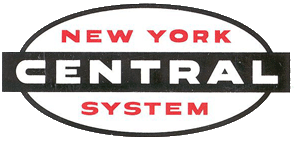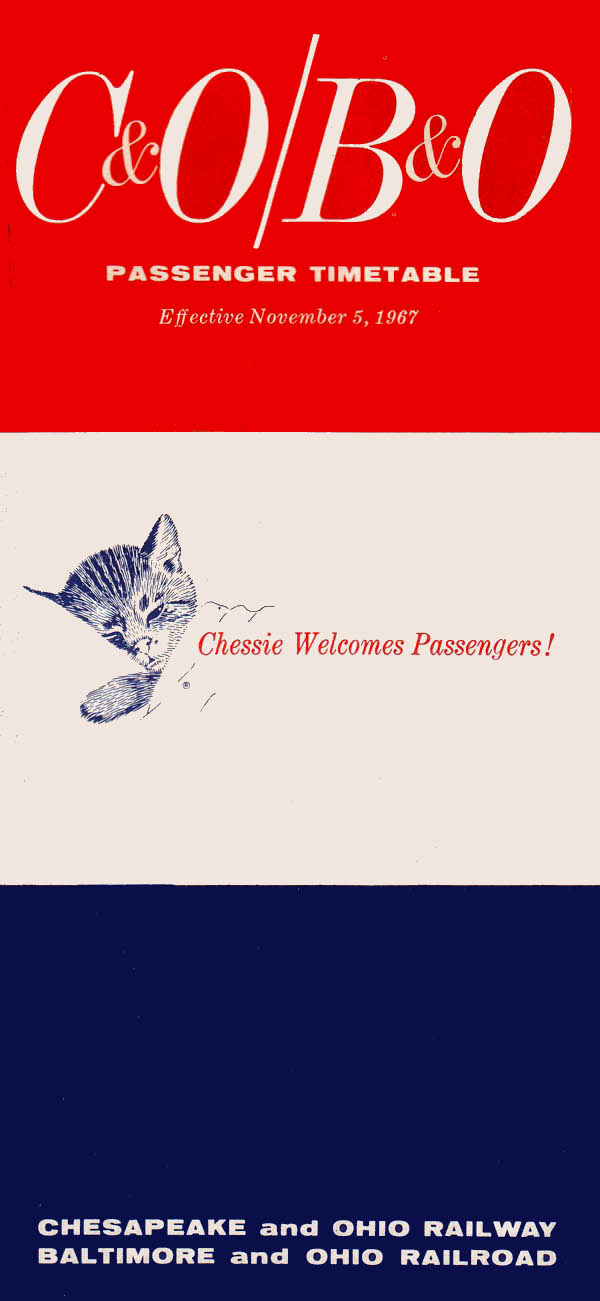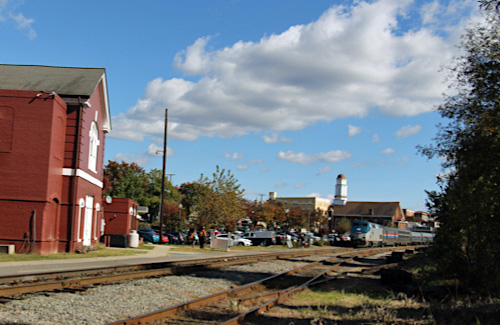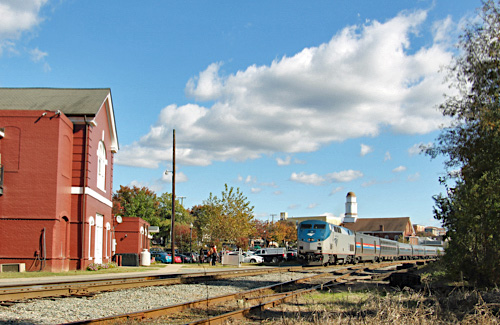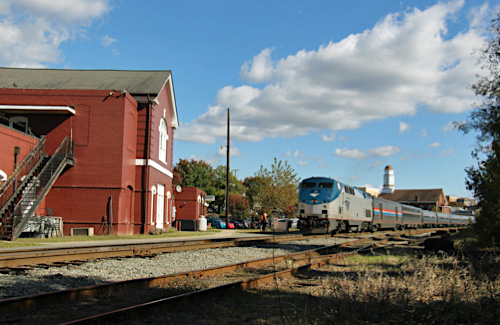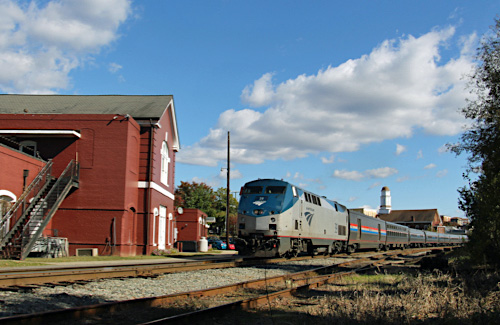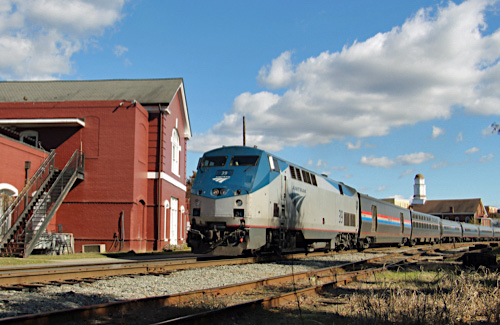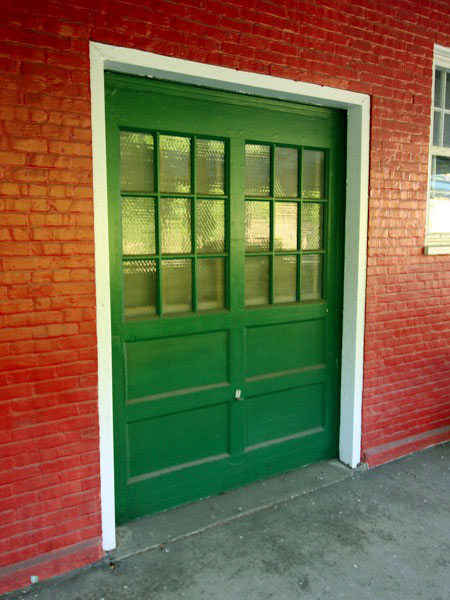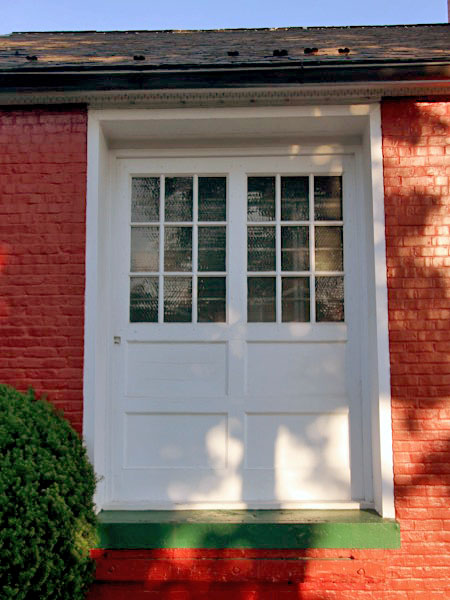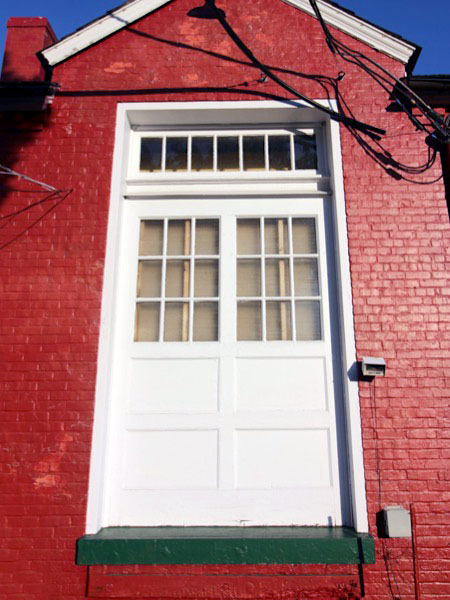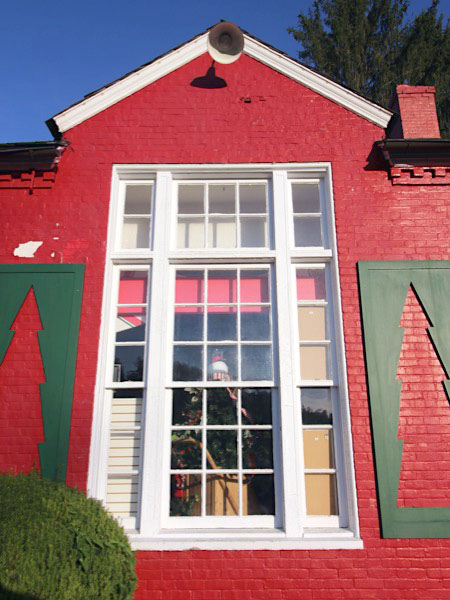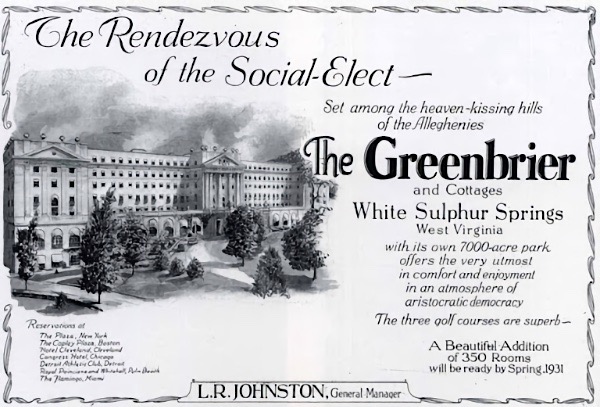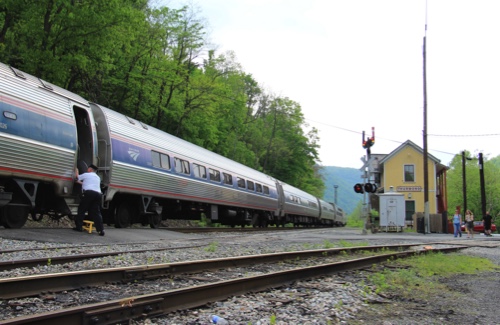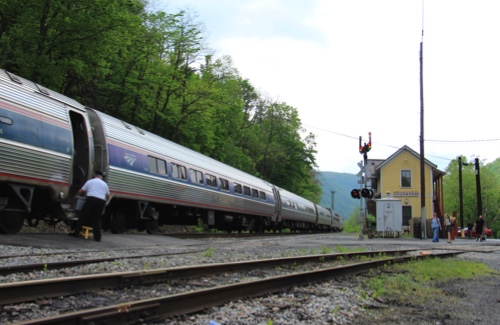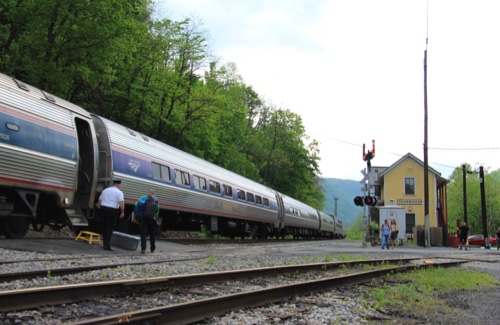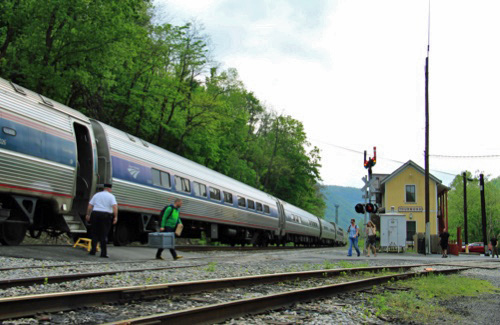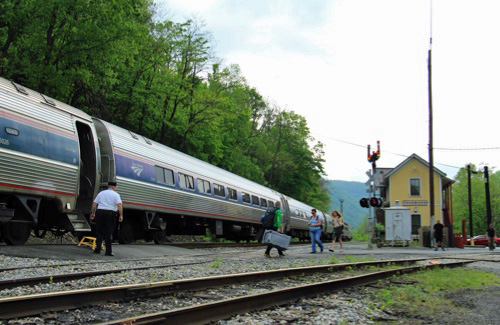

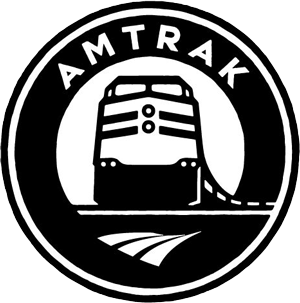
Cardinal
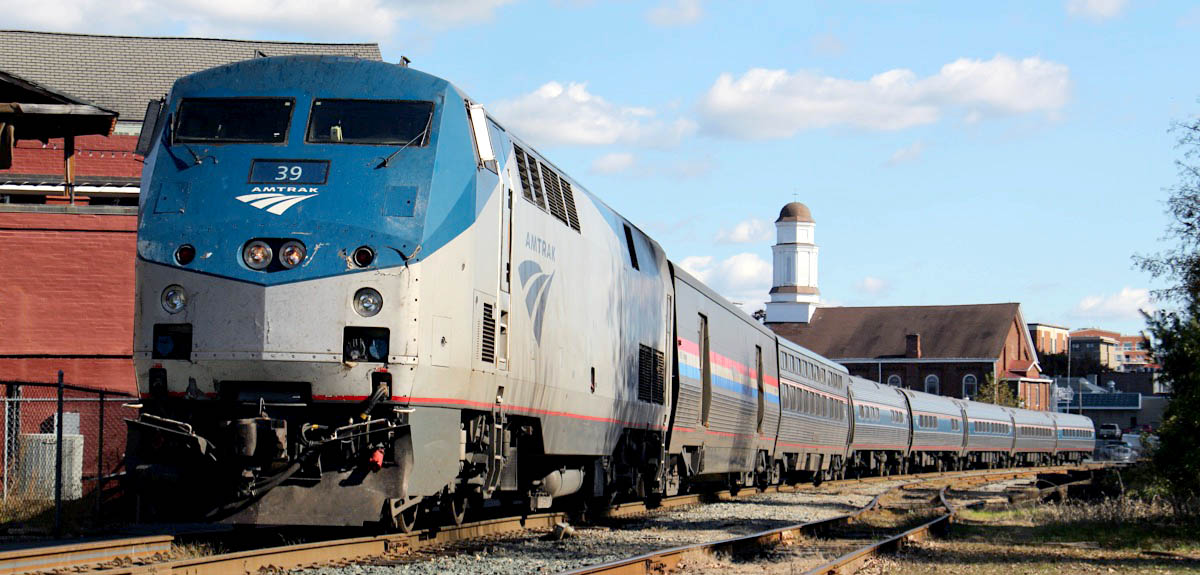
Charlottesville, Va / Nov 2016 / RWH
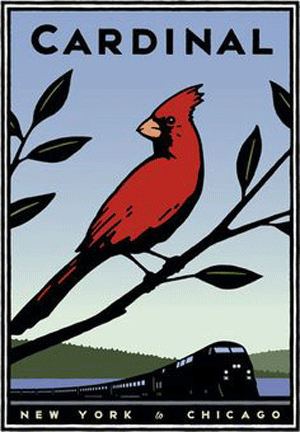
 he Cardinal is a three-times-a-week long distance passenger train operated by Amtrak between New York City's Penn Station and Chicago's Union Station, with major intermediate stops at Philadelphia, Washington, Charlottesville, Charleston, Huntington, Cincinnati, and Indianapolis. Trains depart New York on Sundays, Wednesdays, and Fridays, and alternatively depart Chicago on Tuesdays, Thursdays, and Saturdays. The 1,146-mile trip between these two terminals ordinarily takes 26 hours. One of three current Amtrak routes between the Northeast and Chicago (including the Capital Limited), the Cardinal's routing is the most southern and the least direct — meandering through southern West Virginia and Ohio.
he Cardinal is a three-times-a-week long distance passenger train operated by Amtrak between New York City's Penn Station and Chicago's Union Station, with major intermediate stops at Philadelphia, Washington, Charlottesville, Charleston, Huntington, Cincinnati, and Indianapolis. Trains depart New York on Sundays, Wednesdays, and Fridays, and alternatively depart Chicago on Tuesdays, Thursdays, and Saturdays. The 1,146-mile trip between these two terminals ordinarily takes 26 hours. One of three current Amtrak routes between the Northeast and Chicago (including the Capital Limited), the Cardinal's routing is the most southern and the least direct — meandering through southern West Virginia and Ohio.
The Cardinal is the successor of several previous trains, primarily the New York Central's (later Penn Central) James Whitcomb Riley and the Chesapeake & Ohio's George Washington. The James Whitcomb Riley was a daytime all-coach train which operated between Chicago and Cincinnati, via Indianapolis; while the George Washington was a C&O sleeper consist that ran between Cincinnati, Washington, and Newport News, Virginia. Both routes survived until the formation of Amtrak in 1971. The current Cardinal operates over Amtrak's Northeast Corridor, CSX Transportation, Norfolk Southern, Buckingham Branch Railroad, Canadian National Railway, Union Pacific Railroad, and Metra trackage. The Buckingham Branch segment in Virginia makes the Cardinal one of the few Amtrak trains routed over a shortline railroad. Trains ordinarily use standard single-level Amtrak equipment from the Amfleet and Viewliner rosters, pulled by a single locomotive.
Between the front door of America's Eastern Seaboard, Amtrak's famous Northeast Corridor, and the equally well-known delights of the Windy City, Chicago, lies the gateway to the American South and the unparalleled wonders of the journey westward through America's mid-Atlantic and southeastern heartlands. From twinkling Northeast cityscapes to famous Civil War battlefields; from the Blue Ridge Mountain chain and the Shenandoah Valley to West Virginia's wild and wonderful whitewater rivers; from the fabulous window on geologic history at the New River Gorge to the Kanawha River's thunder into a 1,300-ft. canyon below; from quiet coal mining towns to the beautifully illuminated nighttime skyline of Charleston, the capital city, and on to the great plains and Chicago — the Cardinal takes you on an unforgettable journey through history and adventure.
Amtrak
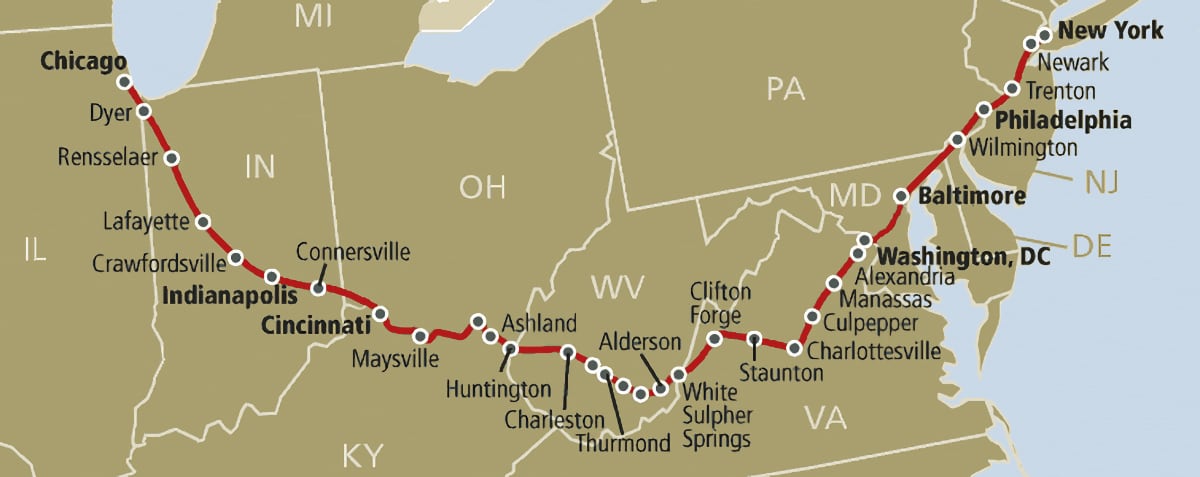
Cardinal route map / web
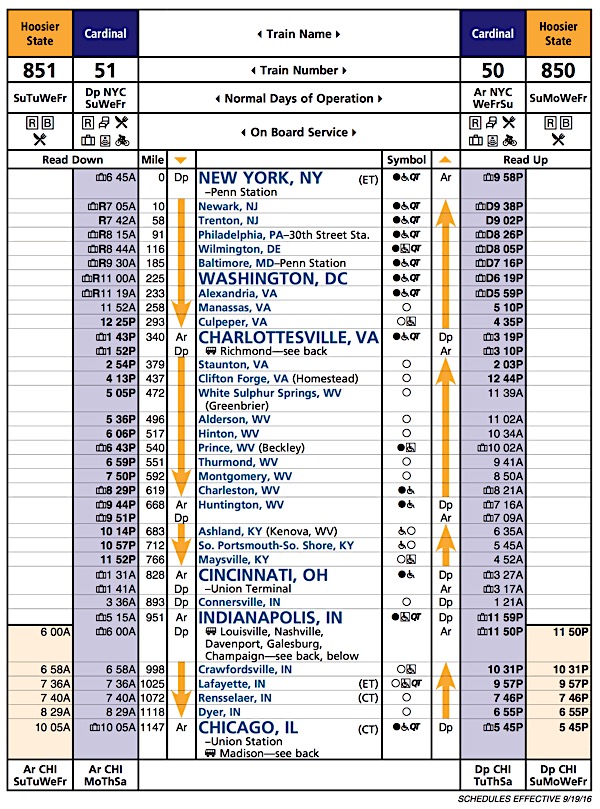
2016 schedule / collection


jump to a
flag stop
- Philadelphia
- Charlottesville
- Staunton
- Clifton Forge
- White Sulphur Springs
- Prince
- Thurmond
- Charleston
- Huntington
- Ashland
- Chicago
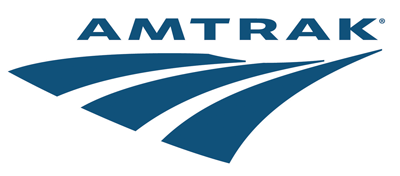

1955 banner / collection
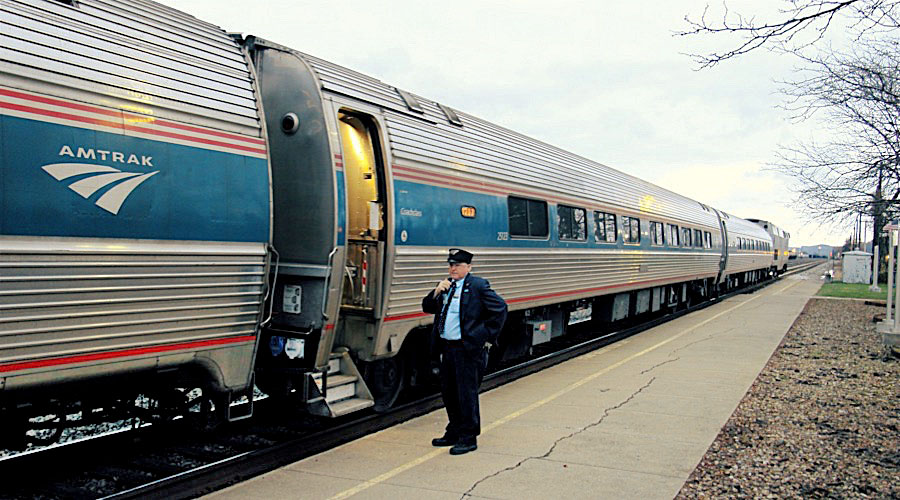
Huntington, WV / Dec 2017 / RWH

 Philadelphia, Pa
Philadelphia, Pa
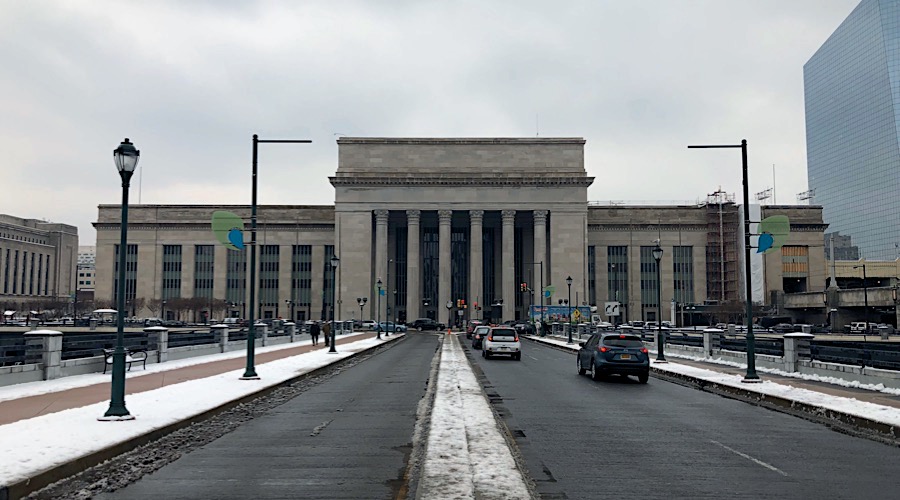
Philadelphia, Pa / Feb 2019 / RWH


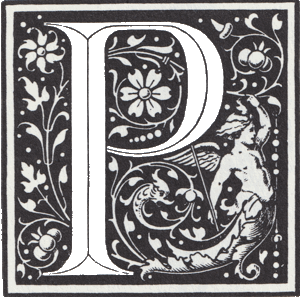 hiladelphia's famed 30th Street Station was built between 1929 and 1933 by the Pennsylvania Railroad (PRR) to replace the Broad Street Station that had become much too congested to support the city's growth. Designed by Alfred Shaw of Graham, Anderson, Probst and White, the enormous, eight-story steel frame building has been listed on the National Register of Historic Places since 1978. It is an example of some of the railroad industry's most monumental construction and is architecturally interesting for its use, adaptation and transformation of the Neoclassical style into a more modern, streamlined Art Deco style. The exterior of the building features typical neoclassical elements such as seventy-one-foot-high Corinthian columns forming impressive porticoes on the east and west facades, rendered in Alabama limestone.
hiladelphia's famed 30th Street Station was built between 1929 and 1933 by the Pennsylvania Railroad (PRR) to replace the Broad Street Station that had become much too congested to support the city's growth. Designed by Alfred Shaw of Graham, Anderson, Probst and White, the enormous, eight-story steel frame building has been listed on the National Register of Historic Places since 1978. It is an example of some of the railroad industry's most monumental construction and is architecturally interesting for its use, adaptation and transformation of the Neoclassical style into a more modern, streamlined Art Deco style. The exterior of the building features typical neoclassical elements such as seventy-one-foot-high Corinthian columns forming impressive porticoes on the east and west facades, rendered in Alabama limestone.
The interior of the station, meanwhile, is notable and unique for both its stylistic and functional elements. The main concourse measures 290 by 135 feet with a 95-foot-high coffered ceiling and beautiful Art Deco chandeliers. It is lined by gilded and ornamented columns that contrast with the more austere, classical look of the façade as well as by five-story-high cathedral-like windows. The floor, made of Tennessee marble, completes the sense of opulence of this impressive room.

Click to see Philadelphia's 30th Street Station plotted on a Google Maps page
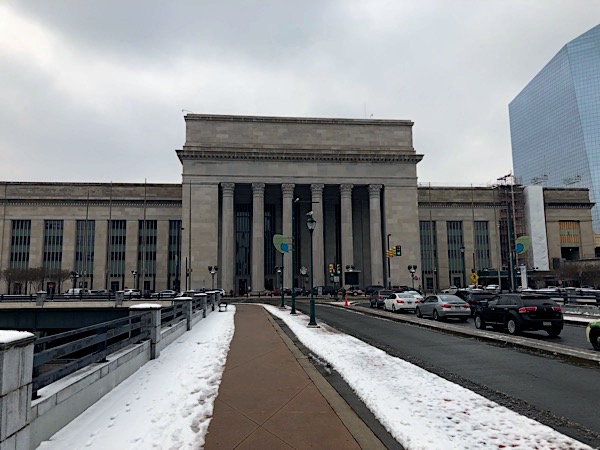
Philadelphia, Pa / Feb 2019 / RWH
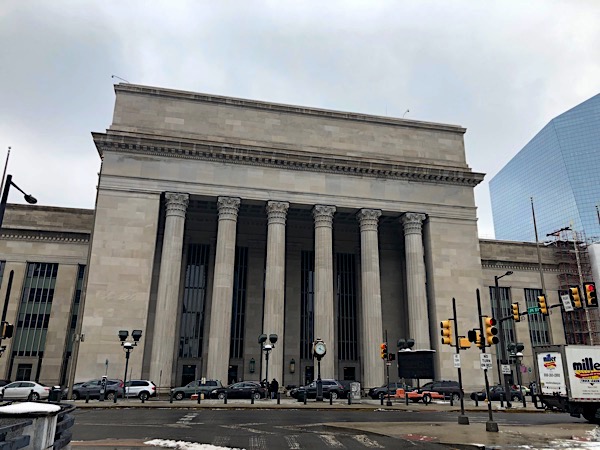
Philadelphia, Pa / Feb 2019 / RWH
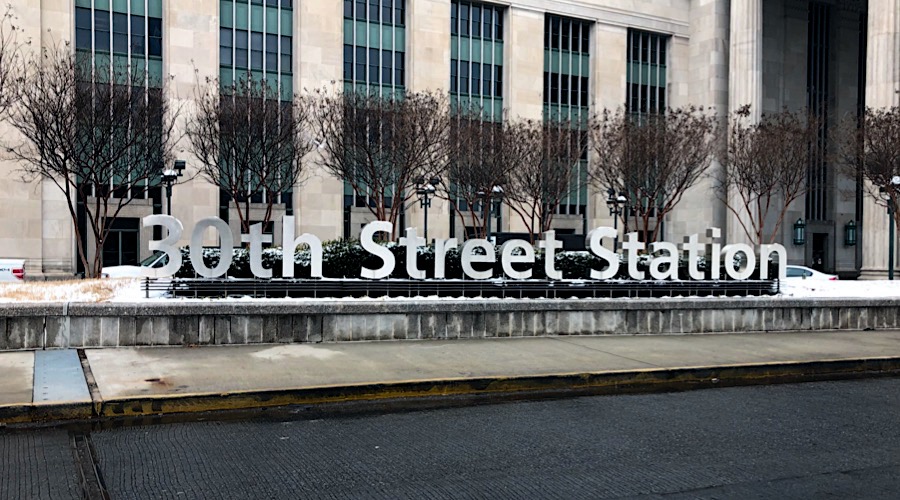
Philadelphia, Pa / Feb 2019 / RWH
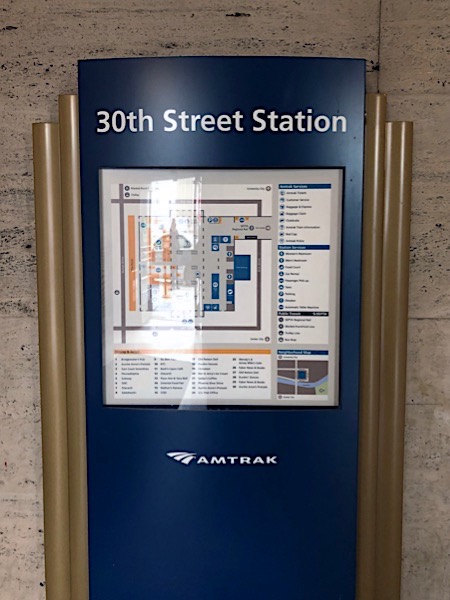
RWH

See also our Amtrak Pennsylvanian route scrapbook for a complete Philadelphia overview
 Charlottesville, Va
Charlottesville, Va

 A Monacan village, Monasukapanough, was the first human settlement on these lands. What started as a Monacan hunting path grew into Three Notch'd Road, a trade route used by European settlers to shuttle goods between Richmond and the Appalachian Mountains. Today we call this Monacan hunting path U.S. Route 250. Without it, Charlottesville would not have become what it is today.
A Monacan village, Monasukapanough, was the first human settlement on these lands. What started as a Monacan hunting path grew into Three Notch'd Road, a trade route used by European settlers to shuttle goods between Richmond and the Appalachian Mountains. Today we call this Monacan hunting path U.S. Route 250. Without it, Charlottesville would not have become what it is today.
One of the first men to build upon this early infrastructure was Thomas Jefferson. Jefferson is undeniably the most famous figure in local history. He founded the University of Virginia down the mountain from Monticello, his mountaintop plantation. He inherited this mountaintop land, some 5,000 acres, from his father at the age of 26. He then used the labor of enslaved Africans to cultivate tobacco and construct the plantation house. Albemarle County was home to James Monroe too. Monroe, like Jefferson, also went on to become a U.S. president. James Madison lived just 26 miles northeast of Charlottesville, so we like to claim him too. Jefferson and Monroe, however, were practically next-door neighbors.
In 1850, Charlottesville welcomed its first railroad service, a technology that would later dramatically expand shipping through the area and bring more growth. Then, like any community in the South, the area lost many of its sons and brothers to the Civil War. Unlike many communities, however, the town itself was left largely unscathed--despite its central role in the manufacturing of Confederate uniforms. By 1887, the city had received its first horse drawn streetcars and kept an extra horse on hand to help cars climbing Vinegar Hill, a rough stretch of Main Street. In 1888, Charlottesville incorporated and annexed surrounding land to create a city of nearly 800 acres.

Charlottesville, Va / Nov 2016 / RWH
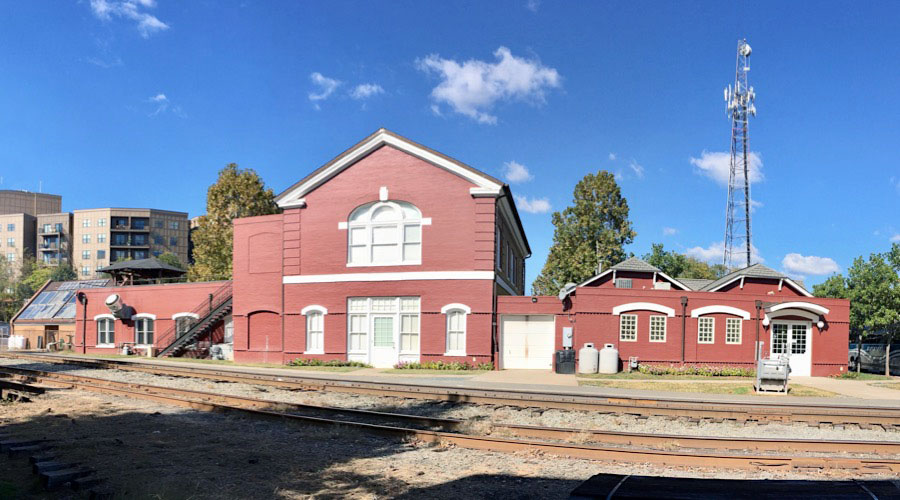
Charlottesville, Va / Nov 2016 / RWH

Click to see the Charlottesville station area plotted on a Google Maps page
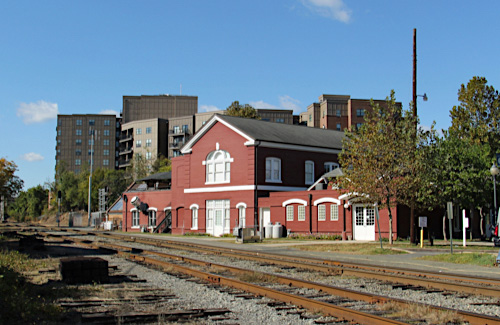
Charlottesville, Va / Nov 2016 / RWH
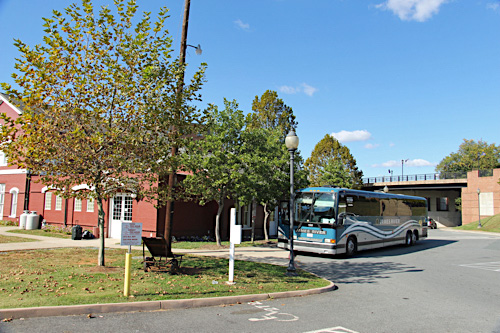
Charlottesville, Va / Nov 2016 / RWH
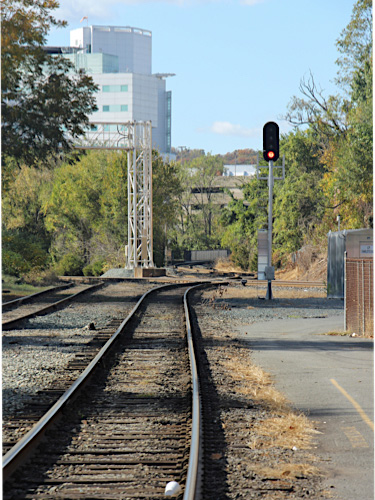
Charlottesville, Va / Nov 2016 / RWH
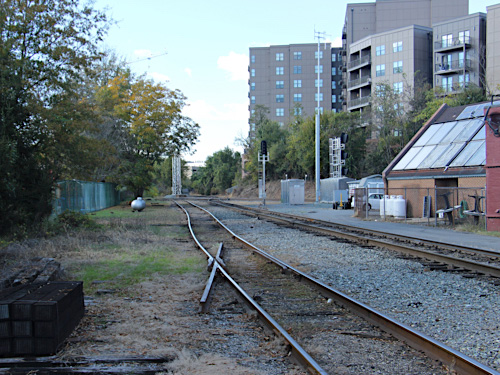
Charlottesville, Va / Nov 2016 / RWH
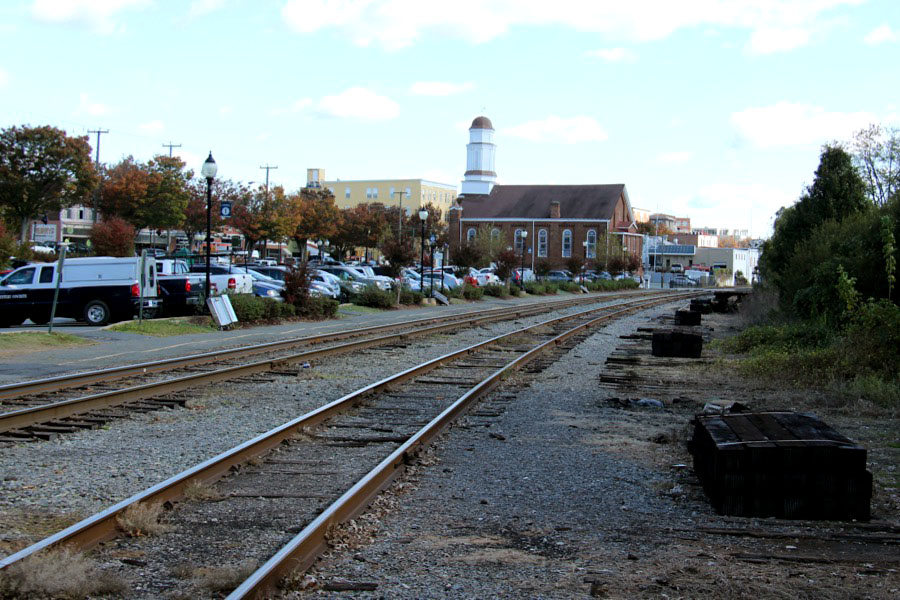
Charlottesville, Va / Nov 2016 / RWH

Charlottesville, Va / Nov 2016 / RWH

Charlottesville, Va / Nov 2016 / RWH
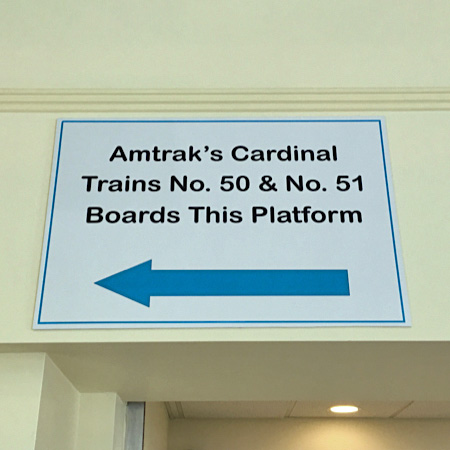
Charlottesville, Va / Nov 2016 / RWH

Charlottesville, Va / Nov 2016 / RWH
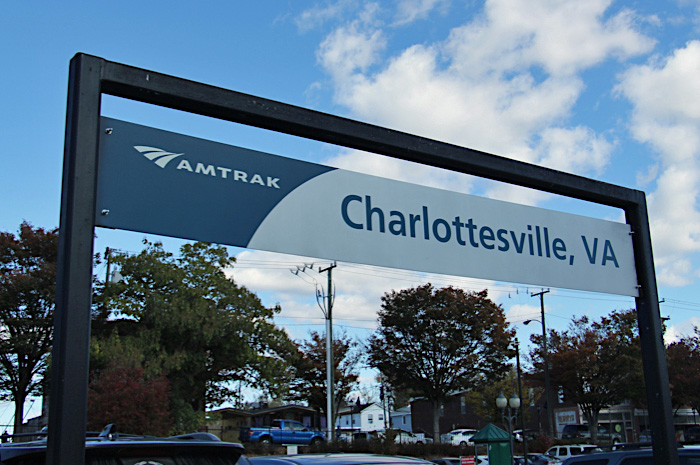
Charlottesville, Va / Nov 2016 / RWH
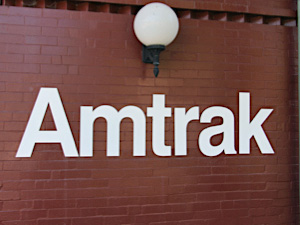


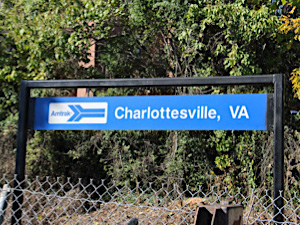
Nov 2016 / RWH
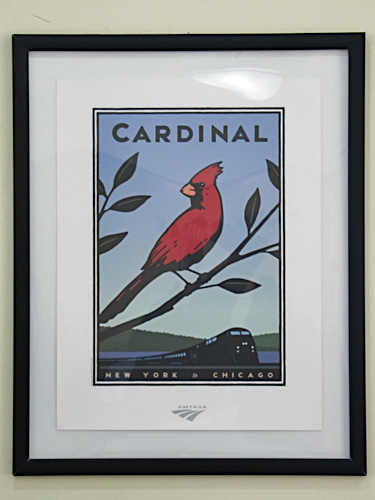
Nov 2016 / RWH
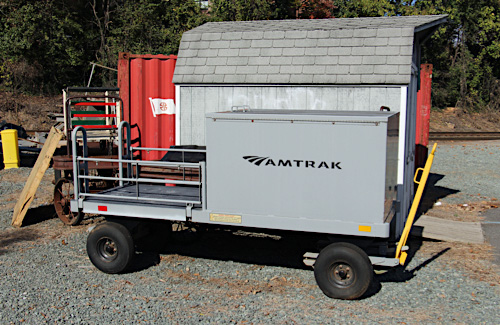
Nov 2016 / RWH
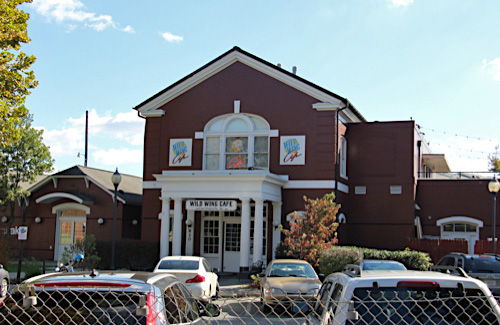
Charlottesville, Va / Nov 2016 / RWH
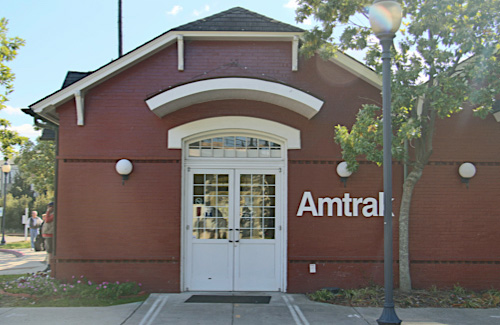
Charlottesville, Va / Nov 2016 / RWH
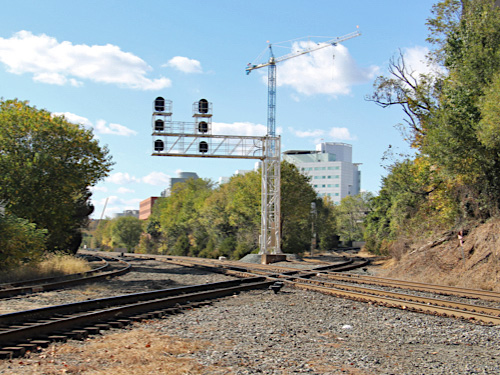
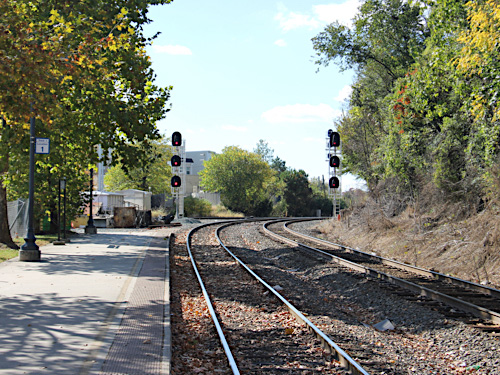
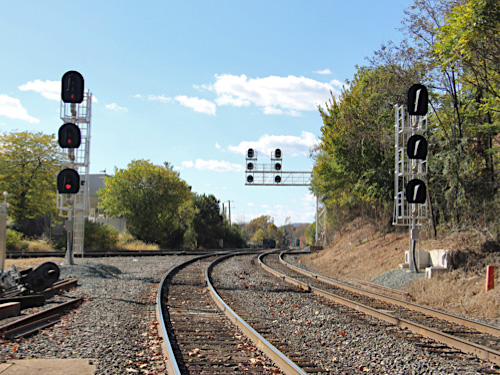
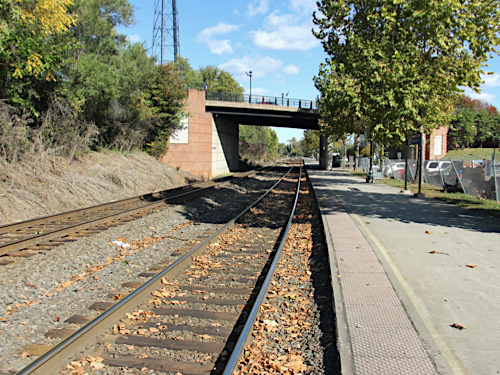
Charlottesville, Va / Nov 2016 / RWH

 Charlottesville’s Union Station was constructed in 1885 and sits between the University of Virginia and downtown Charlottesville. In 1999, Amtrak and the city of Charlottesville dedicated the newly renovated depot following a $700,000 effort. Amtrak moved out of the original station and into the former Railway Express Agency building built in the 1890s. The new facility has a more modern waiting area, ticket counter and restroom, as well as better parking lot access and the addition of a full-service restaurant. One of the unique features of this station is that its two trains serve the station on two separate tracks on either side of the station. The lines cross just south of the building.
Charlottesville’s Union Station was constructed in 1885 and sits between the University of Virginia and downtown Charlottesville. In 1999, Amtrak and the city of Charlottesville dedicated the newly renovated depot following a $700,000 effort. Amtrak moved out of the original station and into the former Railway Express Agency building built in the 1890s. The new facility has a more modern waiting area, ticket counter and restroom, as well as better parking lot access and the addition of a full-service restaurant. One of the unique features of this station is that its two trains serve the station on two separate tracks on either side of the station. The lines cross just south of the building.
Prior to this station’s construction, Charlottesville was a major rail hub, served by many trains daily. The first train service to Charlottesville was operated by the Louisa Railroad Company, which later became the Central Virginia Railroad (later Chesapeake & Ohio, now CSX). In the mid 1880s, Virginia Midland Railroad (later Southern Railway, now Norfolk Southern) created a perpendicular north-south route. This produced competition between the two rail companies and strengthened the local economy. Hotels and restaurants went up along West Main Street for the many new railroad workers, including those at a railcar repair shop.
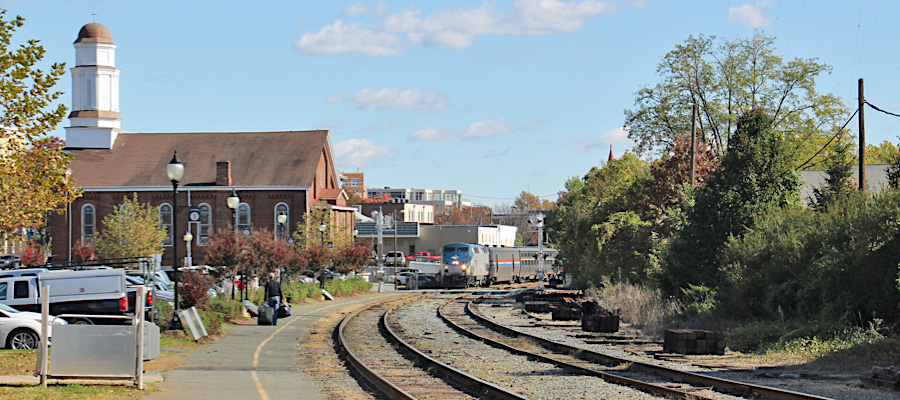
Charlottesville, Va / Nov 2016 / RWH
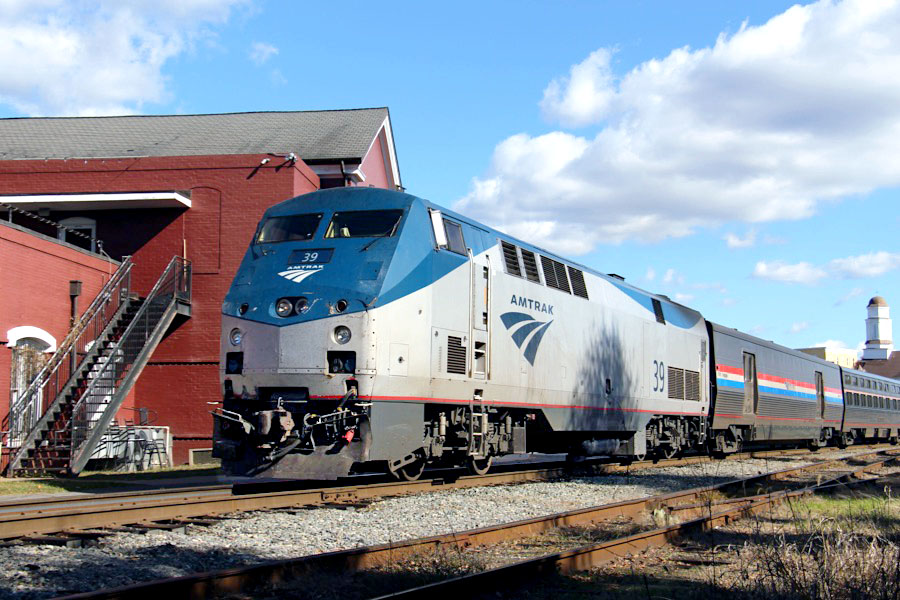
Charlottesville, Va / Nov 2016 / RWH
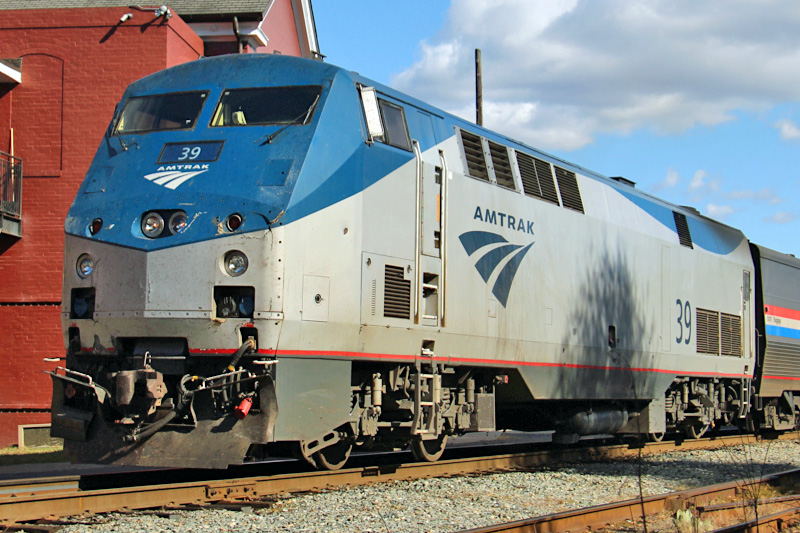
Amtrak #39
Charlottesville, Va / Nov 2016 / RWH


Amtrak #39
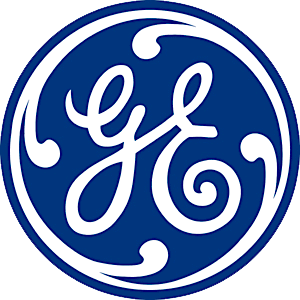
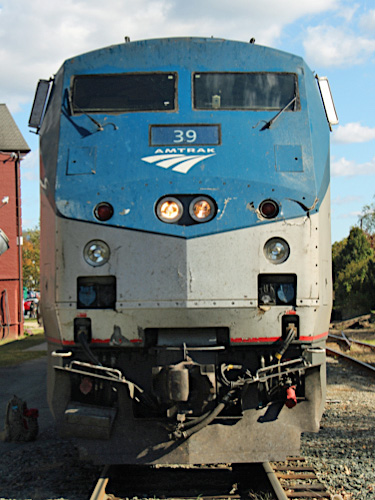
Nov 2016 / RWH
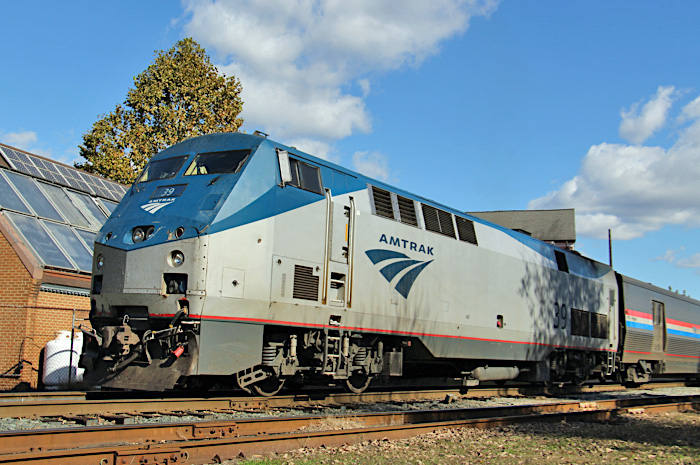
Charlottesville, Va / Nov 2016 / RWH

Charlottesville, Va / Nov 2016 / RWH
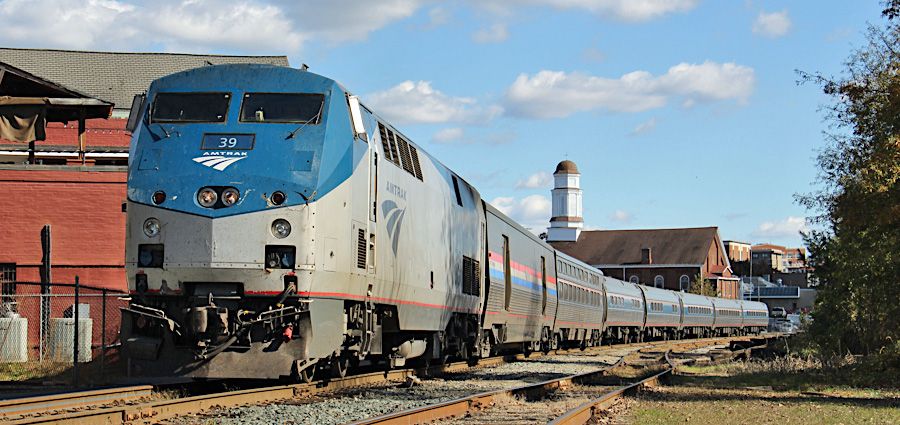
Charlottesville, Va / Nov 2016 / RWH
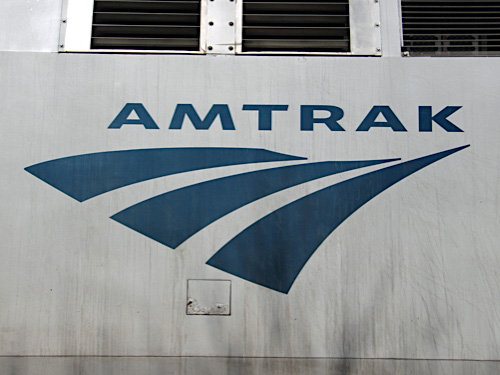
RWH
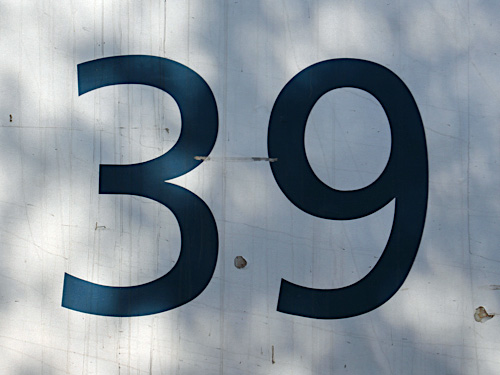
RWH
 Amtrak #51 consist - November 4, 2016
Amtrak #51 consist - November 4, 2016
Amtrak #39
General Electric P42DC
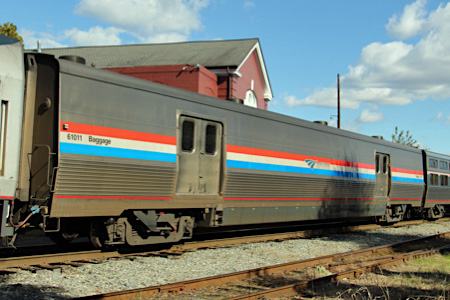
Amtrak #61011
baggage
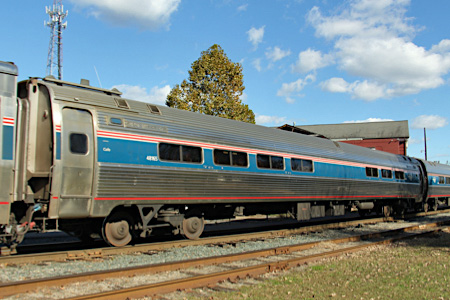
Amtrak #48165
cafe
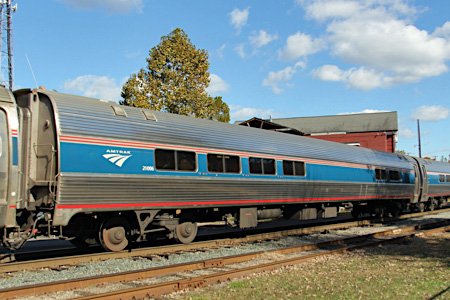
Amtrak #28006
diner
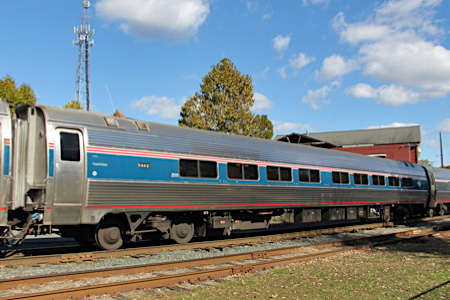
Amtrak #25111
coach
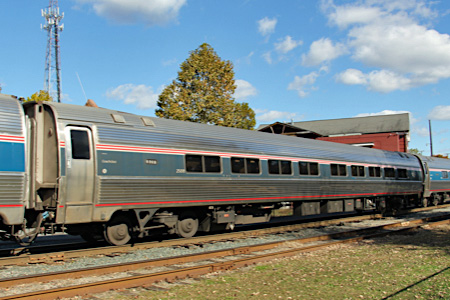
Amtrak #25011
coach
all photos Charlottesville, Va / Nov 2016 / RWH
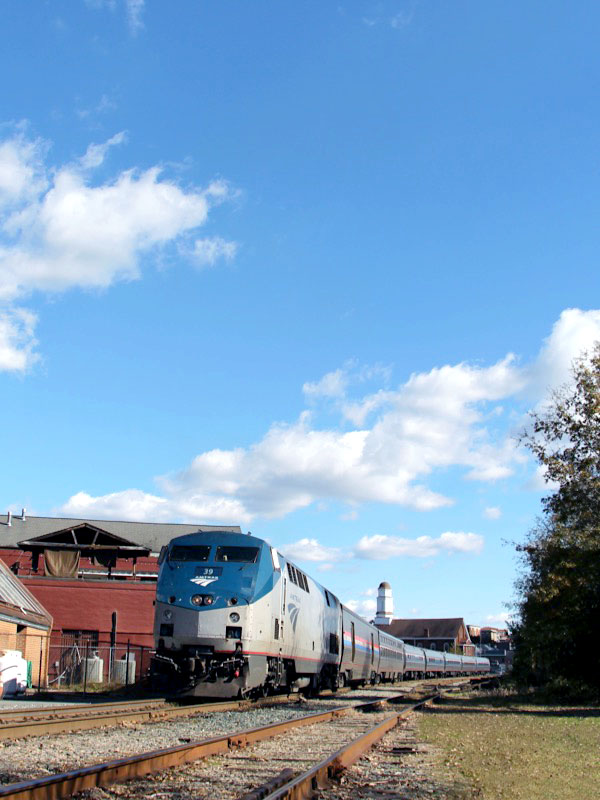
Charlottesville, Va / Nov 2016 / RWH
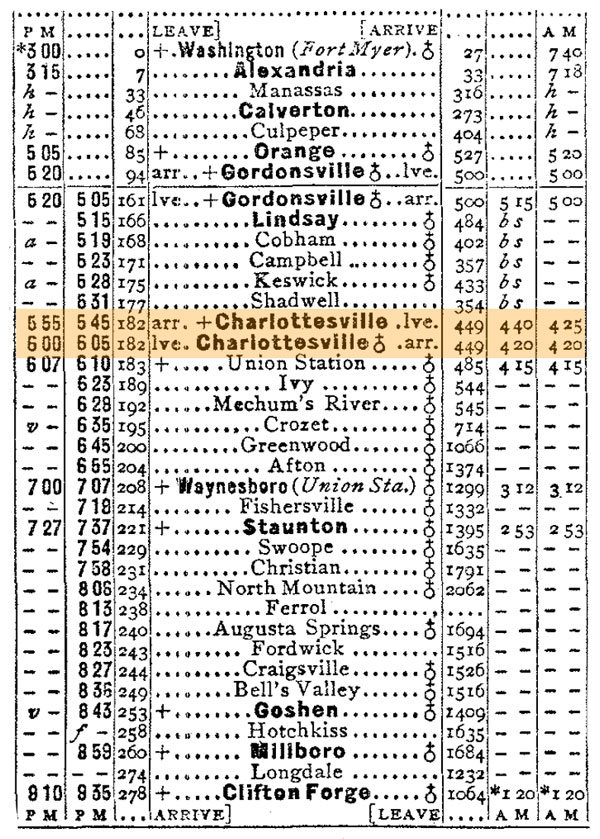
1930 Official Guide ad / collection
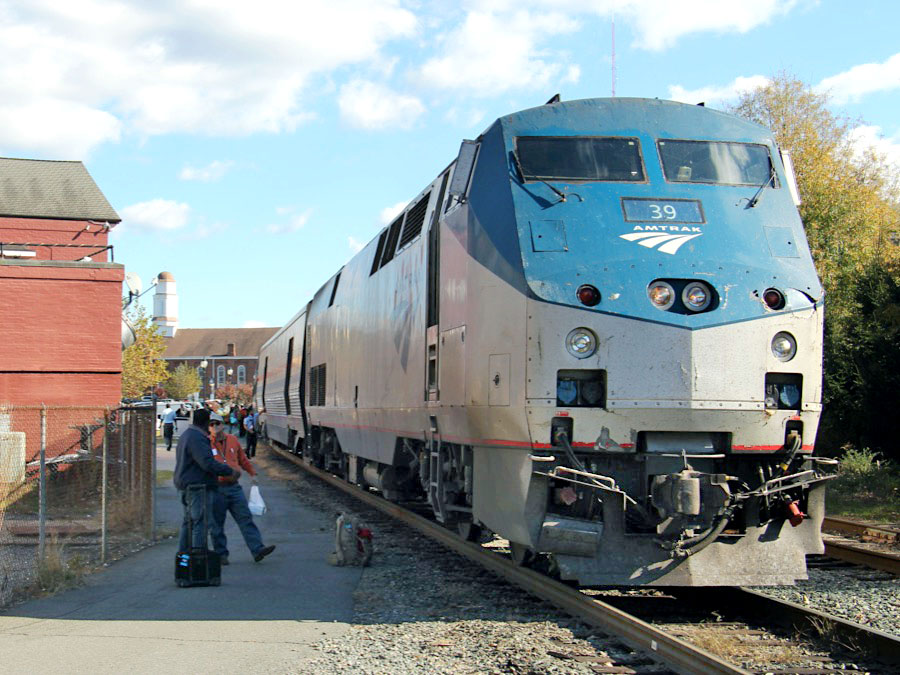
Charlottesville, Va / Nov 2016 / RWH
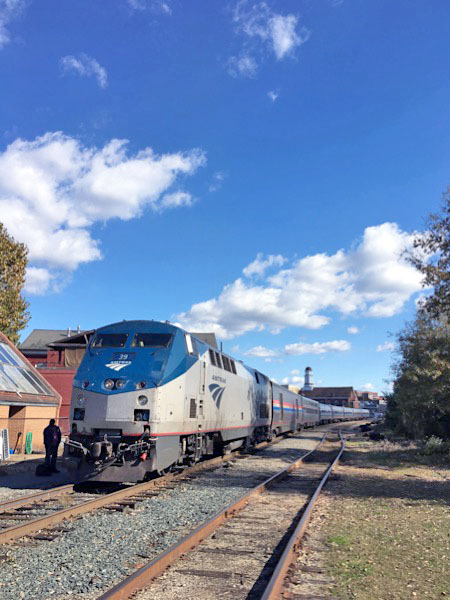
Nov 2016 / RWH
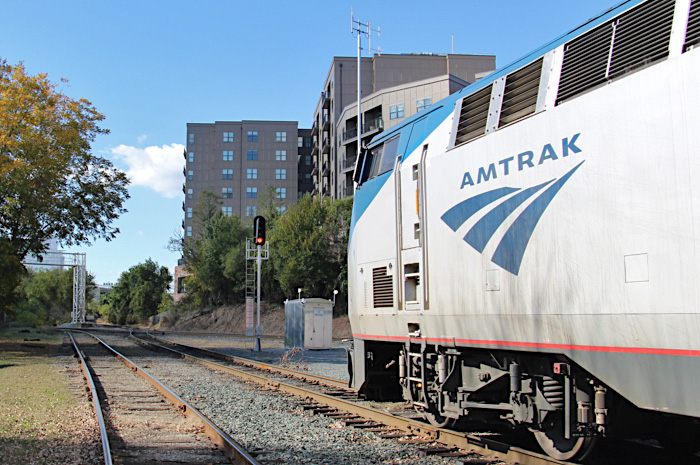
Charlottesville, Va / Nov 2016 / RWH
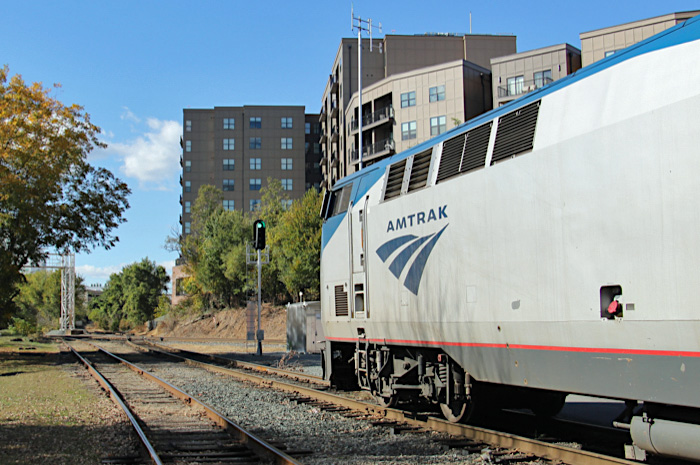
Charlottesville, Va / Nov 2016 / RWH
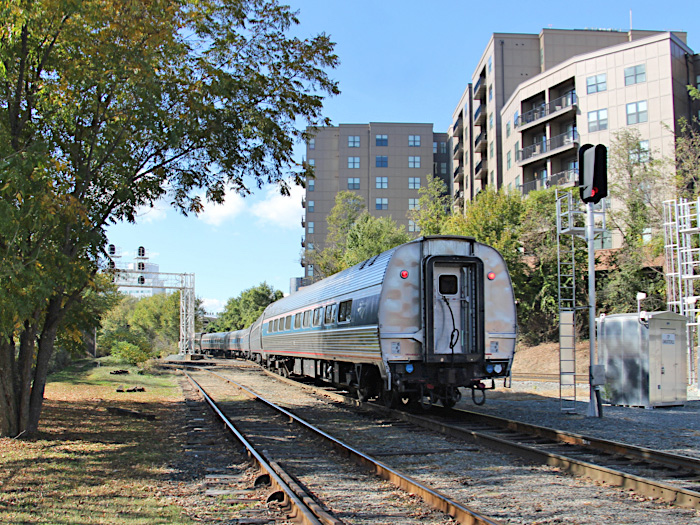
Charlottesville, Va / Nov 2016 / RWH
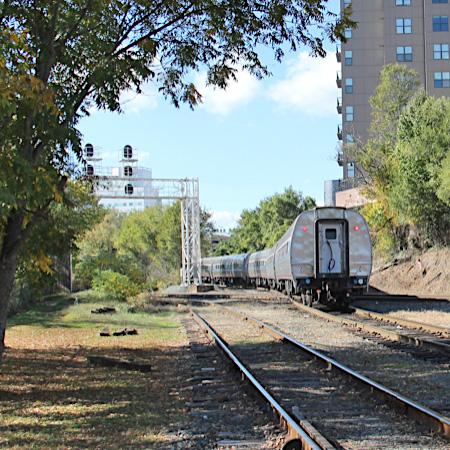
Charlottesville, Va / Nov 2016 / RWH
 Staunton, Va
Staunton, Va
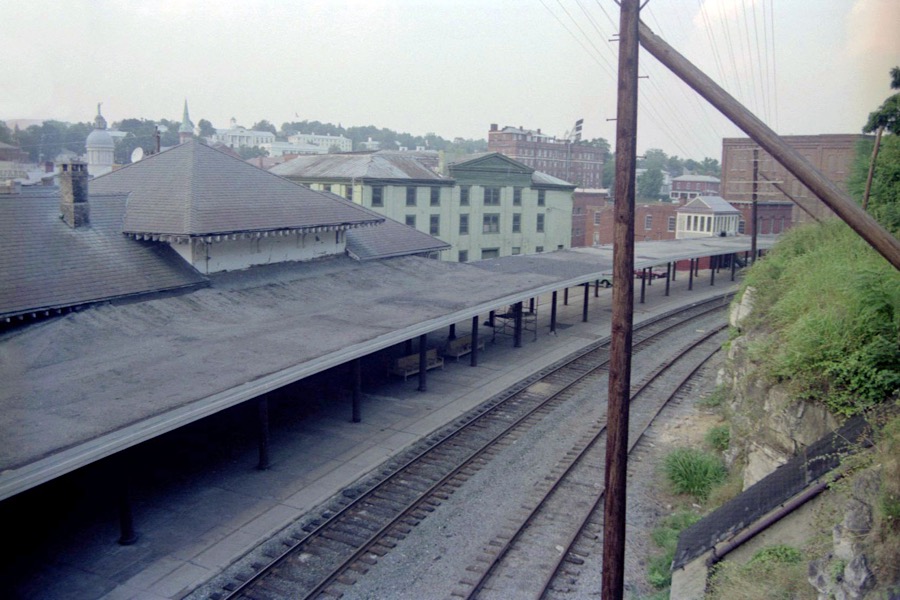
Staunton, Va / Aug 1989 / JCH

Click to see the Staunton station area plotted on a Google Maps page
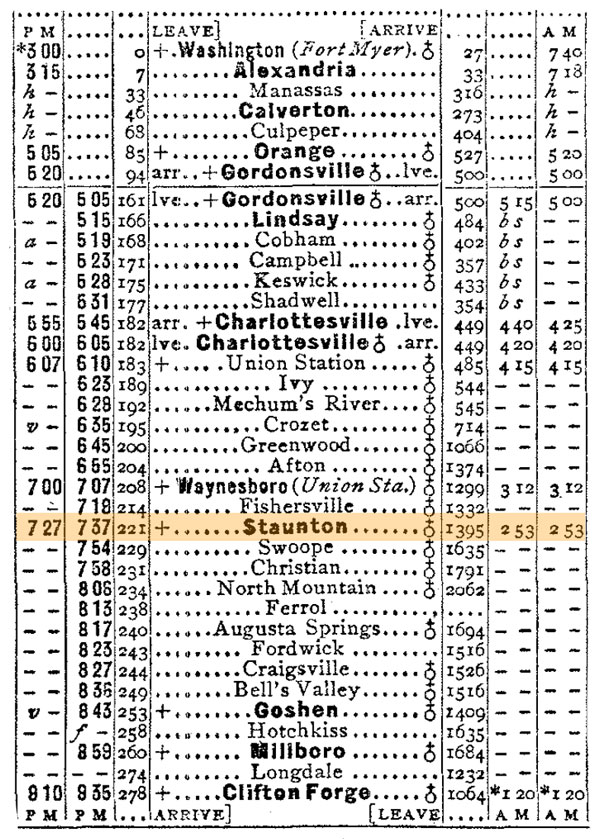
1930 Official Guide ad / collection
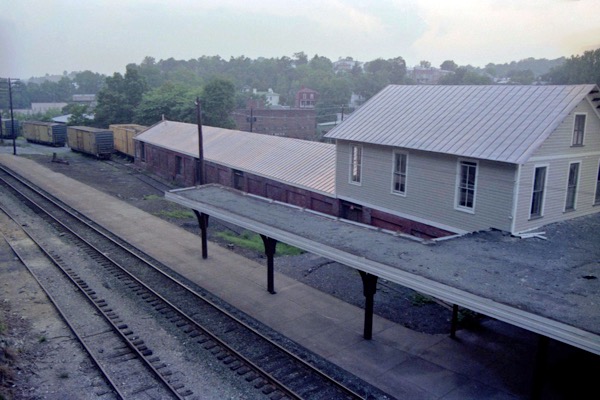
Staunton, Va / Aug 1989 / JCH
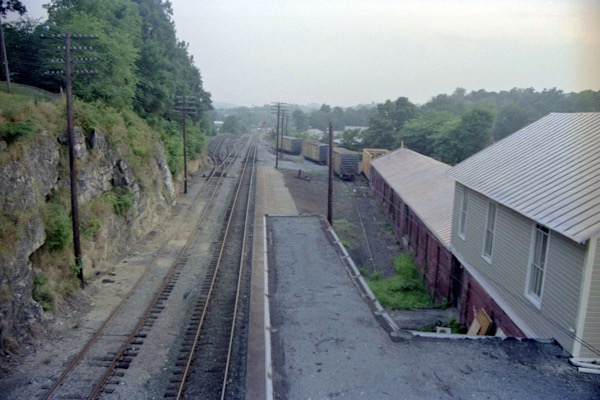
Staunton, Va / Aug 1989 / JCH
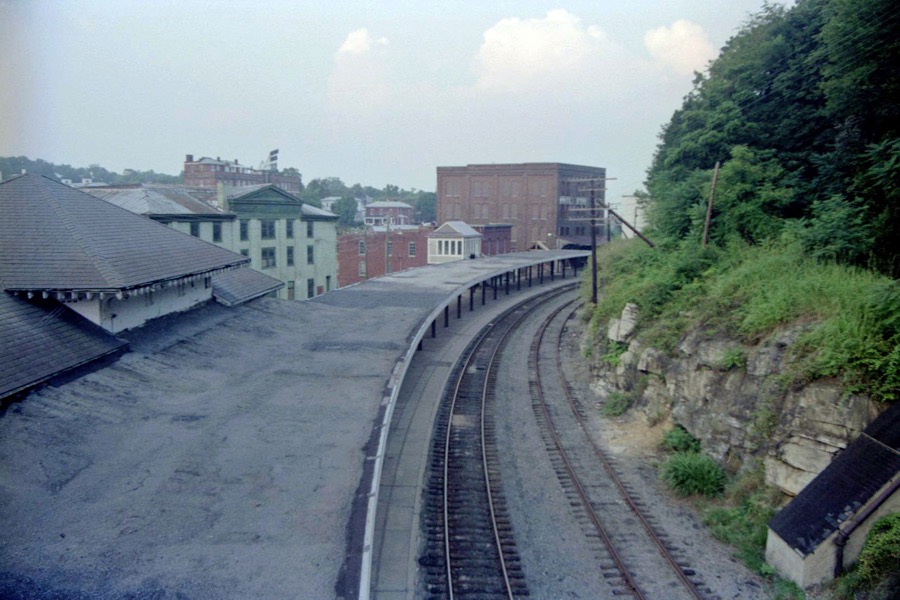
Staunton, Va / Aug 1989 / JCH
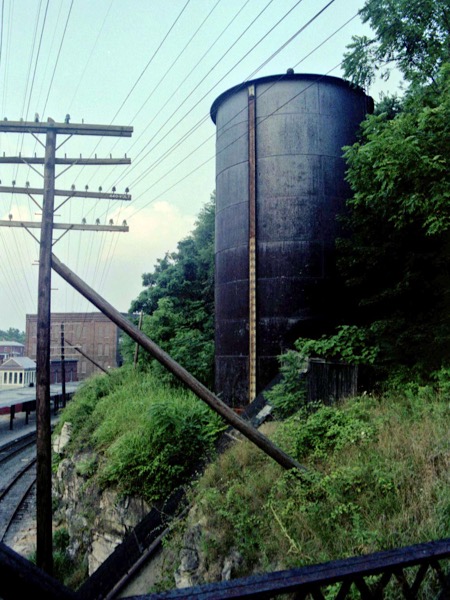
Aug 1989 / JCH
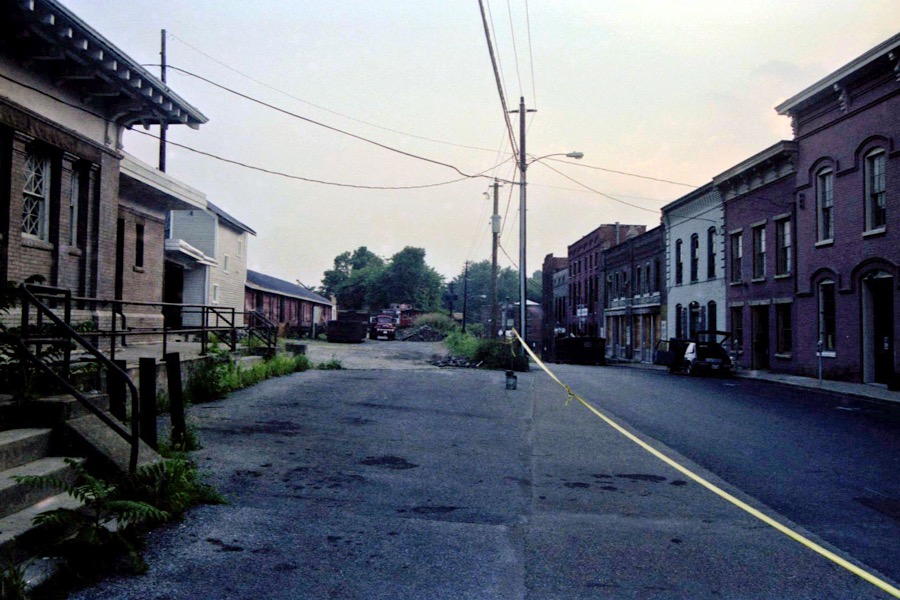
Staunton, Va / Aug 1989 / JCH
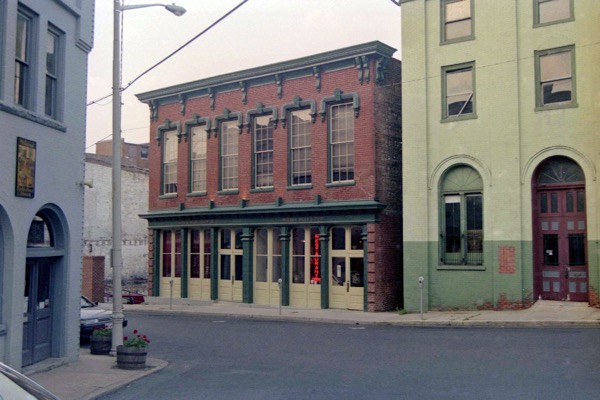
Staunton, Va / Aug 1989 / JCH

Staunton, Va / Aug 1989 / JCH

See also our Buckingham Branch Railroad scrapbook in Shortlines
 Clifton Forge, Va
Clifton Forge, Va

collection
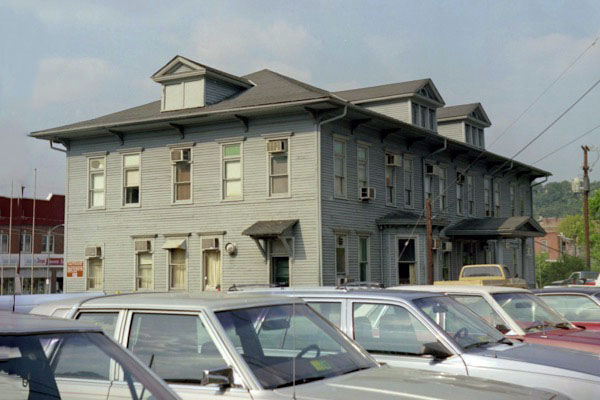
Clifton Forge, Va / Aug 1989 / JCH
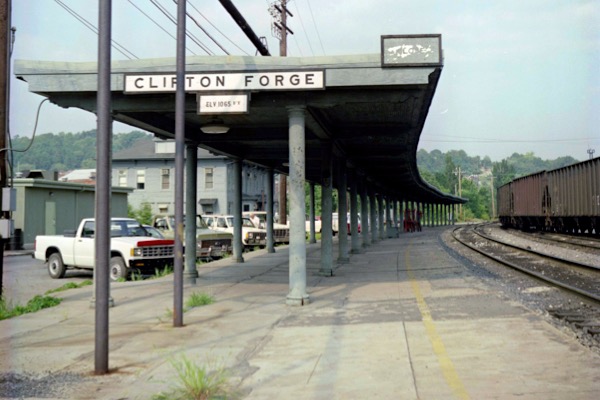
Clifton Forge, Va / Aug 1989 / JCH
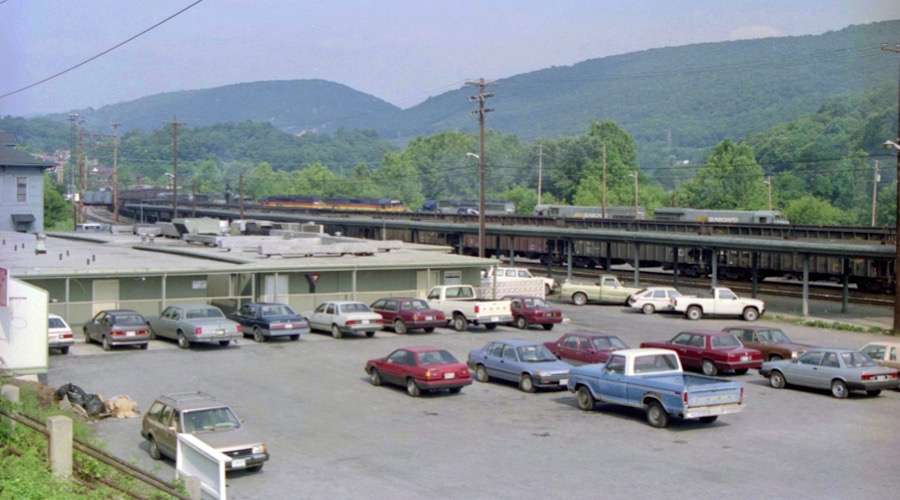
Clifton Forge, Va / Aug 1989 / RWH

Click to see the Clifton Forge depot and yard area plotted on a Google Maps page

1930 Official Guide ad / collection
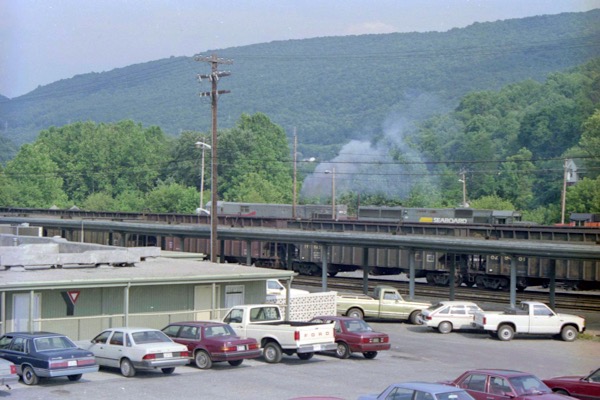
Clifton Forge, Va / Aug 1989 / RWH
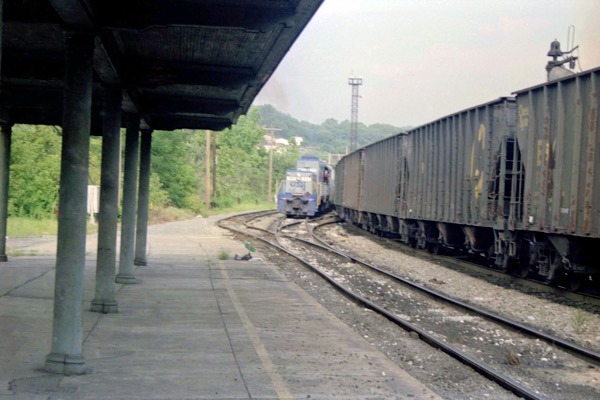
Clifton Forge, Va / Aug 1989 / JCH

Clifton Forge, Va / Aug 1989 / RWH

Clifton Forge, Va / Aug 1989 / RWH
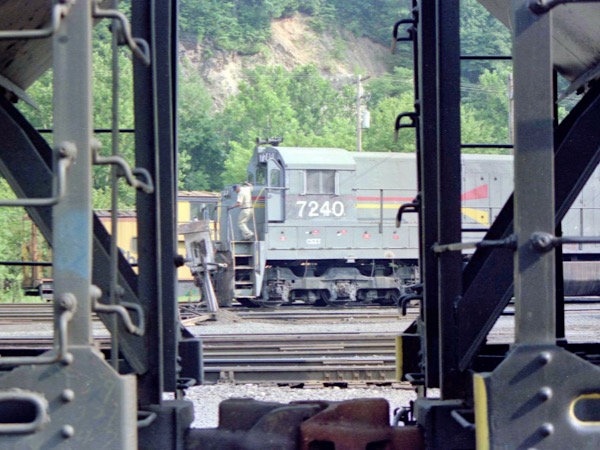
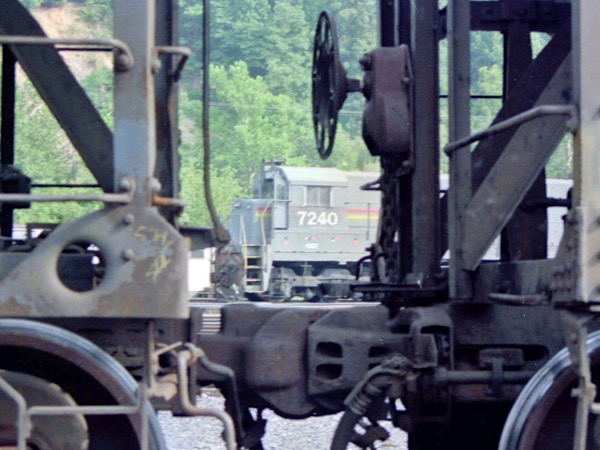


Clifton Forge, Va / Aug 1989 / RWH
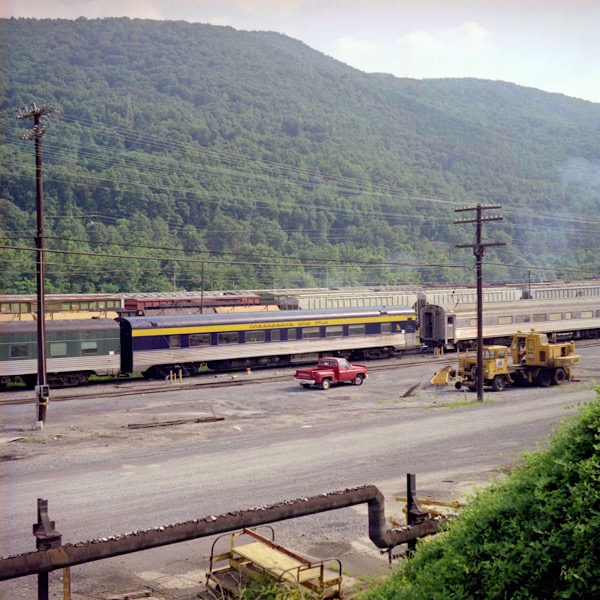
Clifton Forge, Va / Aug 1989 / JCH
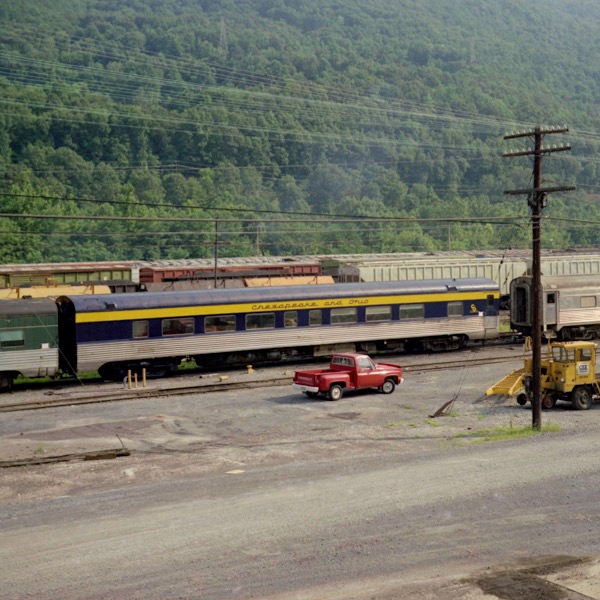
Clifton Forge, Va / Aug 1989 / JCH
 Covington, Va
Covington, Va
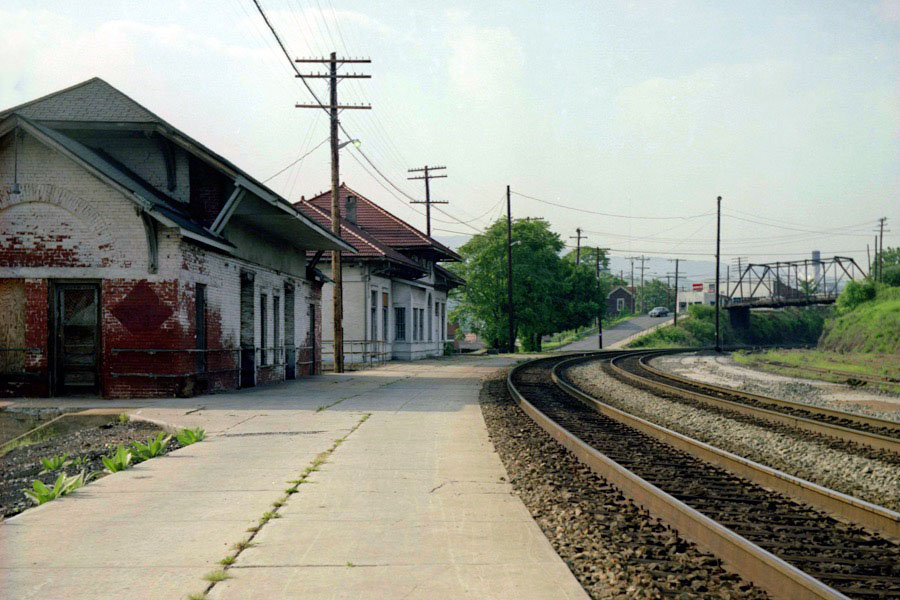
Covington, Va / Aug 1989 / JCH
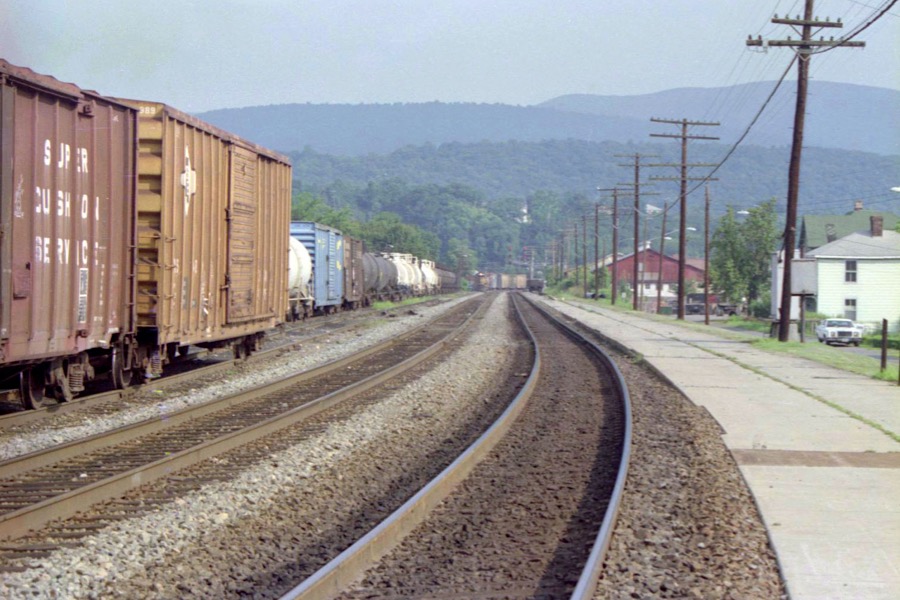
Covington, Va / Aug 1989 / RWH
 White Sulphur Springs, WV
White Sulphur Springs, WV
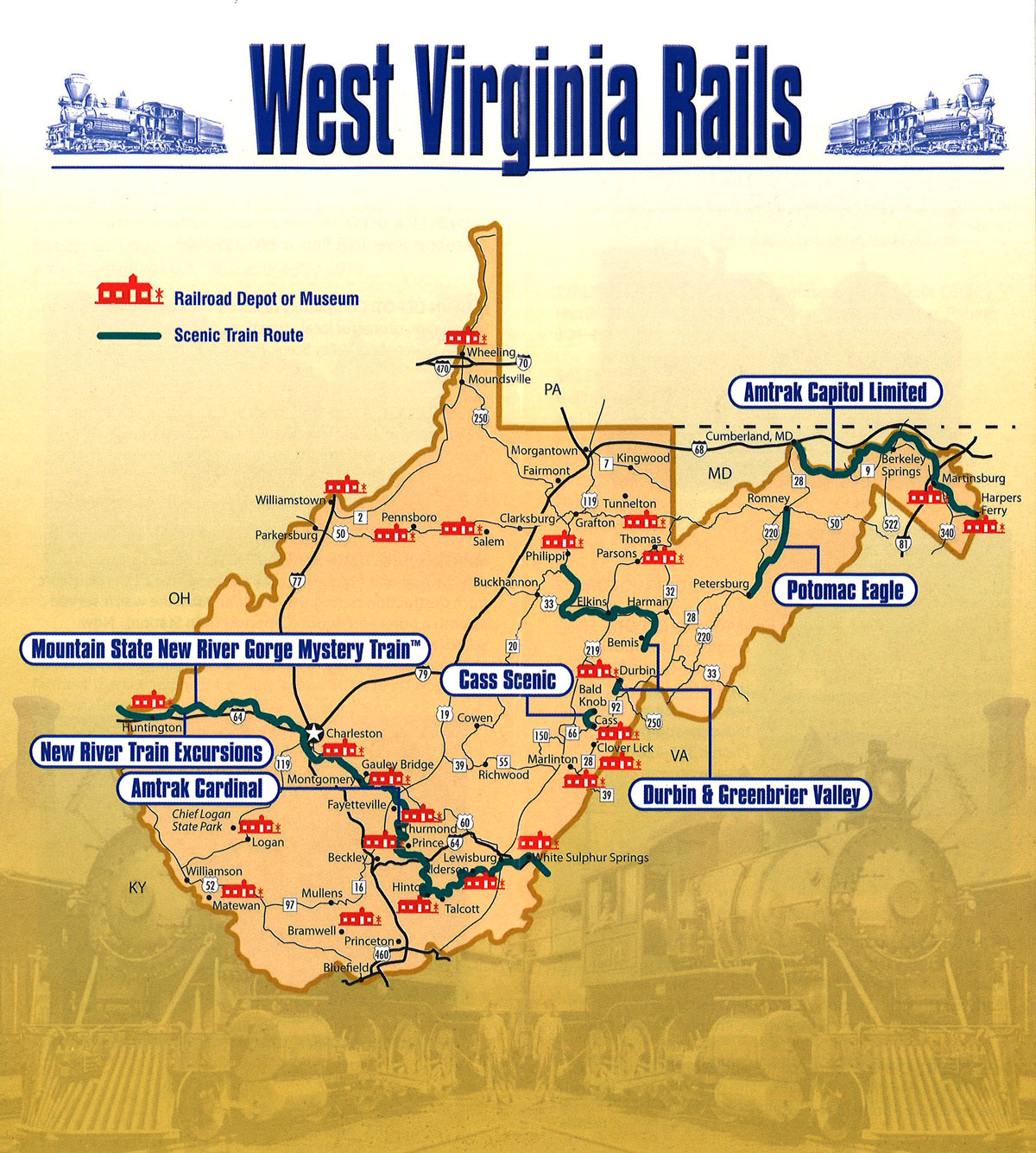
collection

White Sulphur Springs, WV / Jun 2022 / RWH

Click to see the White Sulphur Springs depot area plotted on a Google Maps page
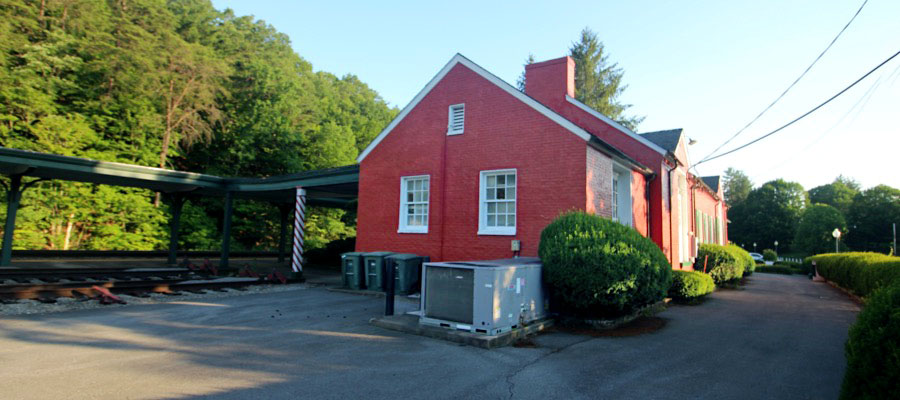
White Sulphur Springs, WV / Jun 2022 / RWH

White Sulphur Springs, WV / Jun 2022 / RWH
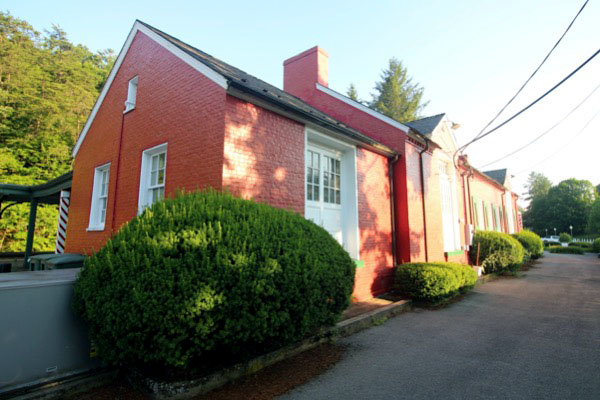
White Sulphur Springs, WV / Jun 2022 / RWH

White Sulphur Springs, WV / Jun 2022 / RWH

Amtrak passengers in White Sulphur Springs only use the platform, which is covered by a canopy. The adjacent brick Colonial Revival style depot was built for the Chesapeake & Ohio Railway (C&O) around 1931 and was intended to replace an older wooden building from the early 1900s. The earlier structure had been constructed as part of a larger C&O effort to repair and maintain many of its aging passenger stations and to serve the historic Greenbrier resort, located directly across West Main Street.
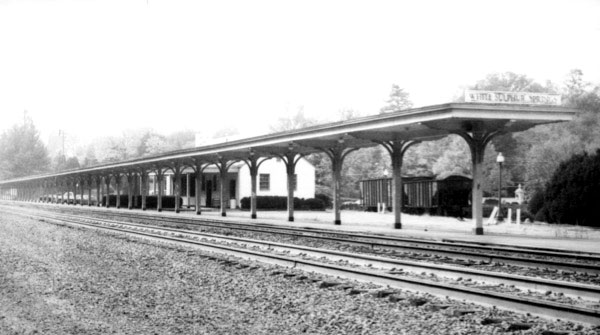 Control of the station passed to the Greenbrier in the 1980s to 1990s, and the resort converted the building to a Christmas store and gift shop. It is still decorated as such, with a red exterior with white accents. The entrance features a portico supported by pillars with red and white “candy cane” striping. This year-round holiday décor gives this station one of the most distinctive looks in the Amtrak national system.
Control of the station passed to the Greenbrier in the 1980s to 1990s, and the resort converted the building to a Christmas store and gift shop. It is still decorated as such, with a red exterior with white accents. The entrance features a portico supported by pillars with red and white “candy cane” striping. This year-round holiday décor gives this station one of the most distinctive looks in the Amtrak national system.
What is now the Greenbrier and White Sulphur Springs were one and the same for the first 125 years. The spring of sulphur water that remains at the center of the resort property issues forth below the green dome of the white-columned Springhouse that has been the symbol of the Greenbrier for generations. Since 1778, people have come to “take the waters” to restore their health.

Jun 2022 / RWH
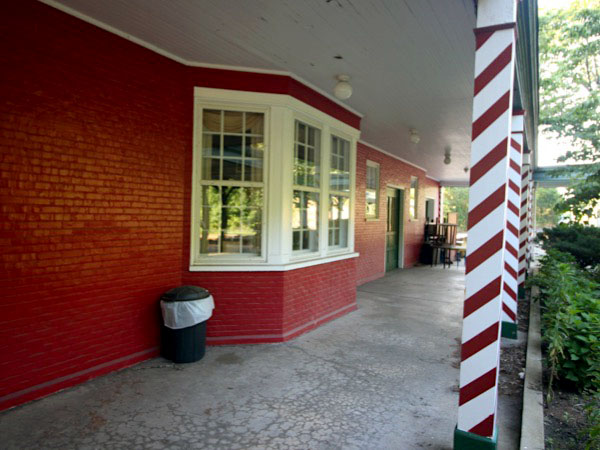
White Sulphur Springs, WV / Jun 2022 / RWH
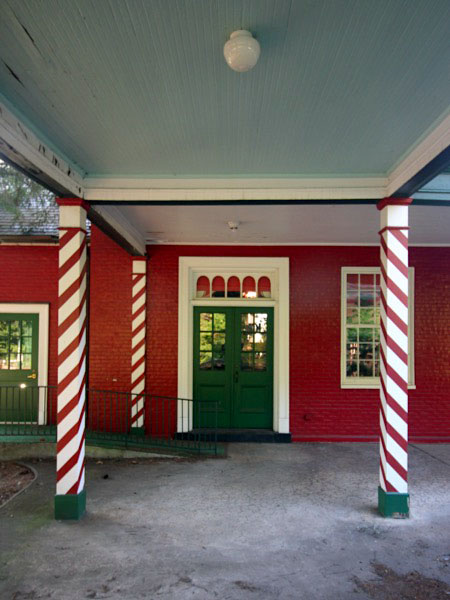
Jun 2022 / RWH
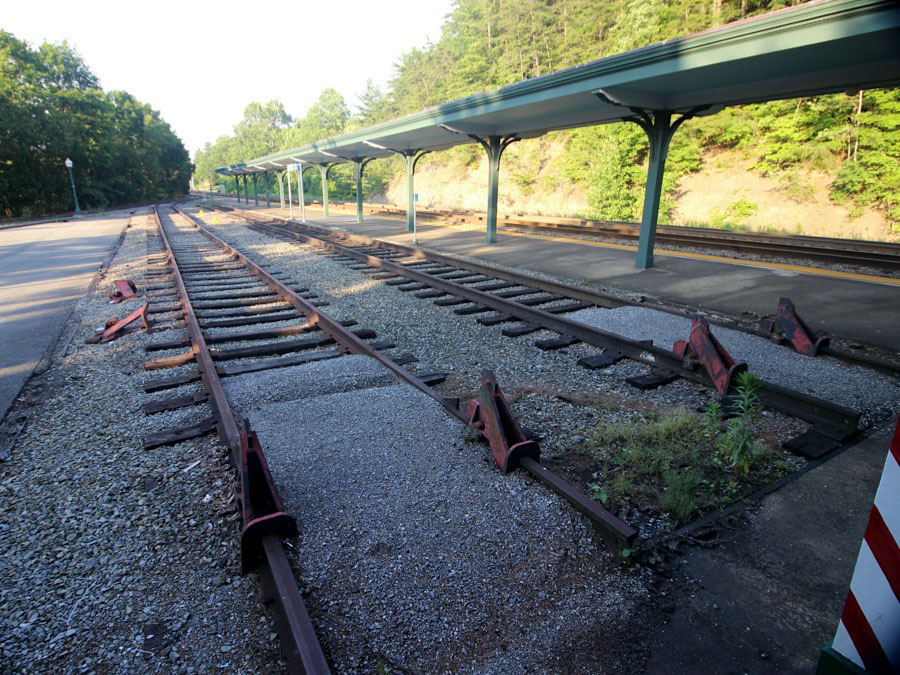
Jun 2022 / RWH
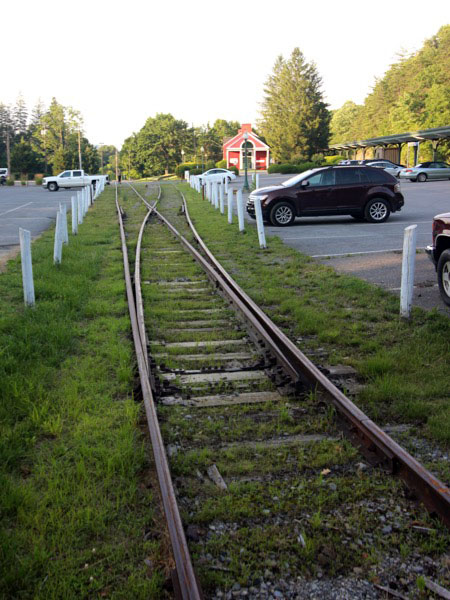
Jun 2022 / RWH
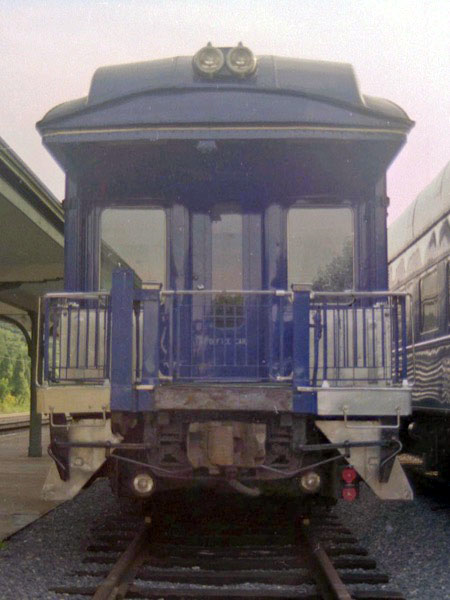
Jun 2022 / RWH
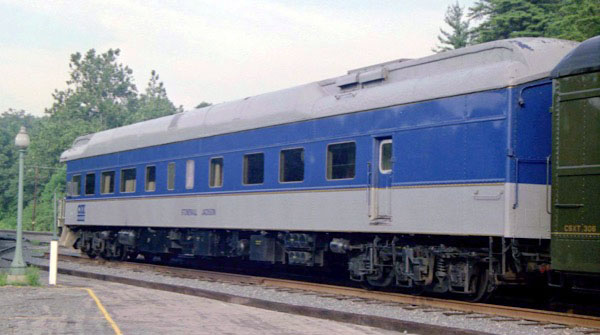
White Sulphur Springs, WV / Aug 1989 / RWH
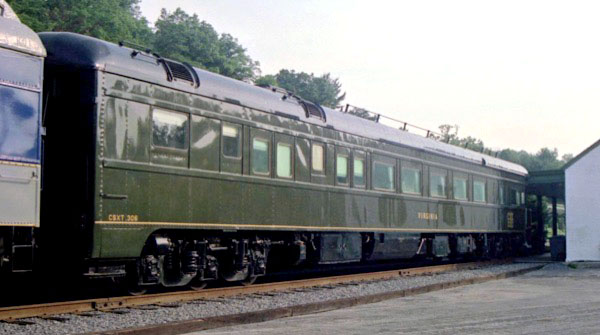
White Sulphur Springs, WV / Aug 1989 / RWH

Jun 2022 / RWH
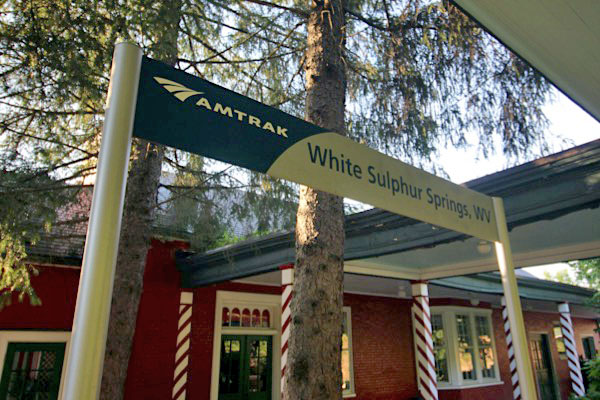
Jun 2022 / RWH
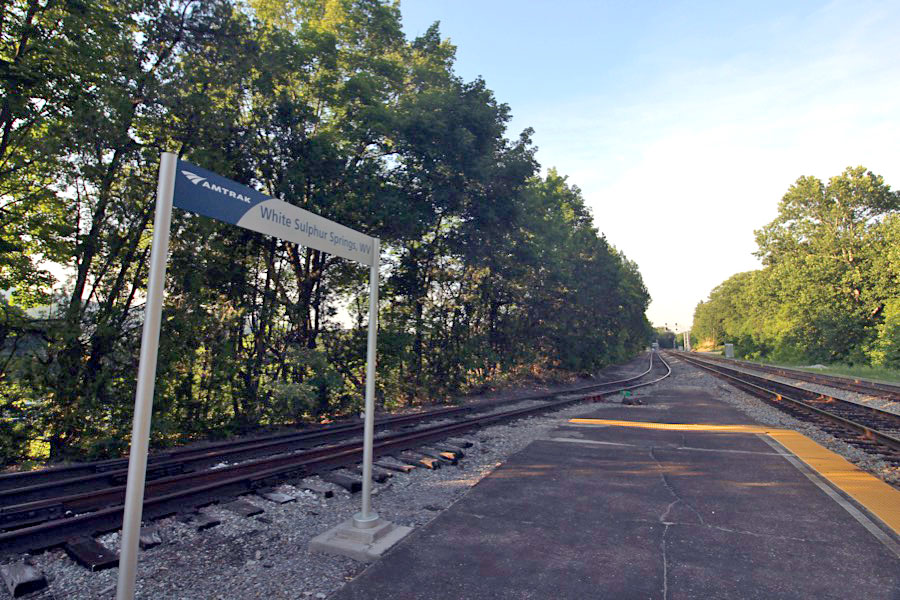
White Sulphur Springs, WV / Jun 2022 / RWH
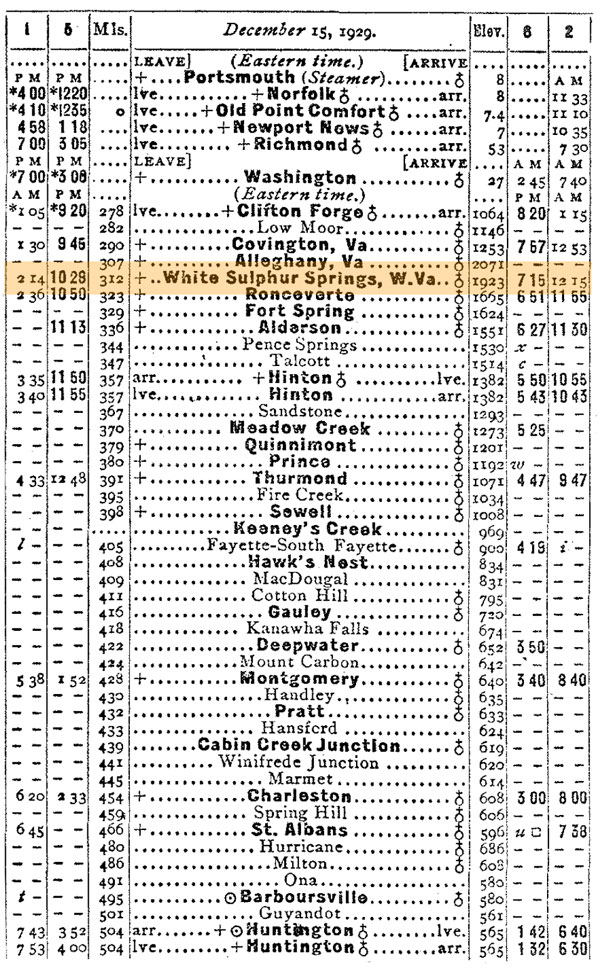
1930 Official Guide ad / collection

White Sulphur Springs, WV / Jun 2022 / RWH
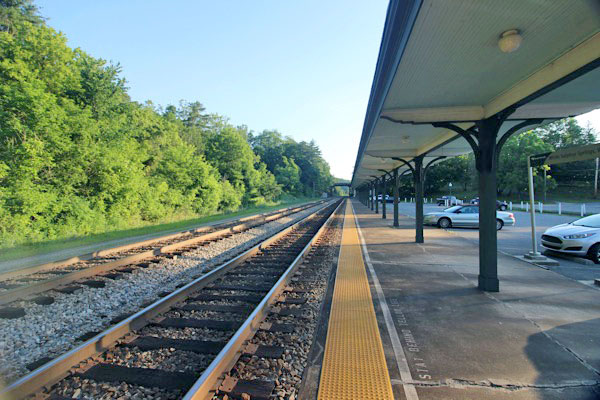
White Sulphur Springs, WV / Jun 2022 / RWH
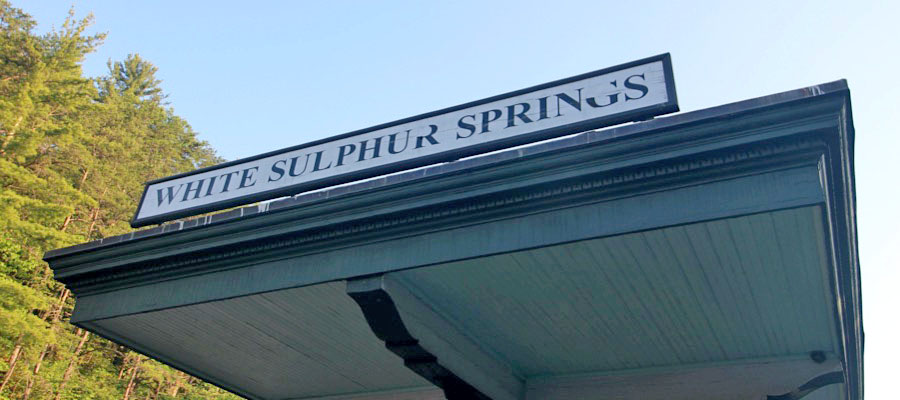
Jun 2022 / RWH
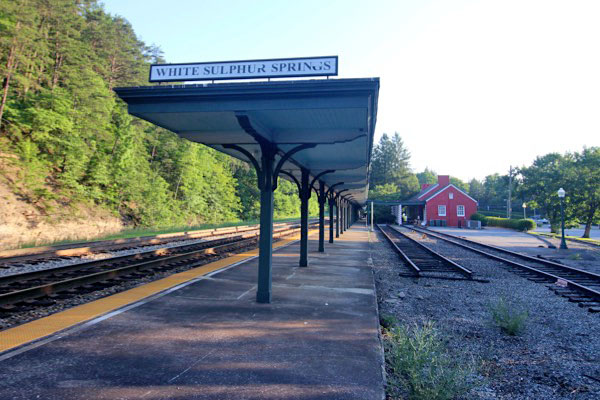
White Sulphur Springs, WV / Jun 2022 / RWH

White Sulphur Springs, WV / Jun 2022 / RWH
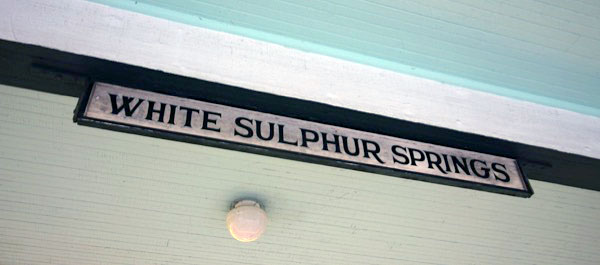
Jun 2022 / RWH
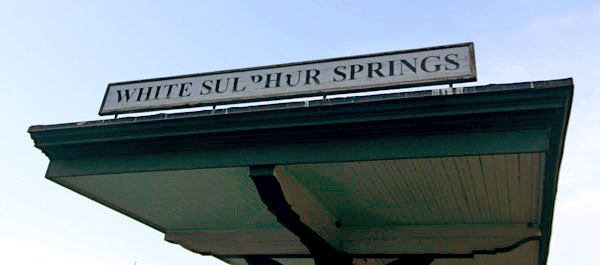
Jun 2022 / RWH
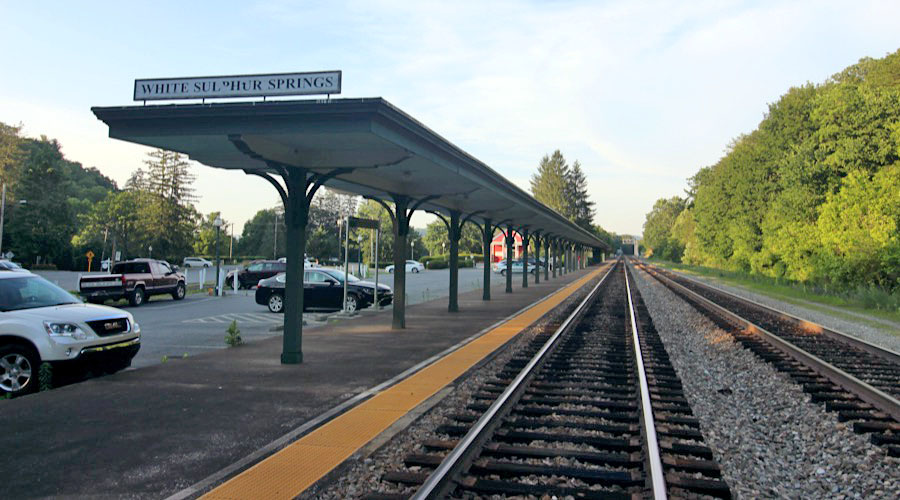
White Sulphur Springs, WV / Jun 2022 / RWH
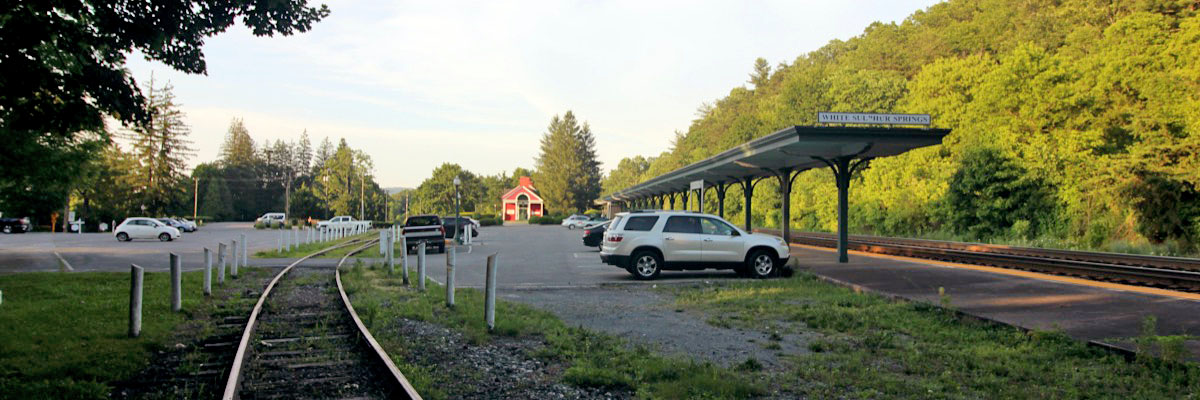
White Sulphur Springs, WV / Jun 2022 / RWH

1930 Official Guide ad / collection
 Greenbrier Resort
Greenbrier Resort

White Sulphur Springs, WV / Jun 2022 / RWH

Click to see the Greenbrier Resort facility plotted on a Google Maps page

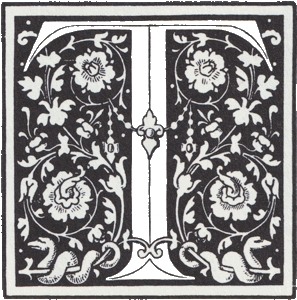 he Greenbrier resort originally consisted of rows of cottages, many of which still stand today. The first large hotel on the property, officially named the Grand Central Hotel but known to long-time patrons as The Old White Hotel, came in 1858. By 1910, the property was purchased and renovated by the Chesapeake & Ohio Railroad and reopened in 1913 as the Greenbrier.
he Greenbrier resort originally consisted of rows of cottages, many of which still stand today. The first large hotel on the property, officially named the Grand Central Hotel but known to long-time patrons as The Old White Hotel, came in 1858. By 1910, the property was purchased and renovated by the Chesapeake & Ohio Railroad and reopened in 1913 as the Greenbrier.

The Greenbrier was a showcase for C&O and was vigorously promoted in railroad timetables and literature. The many tracks behind the station were for business and private cars to be brought by C&O trains and parked there by the wealthy and famous using the hotel. Special resort trains were often run and the 1931 depot was built as part of a plan to make the Greenbrier an attractive destination for the new Pullman trains coming out at that time, including the Sportsman (1930) and the George Washington (1932), one of the first Pullman trains to be completely air conditioned.
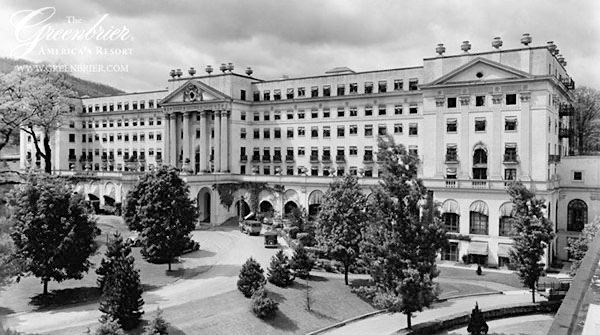 During World War II, the resort served both as an army hospital and as a relocation center for some of the enemy diplomats still within the United States. In 1948, after the war, Sam Snead returned to where his career had begun in 1936. For many years, he was the Golf Pro Emeritus, until his death in May 2002. Snead established Greenbrier’s reputation as one of the foremost golf resorts.
During World War II, the resort served both as an army hospital and as a relocation center for some of the enemy diplomats still within the United States. In 1948, after the war, Sam Snead returned to where his career had begun in 1936. For many years, he was the Golf Pro Emeritus, until his death in May 2002. Snead established Greenbrier’s reputation as one of the foremost golf resorts.
The Greenbrier underwent many renovations during the 1950s and 1960s, during which time a large bunker was created under the grounds of the resort. This bunker was intended to serve as an escape from a nuclear bomb for the entirety of the legislative branch, which would relocate from Washington, D.C. The bunker was maintained until it was decommissioned in 1992 following a news story revealing its existence. CSXT, successor to the C&O, sold the Greenbrier in 2009 to local entrepreneur Jim Justice, who aimed to return the hotel to its former status as a five-star resort.
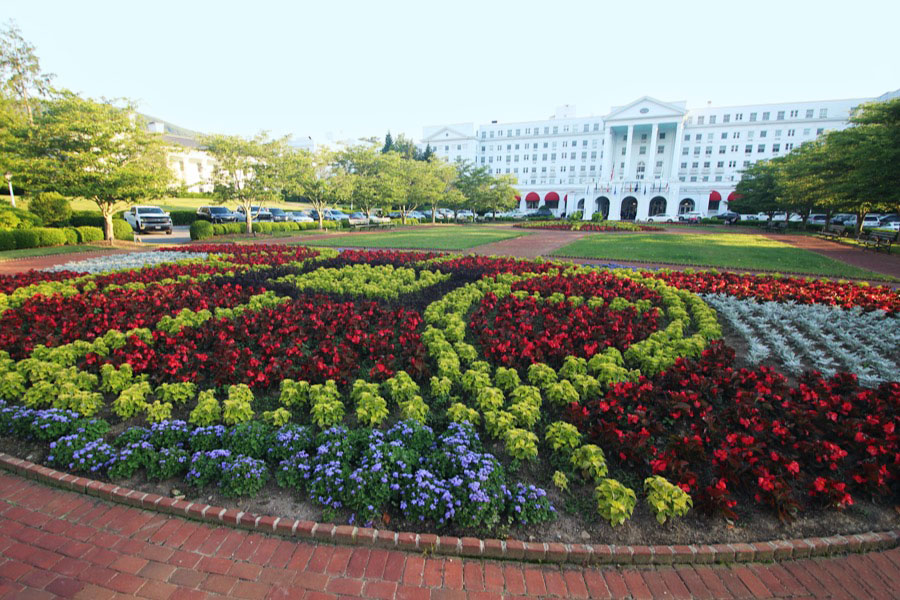
White Sulphur Springs, WV / Jun 2022 / RWH
 Prince, WV
Prince, WV

Prince, WV / Jul 2020 / RWH

Click to see the Prince station plotted on a Google Maps page
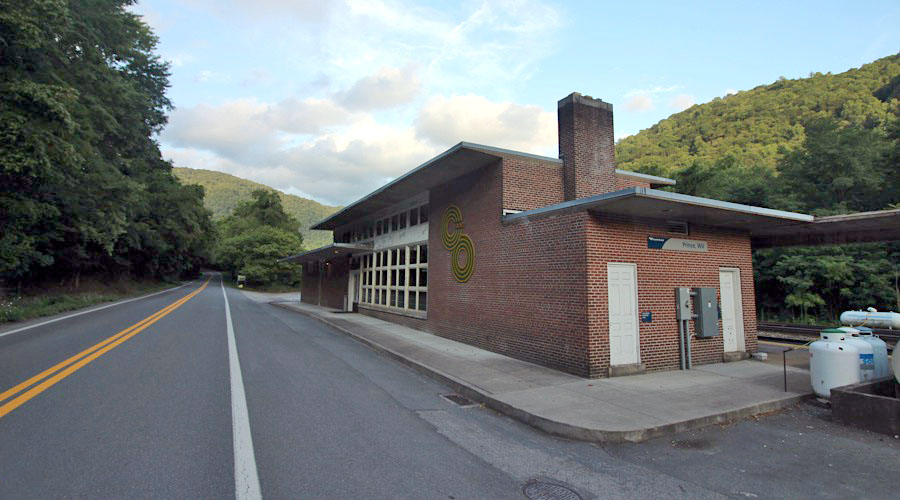
Prince, WV / Jul 2020 / RWH
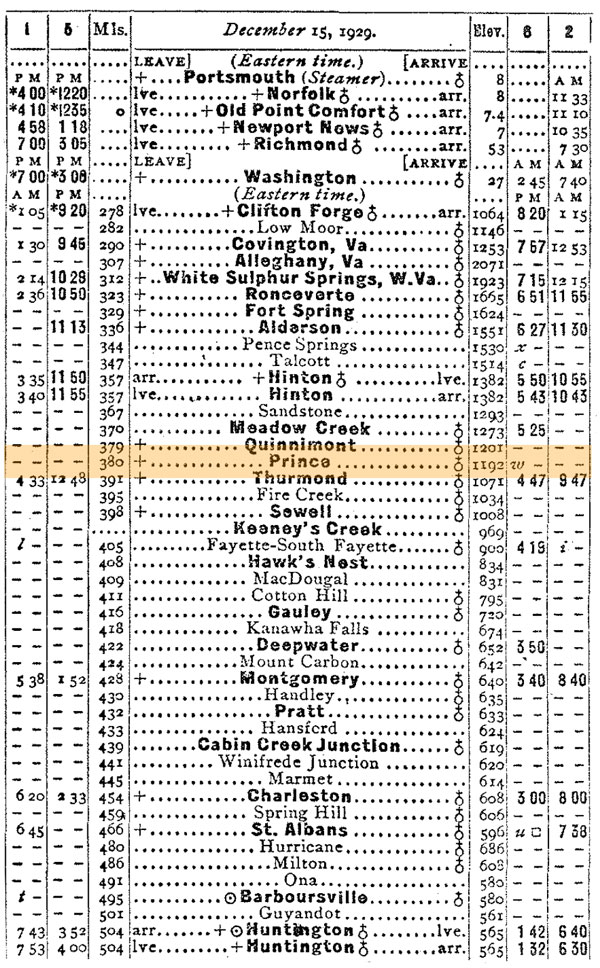
1930 Official Guide ad / collection

Prince, WV / Jul 2020 / RWH
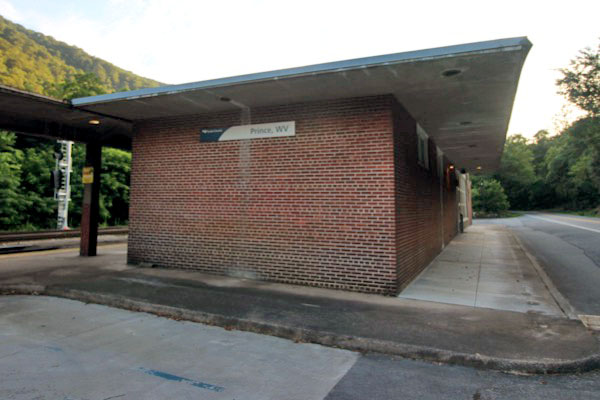
Prince, WV / Jul 2020 / RWH
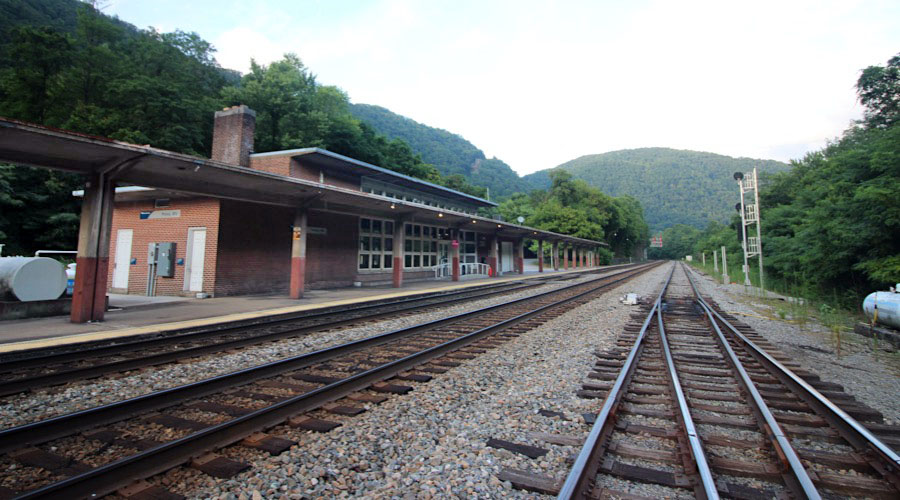
Prince, WV / Jul 2020 / RWH

 he first station at Prince was built by the Chesapeake and Ohio Railway (C&O) in 1880. This wooden depot was enlarged in 1891 to serve an expanding commercial freight and passenger need. Nearly destroyed in a 1917 fire, it was rebuilt soon afterwards.
he first station at Prince was built by the Chesapeake and Ohio Railway (C&O) in 1880. This wooden depot was enlarged in 1891 to serve an expanding commercial freight and passenger need. Nearly destroyed in a 1917 fire, it was rebuilt soon afterwards.
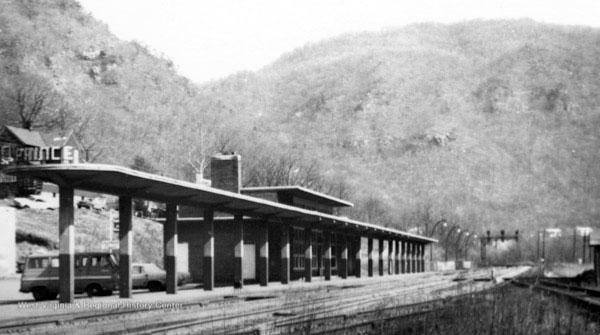 The current red brick station was erected as part of a 1942 vision by C&O president Robert R. Young, who wanted to create a stylish, streamlined and efficient passenger rail system for the post-World War II era. Designed by the railroad and the Cleveland-based architectural firm of Garfield, Harris, Robinson and Schaffer, the building opened on June 26, 1946 during a celebration attended by nearly 3,000 people. It was immediately noted for its sleek Art Moderne features, such as large expanses of glass on the north and south facades, flat cantilevered roof and terrazzo flooring.
The current red brick station was erected as part of a 1942 vision by C&O president Robert R. Young, who wanted to create a stylish, streamlined and efficient passenger rail system for the post-World War II era. Designed by the railroad and the Cleveland-based architectural firm of Garfield, Harris, Robinson and Schaffer, the building opened on June 26, 1946 during a celebration attended by nearly 3,000 people. It was immediately noted for its sleek Art Moderne features, such as large expanses of glass on the north and south facades, flat cantilevered roof and terrazzo flooring.
Taking advantage of the site along the New River, the architects oriented the building so that during the winter, the sun warms those who wait along the platform and inside the depot, while during the summer, the roof and platform canopy provide shady relief from the heat. In the waiting room, visitors can still see the C&O’s original “Chessie” kitten logo embedded in the floor.
 In addition to the waiting area and ticket desk, the 125 foot long by 22 foot wide depot contained restrooms, a ladies’ lounge and freight, baggage and express rooms; passengers noted modern technologies such as ultraviolet lights and radiant heating in the floor. On one end of the waiting room, there is a wall-length photo mural. The image, taken by Arnold Eagle in 1944, shows the coal tipple in nearby Crab Orchard and highlights the economic importance of coal mining to the C&O and the region. Today, many of the mines are closed, as are the steam-powered trains that carried the coal across the country.
In addition to the waiting area and ticket desk, the 125 foot long by 22 foot wide depot contained restrooms, a ladies’ lounge and freight, baggage and express rooms; passengers noted modern technologies such as ultraviolet lights and radiant heating in the floor. On one end of the waiting room, there is a wall-length photo mural. The image, taken by Arnold Eagle in 1944, shows the coal tipple in nearby Crab Orchard and highlights the economic importance of coal mining to the C&O and the region. Today, many of the mines are closed, as are the steam-powered trains that carried the coal across the country.
Prince had been selected as the prototype for this visionary station because it served a great many passengers from nearby Beckley and other communities. Beckley is still a thriving community, sitting atop a mountain plateau, rather than down in the relatively cramped and difficult-to-access environs of the river gorge where Prince lies. The depot was intended to serve the railroad’s newest daylight streamline passenger train from Washington to Cincinnati, The Chessie, but it never went into regular service.
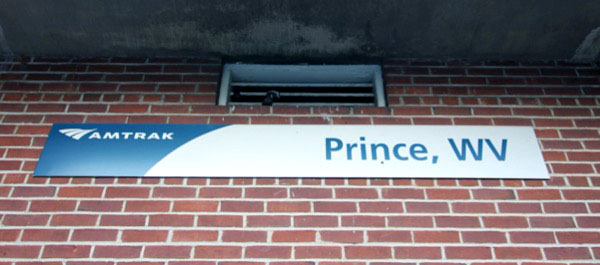
Jul 2020 / RWH
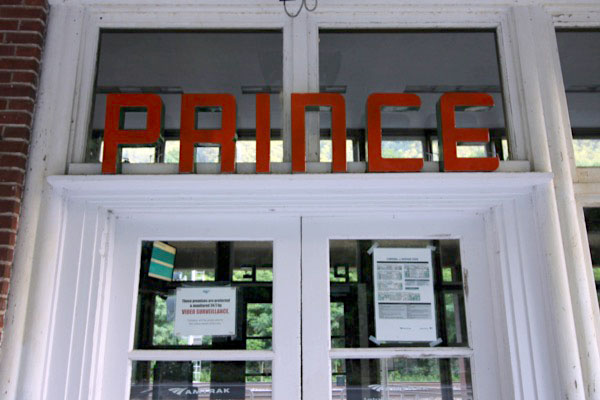
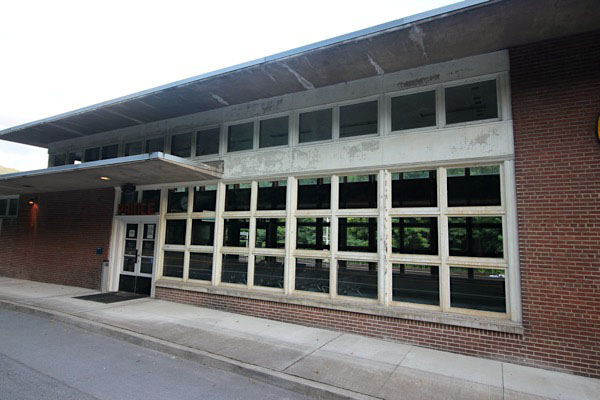
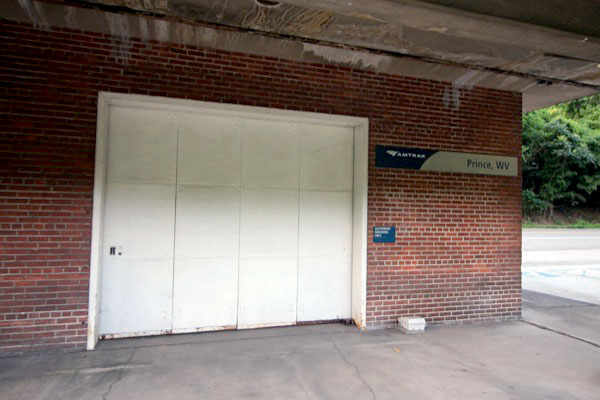
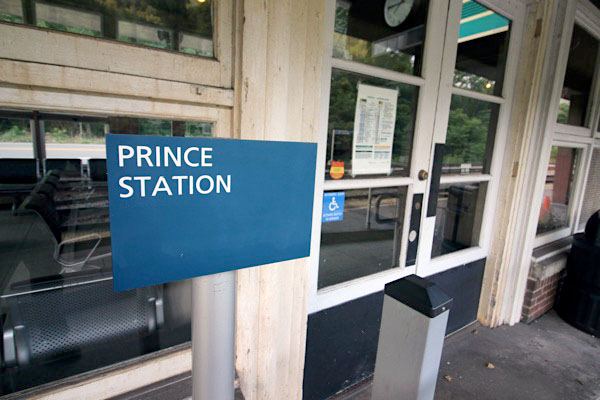

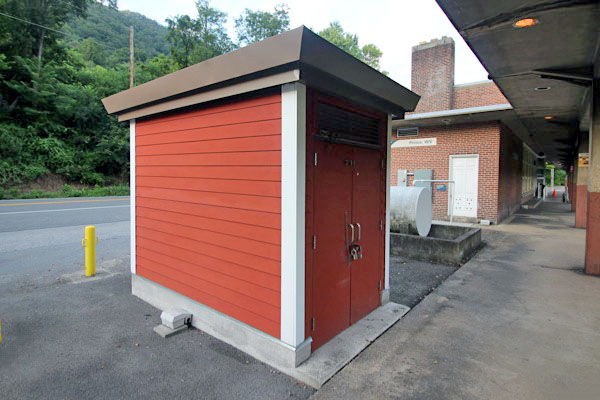
Jul 2020 / RWH
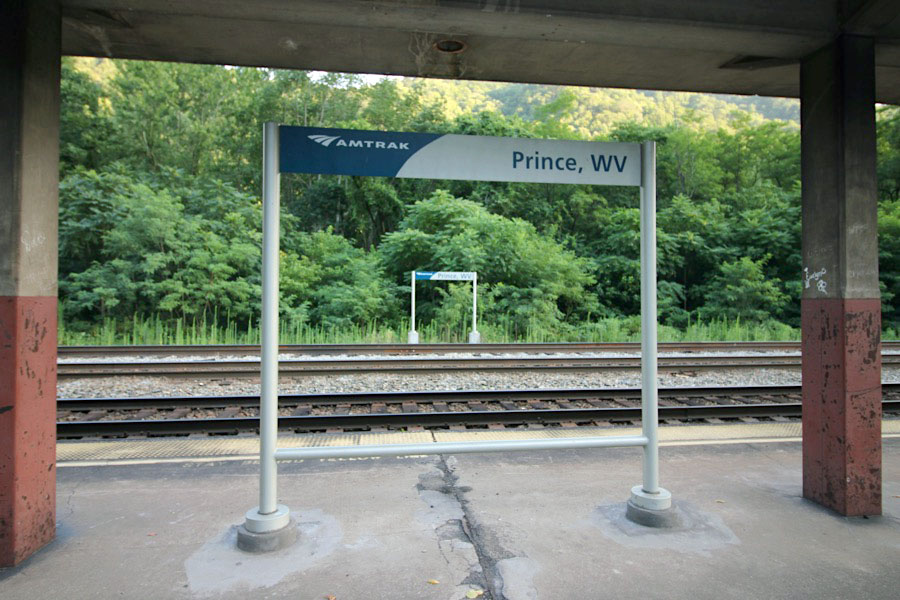
Jul 2020 / RWH
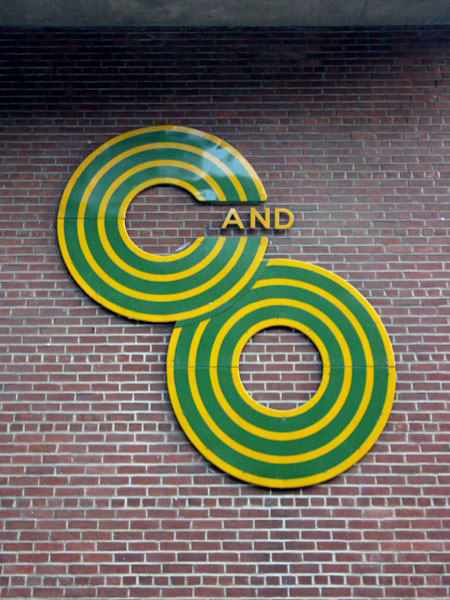
Jul 2020 / RWH

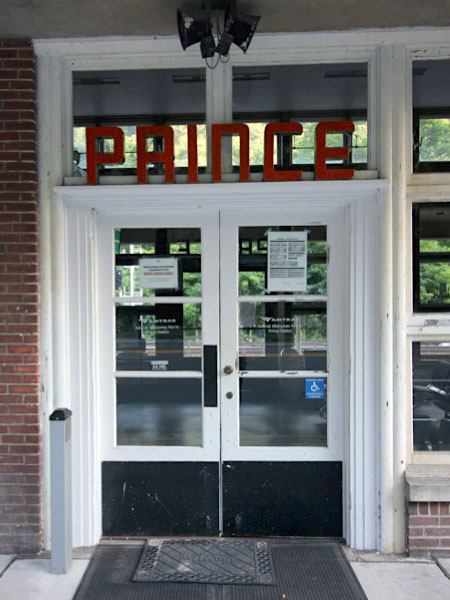
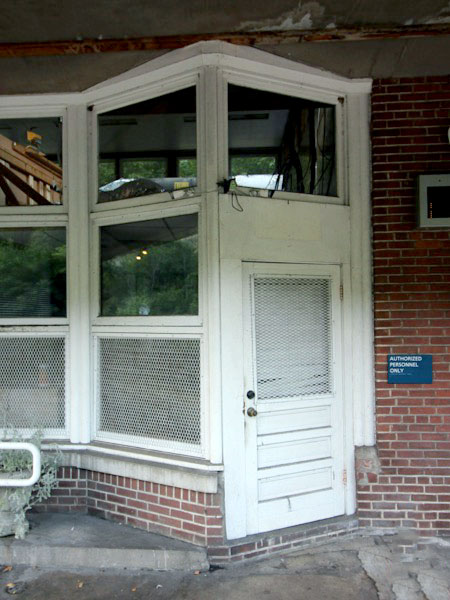
Jul 2020 / RWH
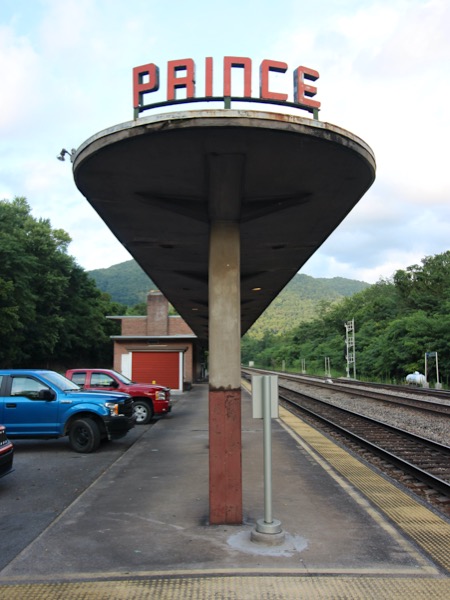
Jul 2020 / RWH
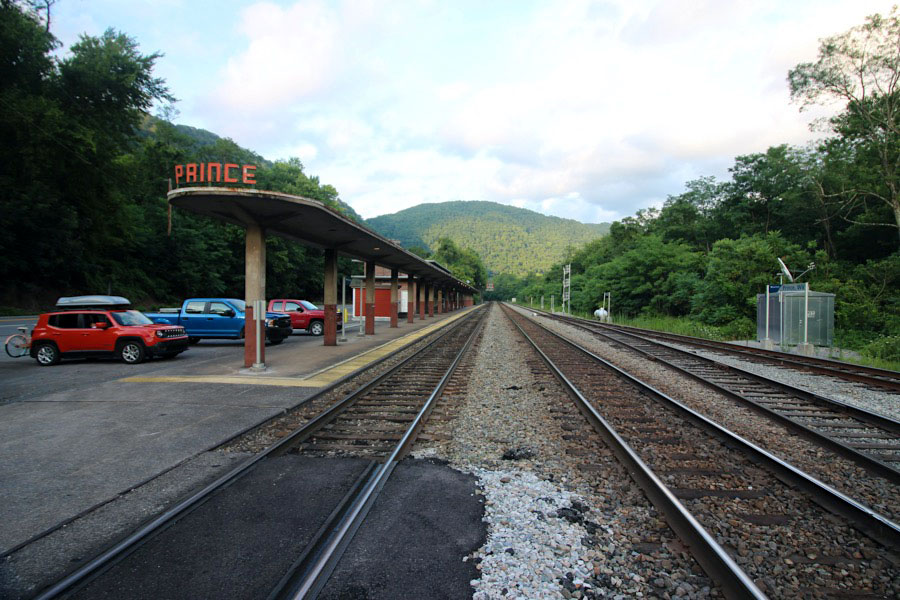
Royal, WV / Jul 2020 / RWH
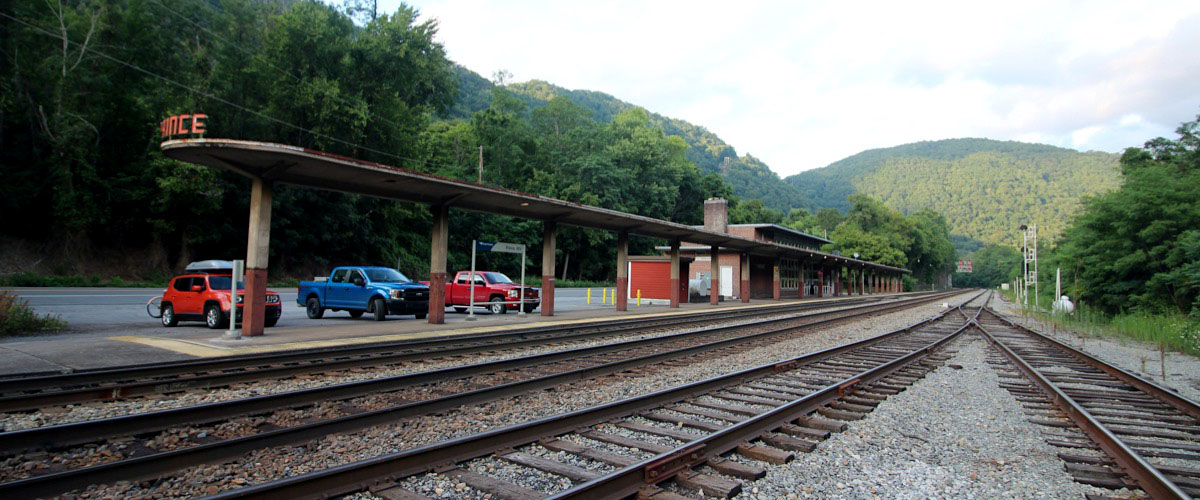
Royal, WV / Jul 2020 / RWH
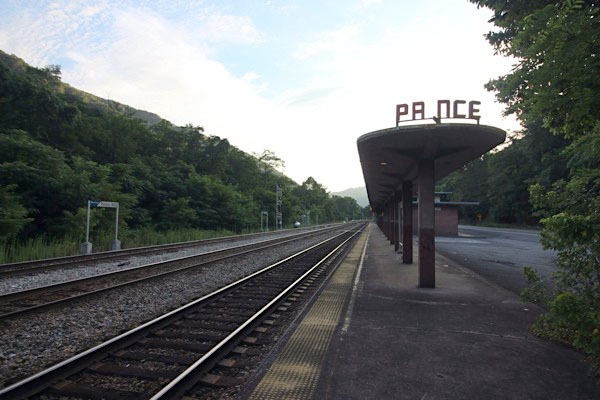
Royal, WV / Jul 2020 / RWH
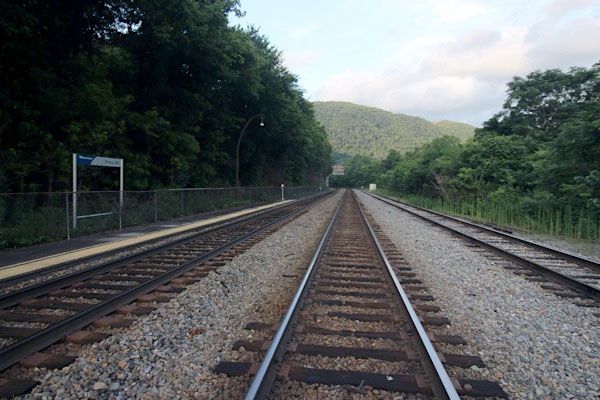
Royal, WV / Jul 2020 / RWH
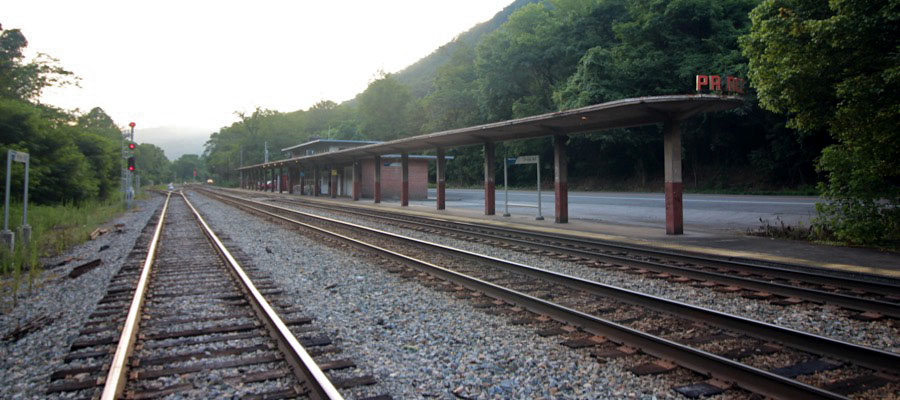
Royal, WV / Jul 2020 / RWH
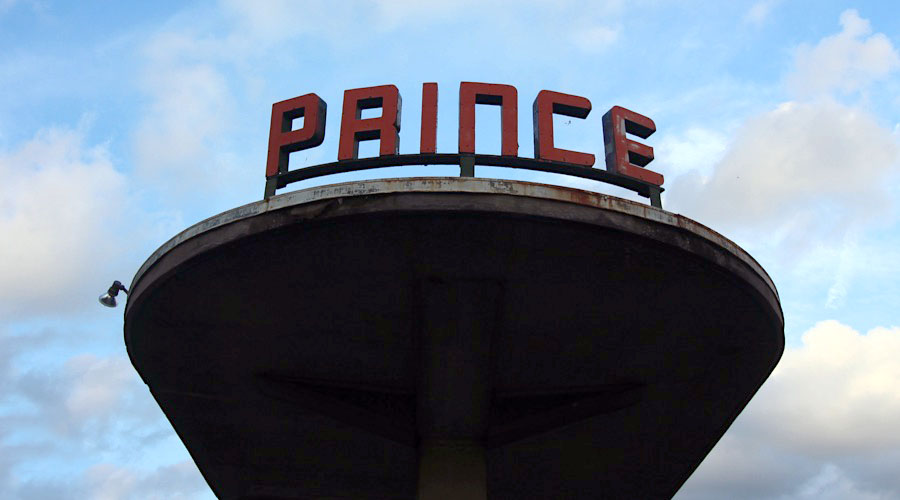
Jul 2020 / RWH
 New River
New River
For much of the Cardinal's route through West Virginia, the former Chesapeake & Ohio mainline (CSX Transportation) follows the winding scenic New River. The Prince station (above) is itself situated near the riverline. Just west of the station, a C&O secondary line south to Raleigh, West Virgina, leaves the main and immediately crosses the New River at a scenic spot at the Fayette County line.
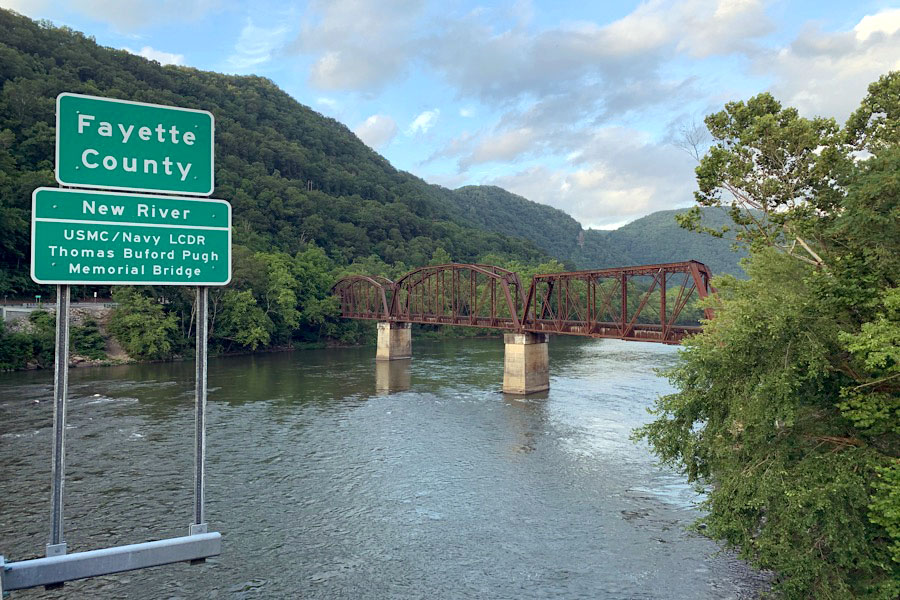
Royal, WV / Jul 2020 / RWH

Click to see the New River railroad bridge plotted on a Google Maps page
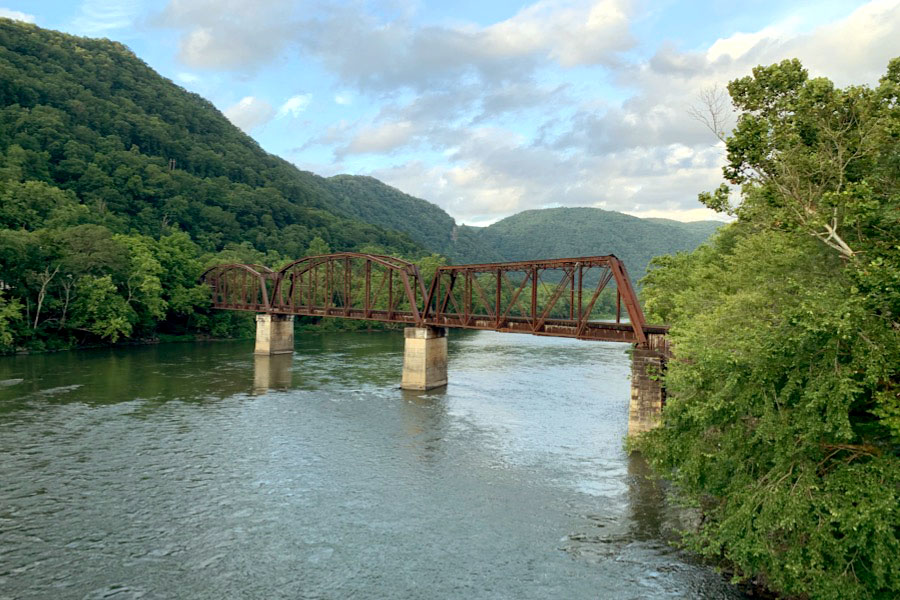
Royal, WV / Jul 2020 / RWH
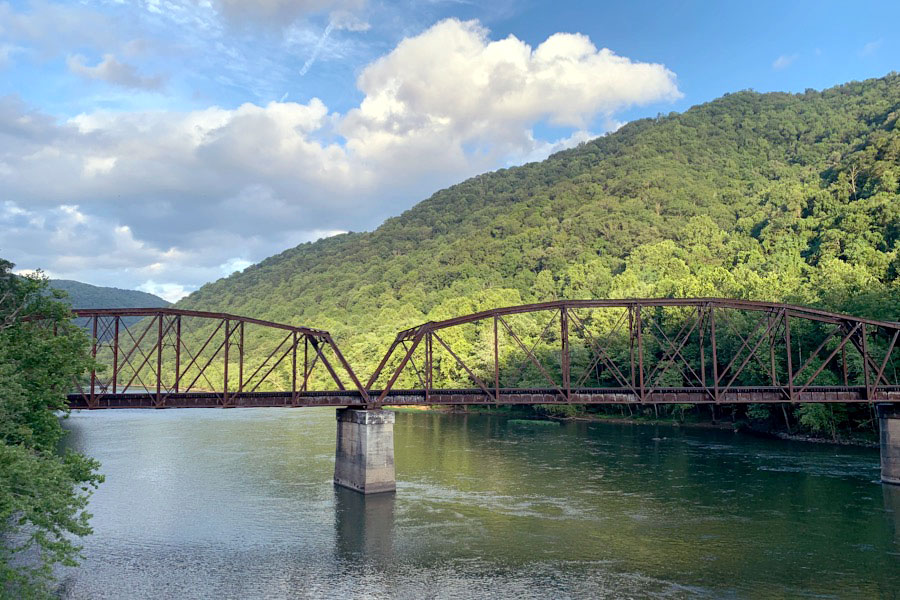
Royal, WV / Jul 2020 / RWH
 Thurmond, WV
Thurmond, WV

Thurmond, WV / May 2016 / RWH

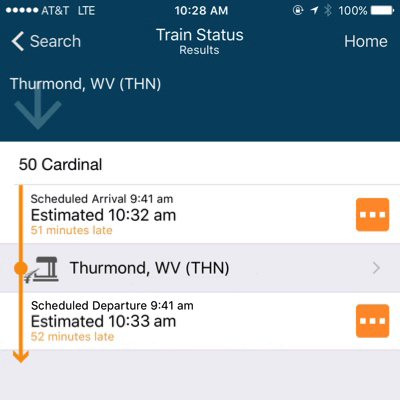 On my way home to Pennsylvania from an excellent Saturday chasing Norfolk & Western #611 across central Virginia with my brother-in-law, on Sunday I made an impromptu stop across the New River in Thurmond, West Virginia. What I love about railfanning is the element of surprise: some locations on some days yield nothing in the way of action; others yield everything. Thurmond this Sunday morning turned out to be the right place at the right time. When I rolled up to the historic depot, I noticed there was some folks with luggage standing around. I checked Amtrak.com on my phone: Sure enough, the Cardinal was running almost an hour late that morning. I would be able to catch it's station stop. Then I noticed a westbound CSX freight on the far side of the depot, stopped by a control point signal. Before long, it became clear that he was waiting, not for the eastbound Cardinal, but for yet another CSX freight that had to come through before #50 could do its station work. The dispatcher cleared the two freights, and then the familiar profile of a Genesis unit appeared under the Thurmond signal masts. #50 rolled in, dropped off and took on a handful of Sunday travellers, then highballed out of Thurmond for Chesapeake & Ohio points east -- thus fulfilling one more time the time-honored American flag stop routine. Three trains in one hour, in a great location: That's what I love about railfanning. It was a great morning to visit the otherwise sleepy little town of Thurmond, West Virginia.
On my way home to Pennsylvania from an excellent Saturday chasing Norfolk & Western #611 across central Virginia with my brother-in-law, on Sunday I made an impromptu stop across the New River in Thurmond, West Virginia. What I love about railfanning is the element of surprise: some locations on some days yield nothing in the way of action; others yield everything. Thurmond this Sunday morning turned out to be the right place at the right time. When I rolled up to the historic depot, I noticed there was some folks with luggage standing around. I checked Amtrak.com on my phone: Sure enough, the Cardinal was running almost an hour late that morning. I would be able to catch it's station stop. Then I noticed a westbound CSX freight on the far side of the depot, stopped by a control point signal. Before long, it became clear that he was waiting, not for the eastbound Cardinal, but for yet another CSX freight that had to come through before #50 could do its station work. The dispatcher cleared the two freights, and then the familiar profile of a Genesis unit appeared under the Thurmond signal masts. #50 rolled in, dropped off and took on a handful of Sunday travellers, then highballed out of Thurmond for Chesapeake & Ohio points east -- thus fulfilling one more time the time-honored American flag stop routine. Three trains in one hour, in a great location: That's what I love about railfanning. It was a great morning to visit the otherwise sleepy little town of Thurmond, West Virginia.

Thurmond, WV / May 2016 / RWH
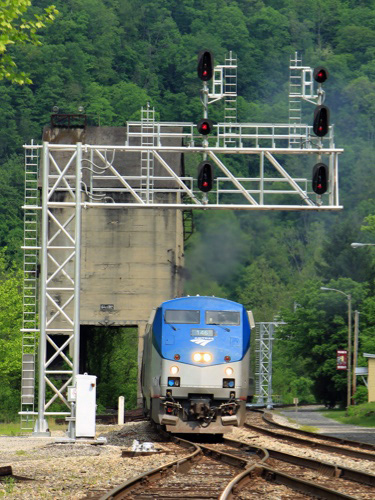
May 2016 / RWH
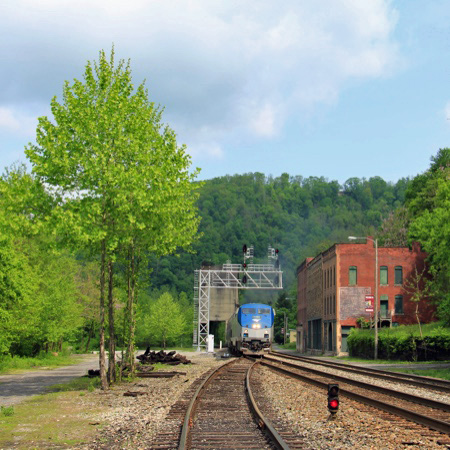
Thurmond, WV / May 2016 / RWH

Thurmond, WV / May 2016 / RWH
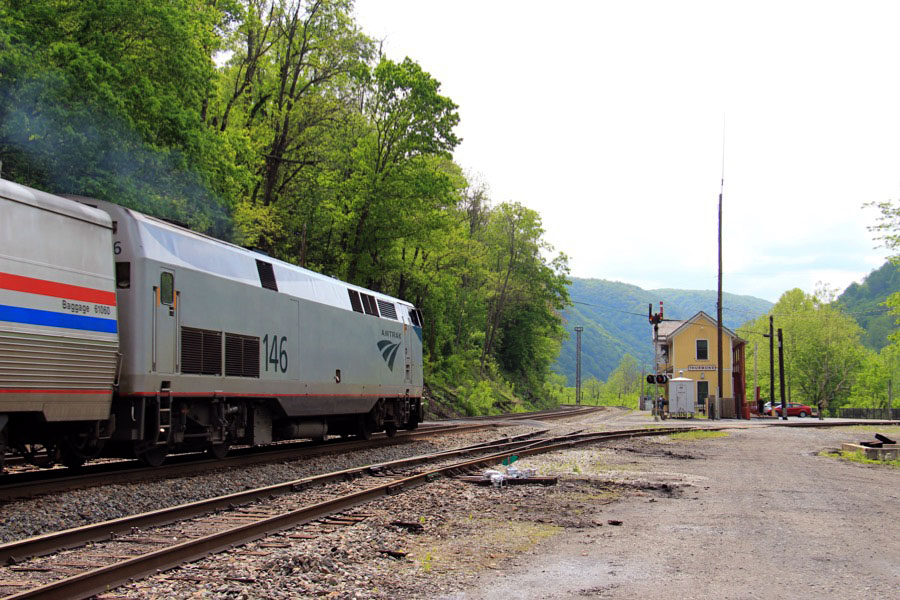
Thurmond, WV / May 2016 / RWH

Click to see the Thurmond depot historical area plotted on a Google Maps page
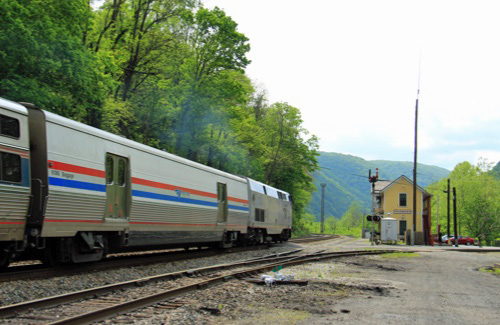
Thurmond, WV / May 2016 / RWH
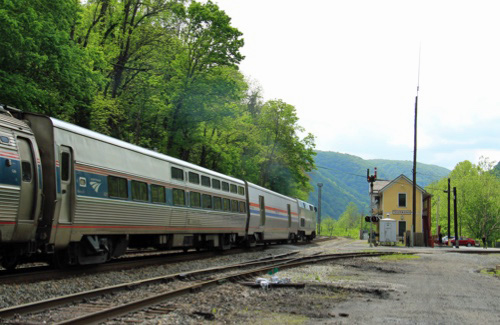
Thurmond, WV / May 2016 / RWH
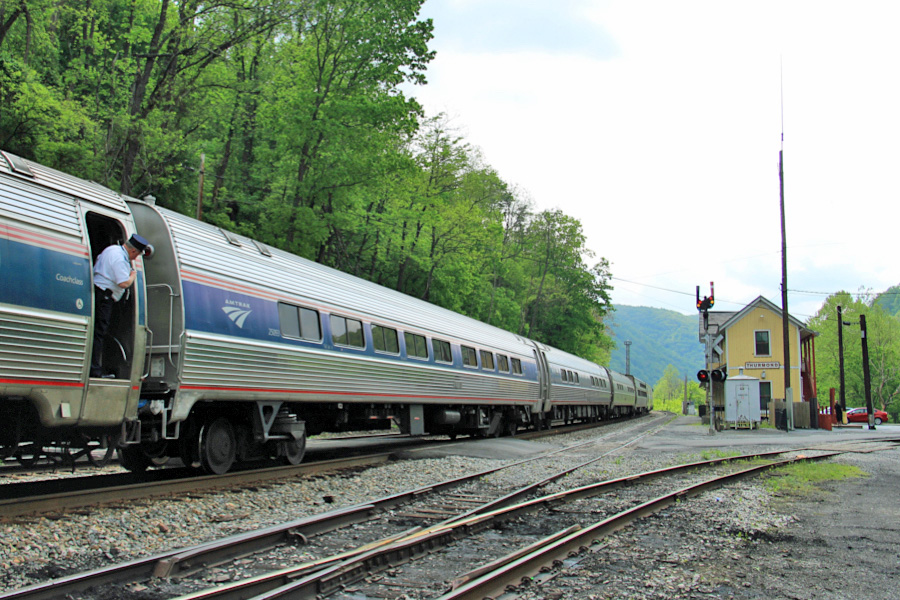
Thurmond, WV / May 2016 / RWH
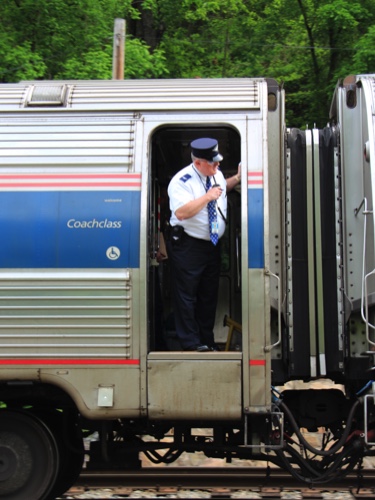
May 2016 / RWH
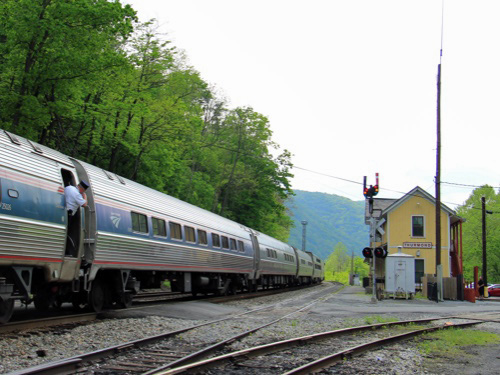
Thurmond, WV / May 2016 / RWH
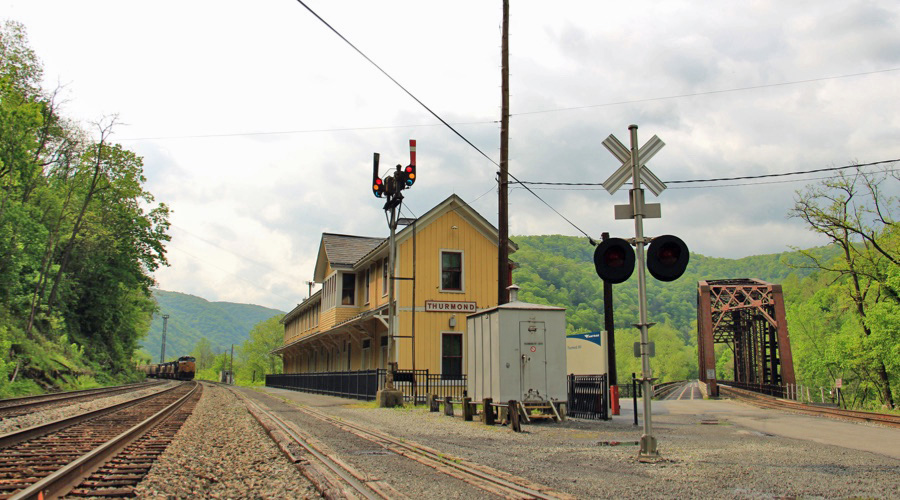
Thurmond, WV / May 2016 / RWH
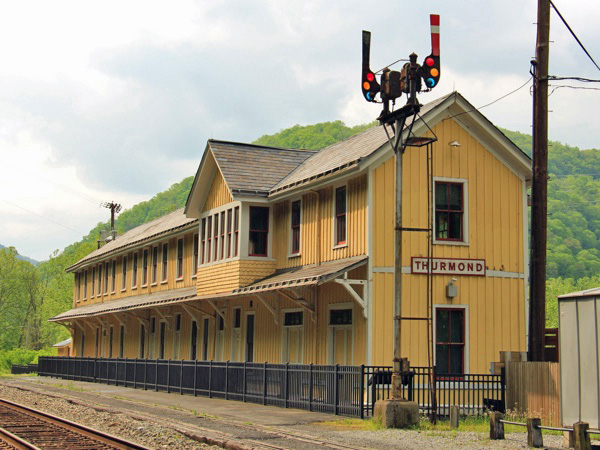
Thurmond, WV / May 2016 / RWH

Thurmond, WV / May 2016 / RWH

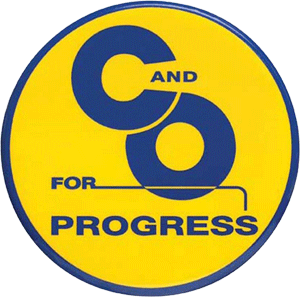 Passengers at Thurmond may wait under the eaves of the two story, wood frame depot, which was built in 1904 for the Chesapeake and Ohio Railway (C&O). During the summer months, the National Park Service opens the depot as a welcome center for visitors to the New River Gorge National River. The building, restored in 1995, once served both as passenger depot and offices for the C&O. The yardmaster’s office on the west end overlooks Thurmond’s West Yard; the office has been restored with authentic furniture, fixtures and equipment from the early 1900s. The train master’s and ticket master’s offices have also been restored and present museum exhibits relating to Thurmond and the railroad.
Passengers at Thurmond may wait under the eaves of the two story, wood frame depot, which was built in 1904 for the Chesapeake and Ohio Railway (C&O). During the summer months, the National Park Service opens the depot as a welcome center for visitors to the New River Gorge National River. The building, restored in 1995, once served both as passenger depot and offices for the C&O. The yardmaster’s office on the west end overlooks Thurmond’s West Yard; the office has been restored with authentic furniture, fixtures and equipment from the early 1900s. The train master’s and ticket master’s offices have also been restored and present museum exhibits relating to Thurmond and the railroad.
Thurmond, located in the middle of the steep New River Gorge, was long accessible only by rail. The town was named for William Dabney Thurmond, who received the 73-acre site in 1873 as payment for a surveying job, and settled there. That same year, the C&O opened its main line through the gorge to connect the Atlantic coast to the Ohio River. The rail line runs along the bank of the New River, and the town, which lacked a single street until 1921, climbs the steep mountain behind the tracks.
In 1883, the C&O built a freight station in Thurmond, and soon after, a railroad bridge was completed across the river to connect the coal mines with the main line. This first station burned in 1899, and was replaced with the current building.

Thurmond, WV / May 2016 / RWH
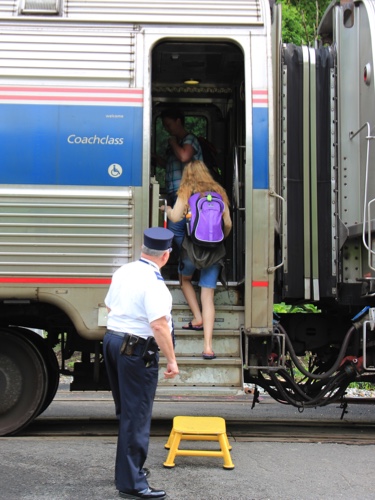
May 2016 / RWH
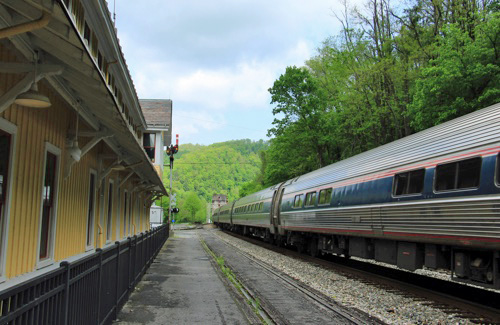
Thurmond, WV / May 2016 / RWH
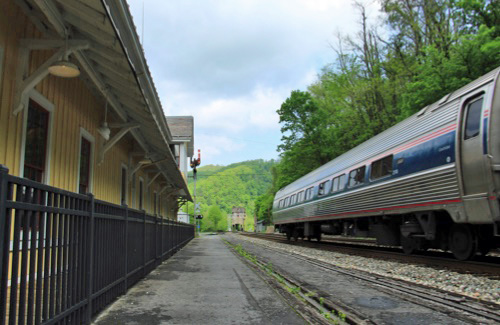
Thurmond, WV / May 2016 / RWH
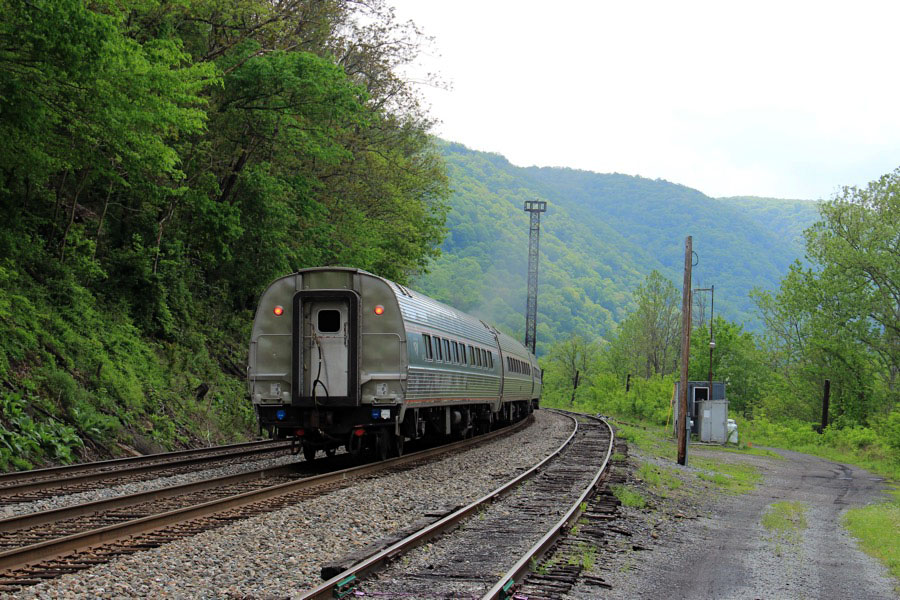
Thurmond, WV / May 2016 / RWH

See also our complete Thurmond West Virginia scrapbook in Preservation
 Charleston, WV
Charleston, WV

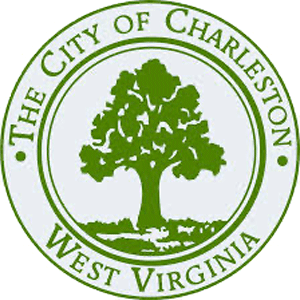 Charleston, county seat of Kanawha County and capital of West Virginia, is located about 255 miles west of Washington, D.C. on the Kanawha River, a tributary of the Ohio River. The Kanawha is navigable and is joined by the Elk River near the center of the city. Until the Civil War, West Virginia was part of the state of Virginia. Col. George Clendenin built Fort Lee on the present site of Charleston in 1788. The name honored Governor Henry Lee of Virginia. The fort served as protection for the settlers, whose encroachments on Indian hunting areas provoked stiff resistance. When Kanawha County was formed in 1791, the citizens sent Daniel Boone, who fished and trapped in the Kanawha Valley, to the Virginia Legislature to represent them.
The legislature granted a charter to the community in 1794 under the name Charles Town, after Col. Clendenin's father, but that was shortened to Charleston in 1818.
Charleston, county seat of Kanawha County and capital of West Virginia, is located about 255 miles west of Washington, D.C. on the Kanawha River, a tributary of the Ohio River. The Kanawha is navigable and is joined by the Elk River near the center of the city. Until the Civil War, West Virginia was part of the state of Virginia. Col. George Clendenin built Fort Lee on the present site of Charleston in 1788. The name honored Governor Henry Lee of Virginia. The fort served as protection for the settlers, whose encroachments on Indian hunting areas provoked stiff resistance. When Kanawha County was formed in 1791, the citizens sent Daniel Boone, who fished and trapped in the Kanawha Valley, to the Virginia Legislature to represent them.
The legislature granted a charter to the community in 1794 under the name Charles Town, after Col. Clendenin's father, but that was shortened to Charleston in 1818.
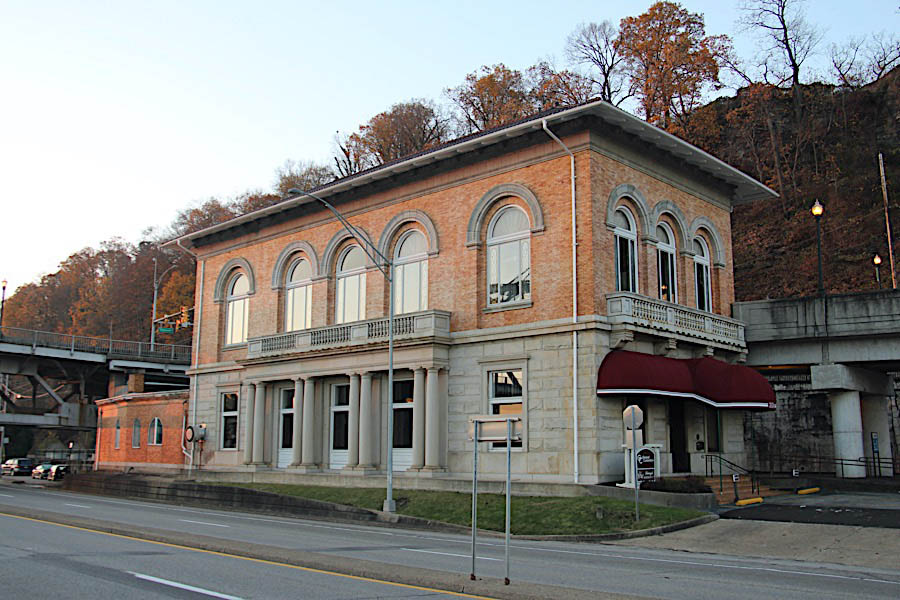
Charleston, WV / Dec 2017 / RWH

Click to see the Charleston Amtrak station plotted on a Google Maps page
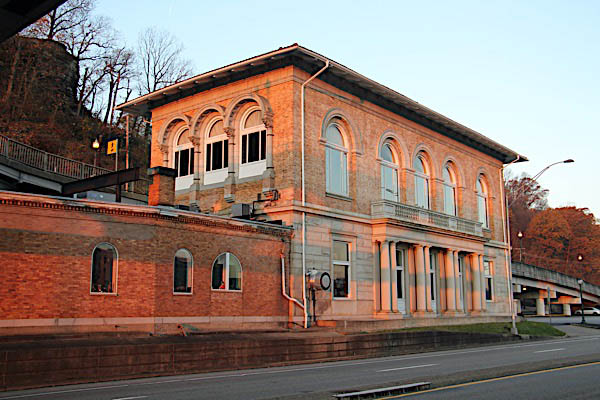
Charleston, WV / Dec 2017 / RWH
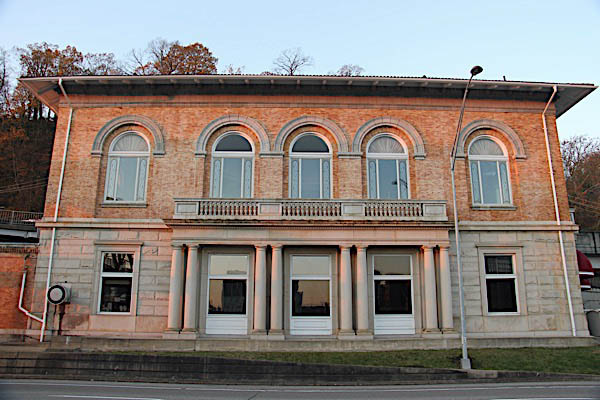
Charleston, WV / Dec 2017 / RWH
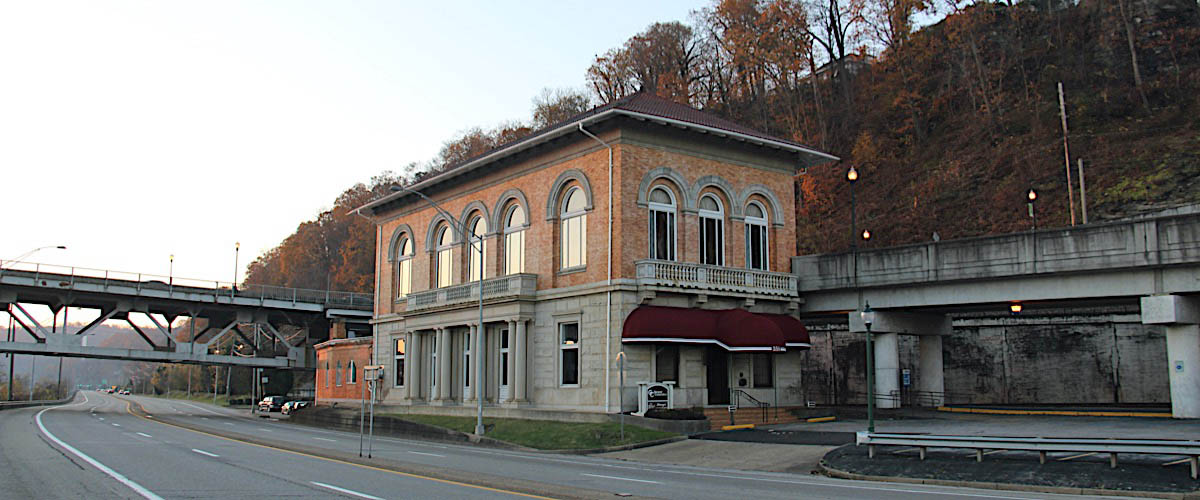
Charleston, WV / Dec 2017 / RWH
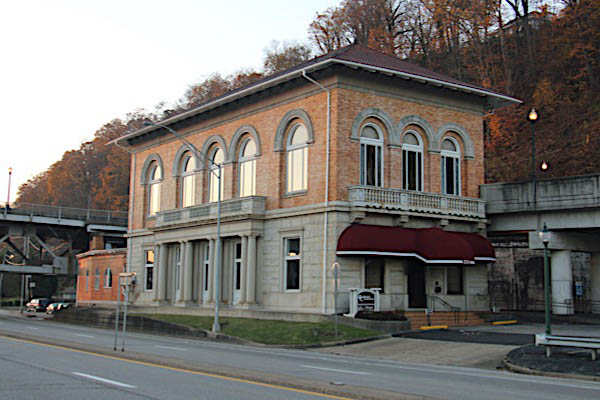
Charleston, WV / Dec 2017 / RWH
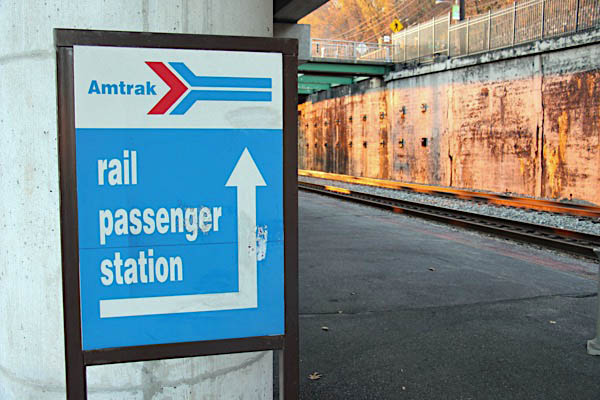
Charleston, WV / Dec 2017 / RWH
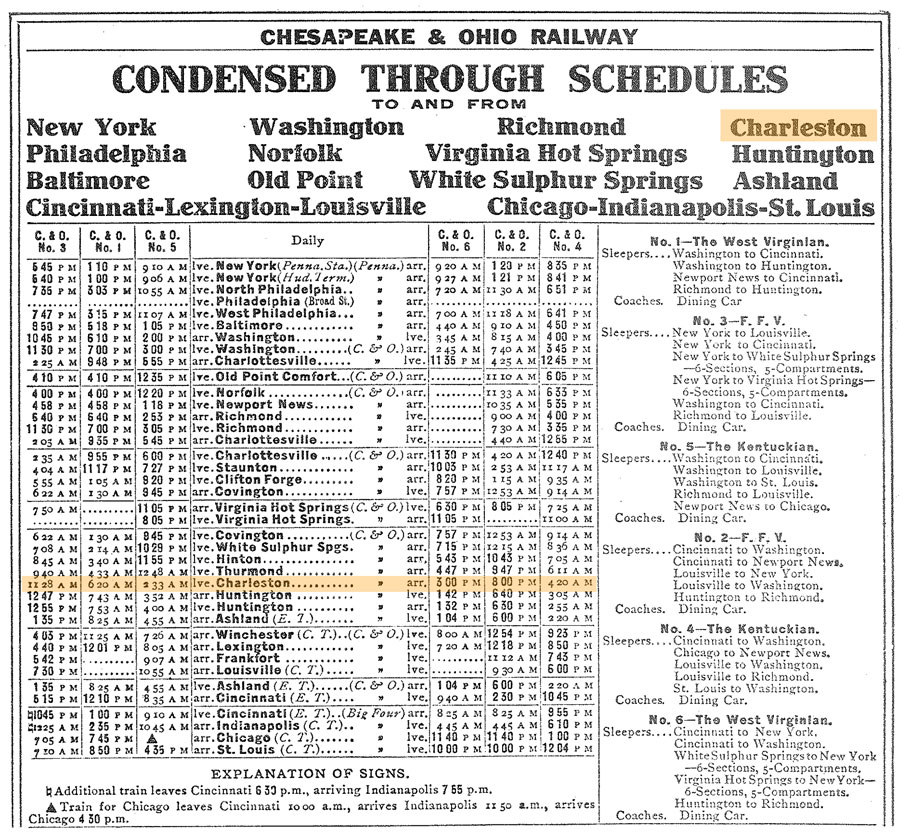
1930 Official Guide ad / collection

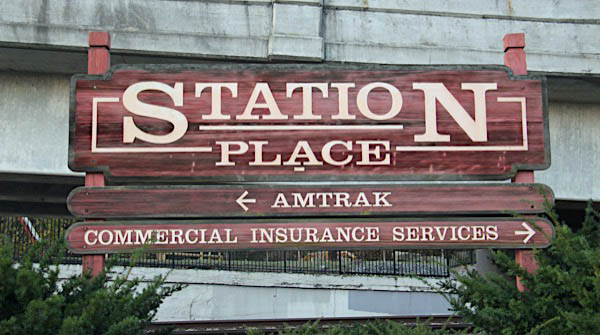
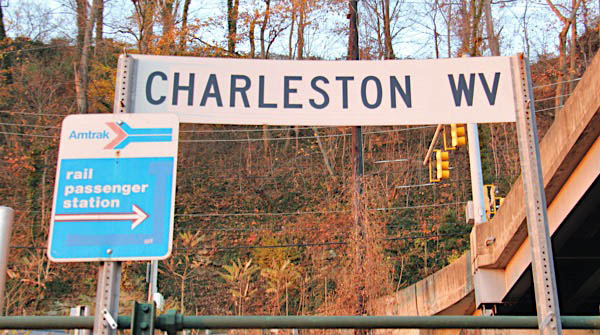
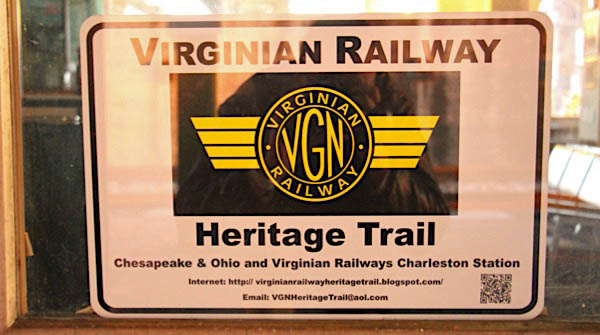
Dec 2017 / RWH

 The Charleston station was built for the Chesapeake & Ohio Railway (C&O) in 1905, and sits on the south bank of the Kanawha River, opposite downtown Charleston. The principal architects were J.C. and A.L. Pennock. The station is located at the foot of the South Side Bridge, and the track itself sits at the bottom of a shored-up cut into the hillside along the river. The two-story Neo-Classical Beaux-Arts style structure is of blonde brick and stone construction. The façade features a shallow single-story portico of paired Roman Doric columns facing the river. The low hipped, terra-cotta tile-covered roof’s deep eaves are supported with brackets. This station is the only railroad station structure remaining in Charleston. The building was placed on the National Register of Historic Places in 1984 and substantially renovated in 1987. Today, it houses offices and a restaurant.
The Charleston station was built for the Chesapeake & Ohio Railway (C&O) in 1905, and sits on the south bank of the Kanawha River, opposite downtown Charleston. The principal architects were J.C. and A.L. Pennock. The station is located at the foot of the South Side Bridge, and the track itself sits at the bottom of a shored-up cut into the hillside along the river. The two-story Neo-Classical Beaux-Arts style structure is of blonde brick and stone construction. The façade features a shallow single-story portico of paired Roman Doric columns facing the river. The low hipped, terra-cotta tile-covered roof’s deep eaves are supported with brackets. This station is the only railroad station structure remaining in Charleston. The building was placed on the National Register of Historic Places in 1984 and substantially renovated in 1987. Today, it houses offices and a restaurant.
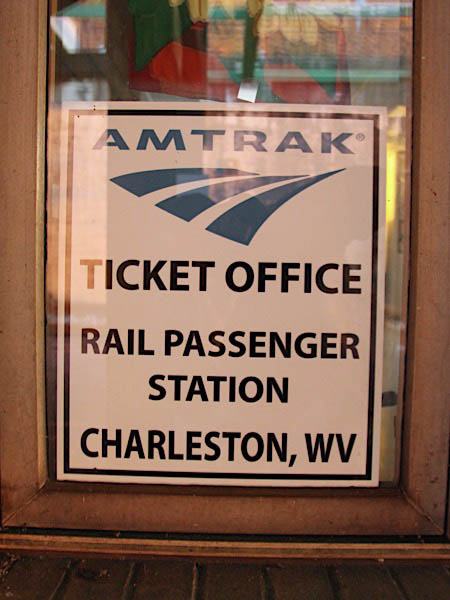
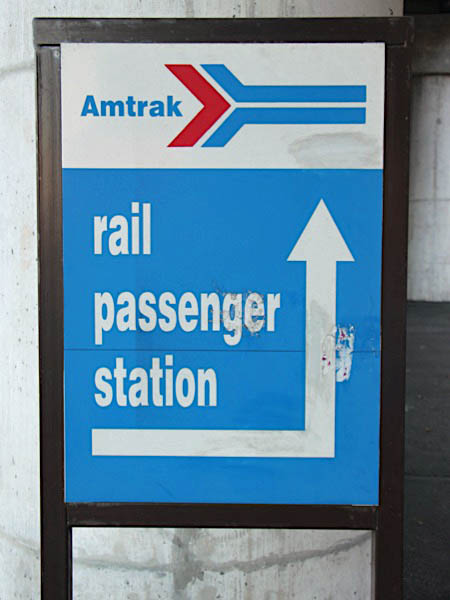
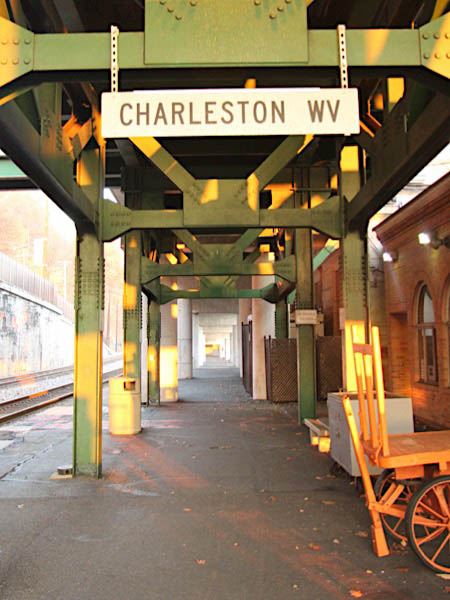
Dec 2017 / RWH

Charleston, WV / Dec 2017 / RWH
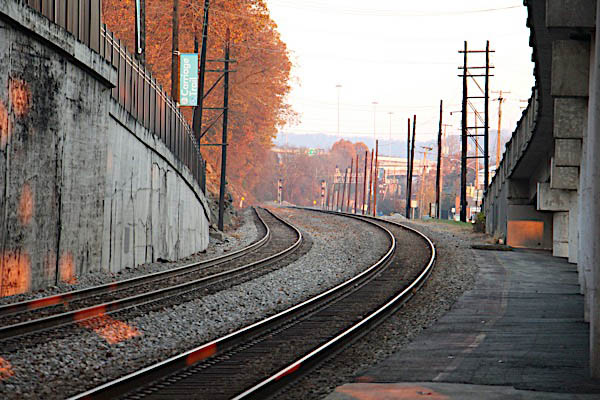
Charleston, WV / Dec 2017 / RWH
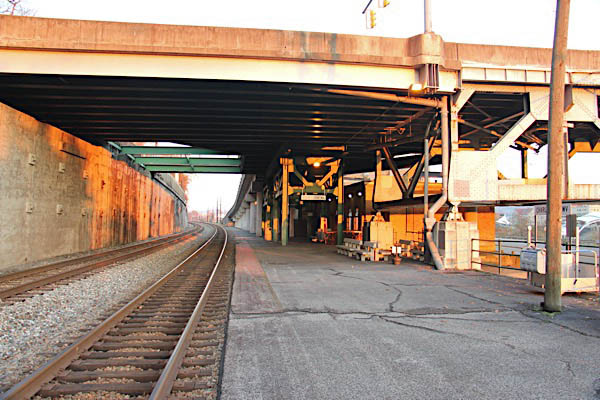
Charleston, WV / Dec 2017 / RWH

Charleston, WV / Dec 2017 / RWH

Charleston, WV / Dec 2017 / RWH
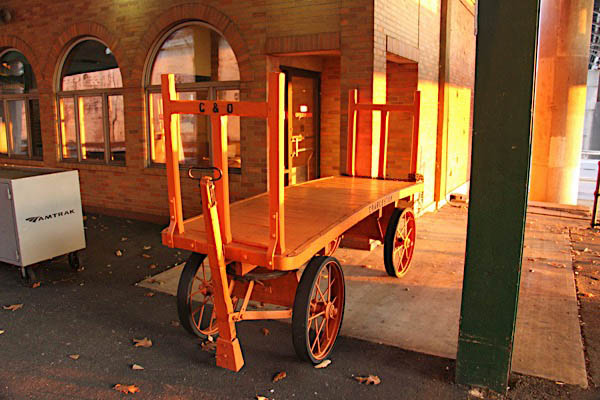
Charleston, WV / Dec 2017 / RWH
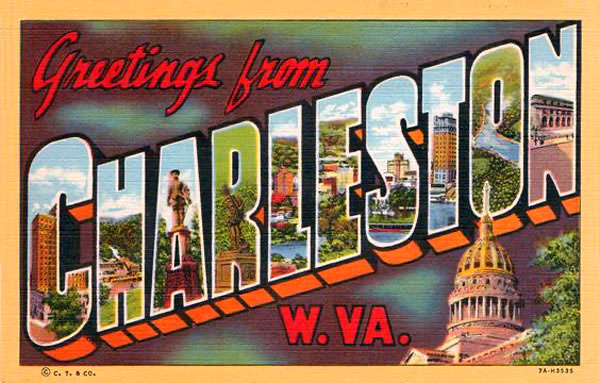
postcard / collection
 Huntington, WV
Huntington, WV

 Huntington, originally called Halderby's Landing, was named after Collis P. Huntington, a railroad baron who was a major partner in the Central Pacific Railroad, and who bought out the Chesapeake & Ohio Railway. In 1869 he began construction of the western terminus to the C & O, connecting the Ohio River and trains from the Midwest to the Atlantic Seaboard. The city was incorporated in 1871 by the West Virginia State Legislature. In 1873, the first locomotive arrived from Richmond to the celebration of the entire community. The railroad was the city's largest employer for a century, until eventually becoming part of CSX in the 1970s.
Huntington, originally called Halderby's Landing, was named after Collis P. Huntington, a railroad baron who was a major partner in the Central Pacific Railroad, and who bought out the Chesapeake & Ohio Railway. In 1869 he began construction of the western terminus to the C & O, connecting the Ohio River and trains from the Midwest to the Atlantic Seaboard. The city was incorporated in 1871 by the West Virginia State Legislature. In 1873, the first locomotive arrived from Richmond to the celebration of the entire community. The railroad was the city's largest employer for a century, until eventually becoming part of CSX in the 1970s.

Huntington, WV / Dec 2017 / RWH

Huntington, WV / Dec 2017 / RWH

Click to see the Huntington depot area plotted on a Google Maps page
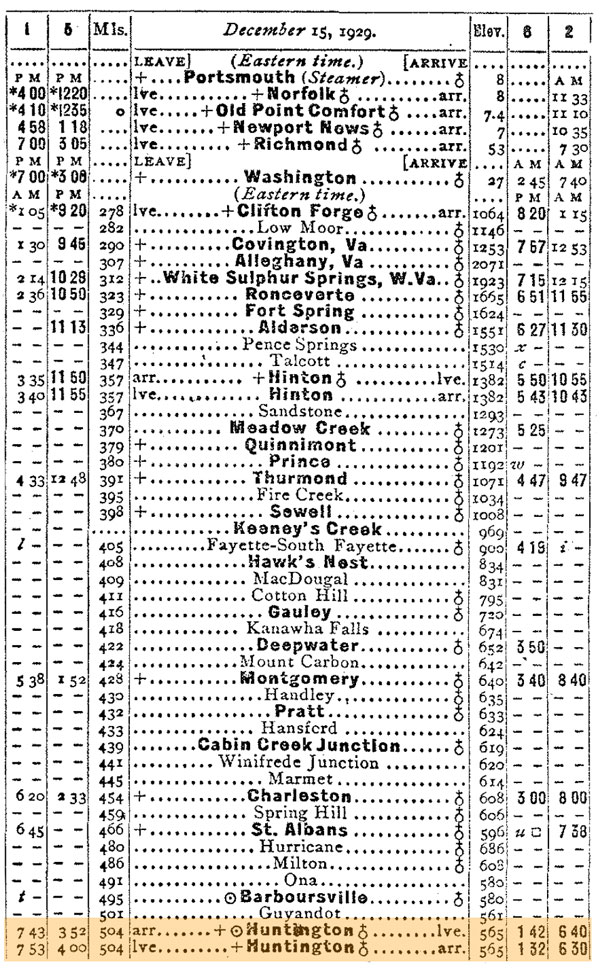
1930 Official Guide ad / collection
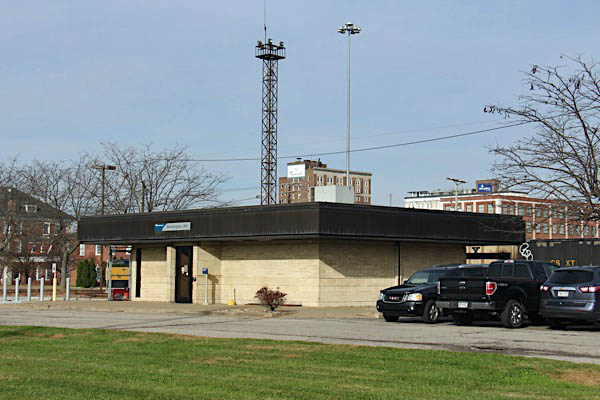
Huntington, WV / Dec 2017 / RWH
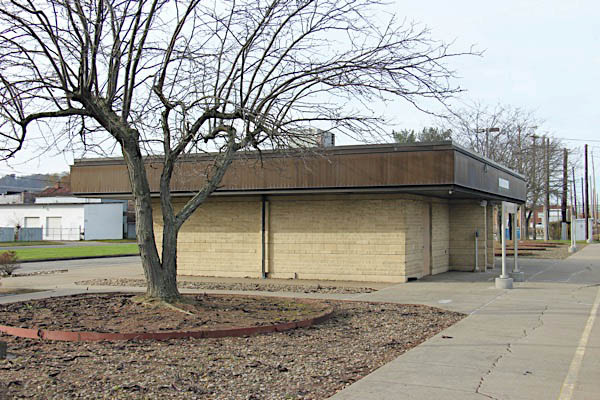
Huntington, WV / Dec 2017 / RWH

Huntington, WV / Dec 2017 / RWH
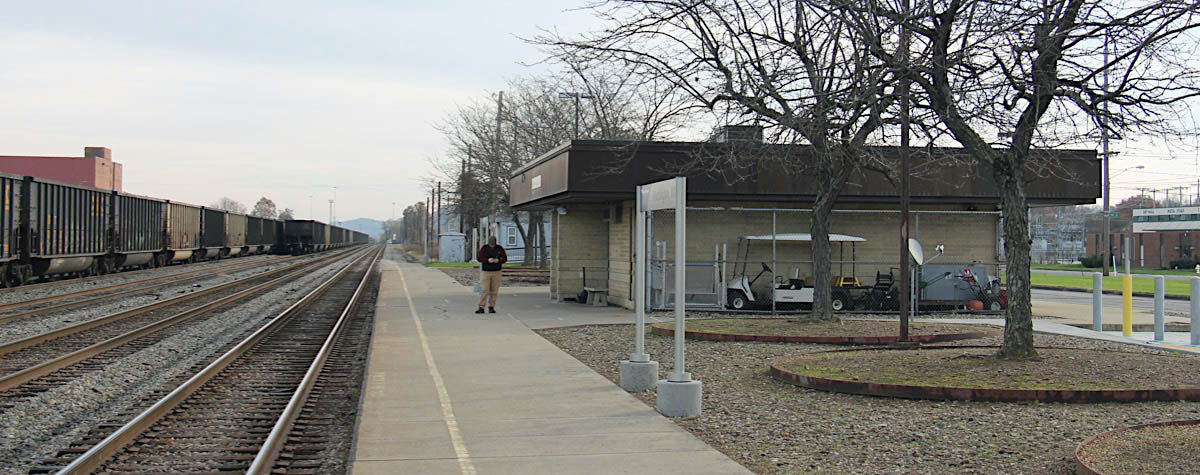
Huntington, WV / Dec 2017 / RWH
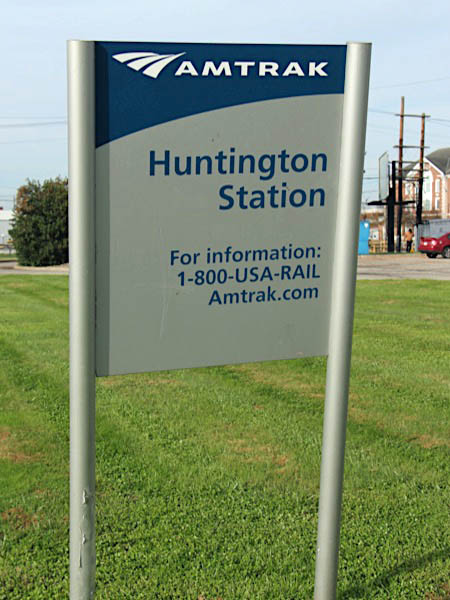
Dec 2017 / RWH

Huntington, WV / Dec 2017 / RWH
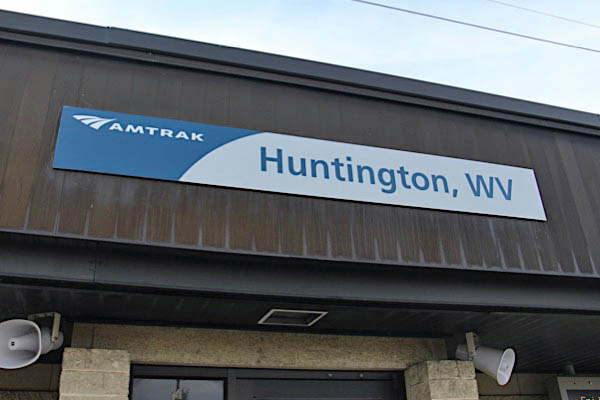
Huntington, WV / Dec 2017 / RWH
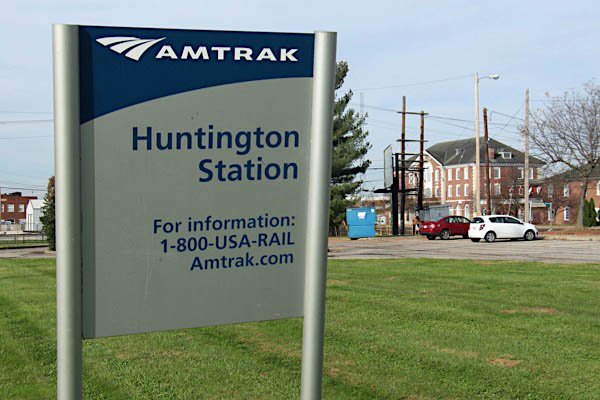
Huntington, WV / Dec 2017 / RWH
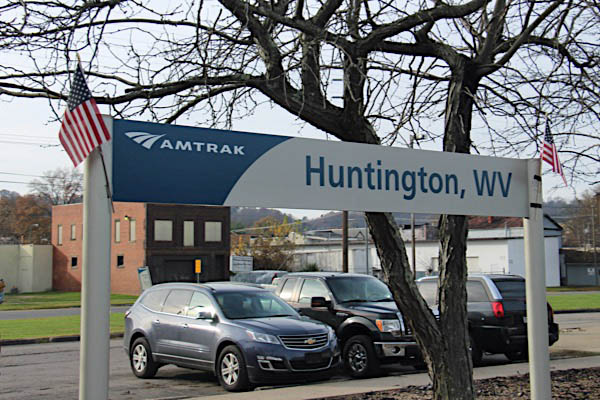
Huntington, WV / Dec 2017 / RWH

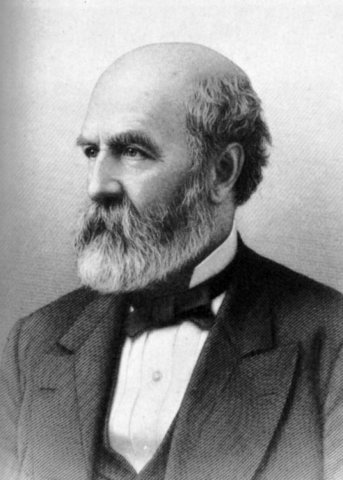 The modern brick, flat-roofed Huntington station was built in 1983, with a waiting room and ticket office. Amtrak recently updated its signage at this station, which is also a base for train crews.
The modern brick, flat-roofed Huntington station was built in 1983, with a waiting room and ticket office. Amtrak recently updated its signage at this station, which is also a base for train crews.
Huntington began as a railroad town and absorbed other surrounding settlements as it grew. Guyandotte, which dated back to the late 18th century, and which is now part of Huntington, was the county seat for Cabell County from 1809 to 1813. The village of Barboursville, a mile or so to the east, at the junction of the Mud and Guyandotte Rivers, was founded in 1813 and became the county seat until 1888, when it was moved to the new city of Huntington. Throughout this early period, this location on the Ohio River was a natural resting point for settlers moving westward toward Lexington from Virginia.
However, it was Halderby’s Landing on the Ohio River where Collis P. Huntington, president of the Chesapeake & Ohio (C&O) Railway (now CSX), chose to put the westernmost terminal of the C&O in 1869. And, in 1871, the city of Huntington was thus incorporated. In 1873, the first C&O locomotive steamed into Huntington, completing a connection from the Atlantic Seaboard to the Ohio River which served to turn Huntington into a bustling city. The C&O remained the city’s largest employer for the next century, with its large rail yards. Much of the city’s fine architecture dates from this period of railroad dominance.
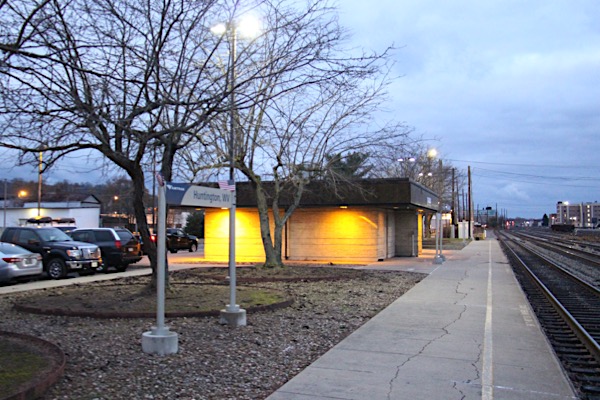
Huntington, WV / Dec 2017 / RWH
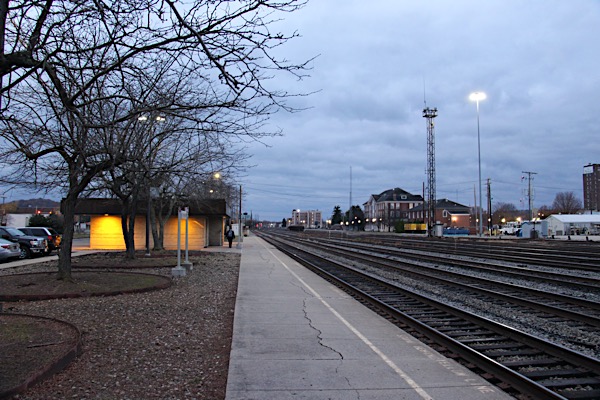
Huntington, WV / Dec 2017 / RWH
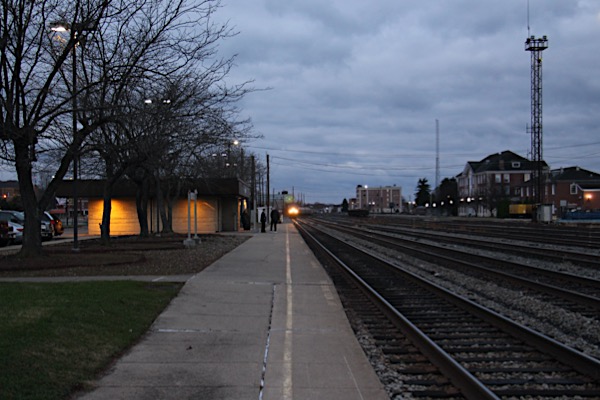


Huntington, WV / Dec 2017 / RWH
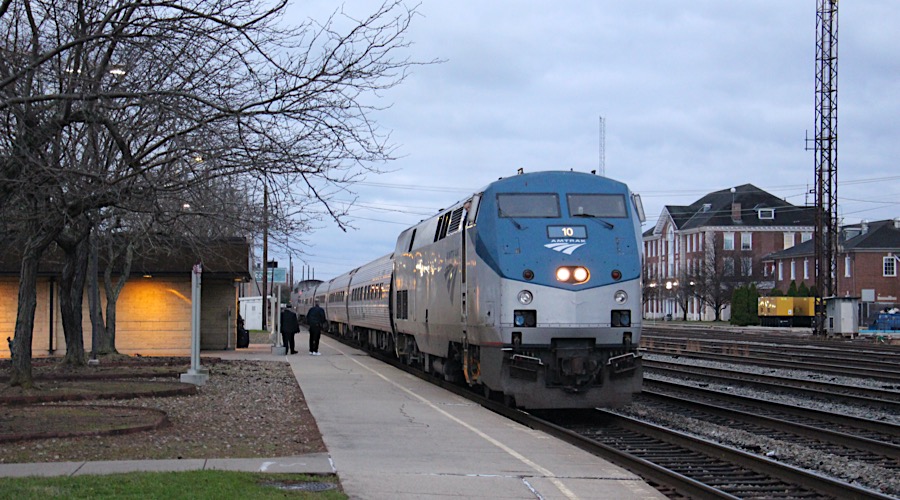
Huntington, WV / Dec 2017 / RWH
 Locomotive Crew Change
Locomotive Crew Change

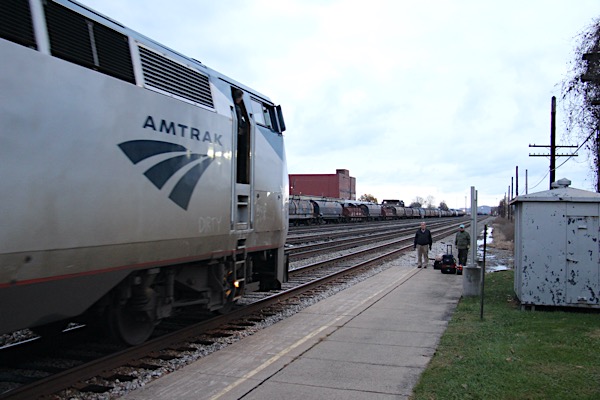
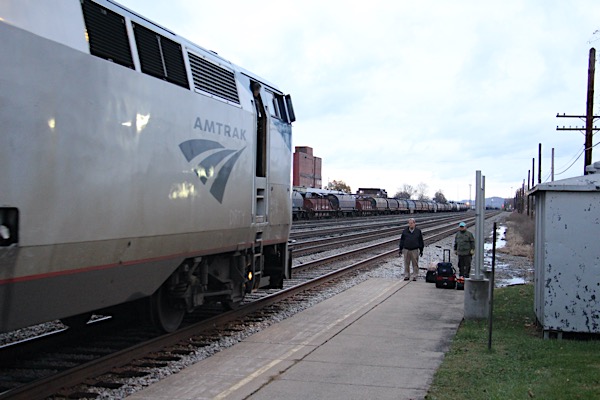
Huntington, WV / Dec 2017 / RWH
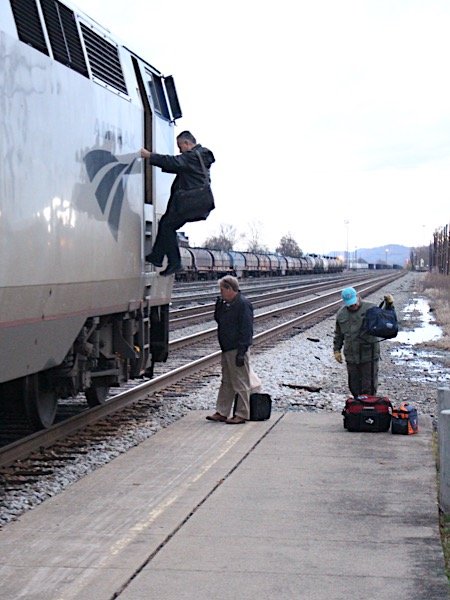
Dec 2017 / RWH

Huntington, WV / Dec 2017 / RWH
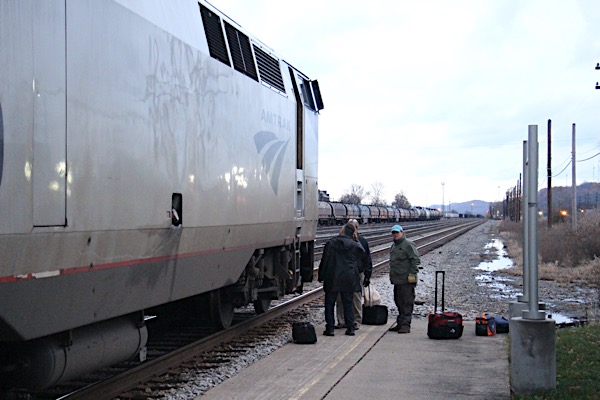
Huntington, WV / Dec 2017 / RWH
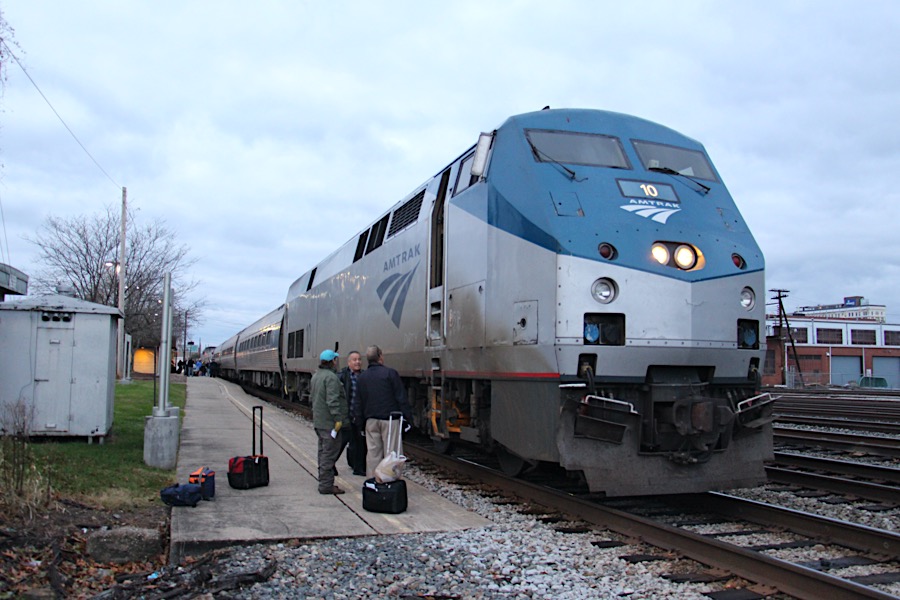
Huntington, WV / Dec 2017 / RWH
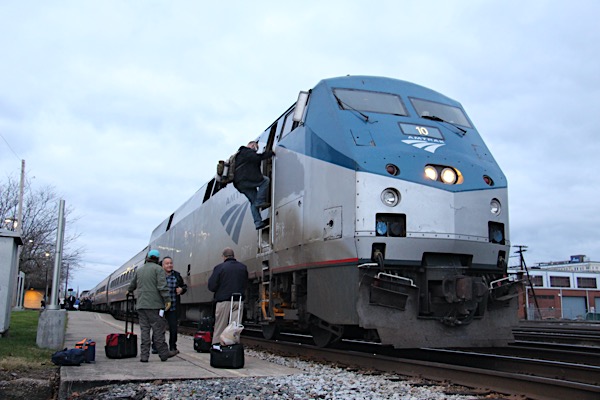

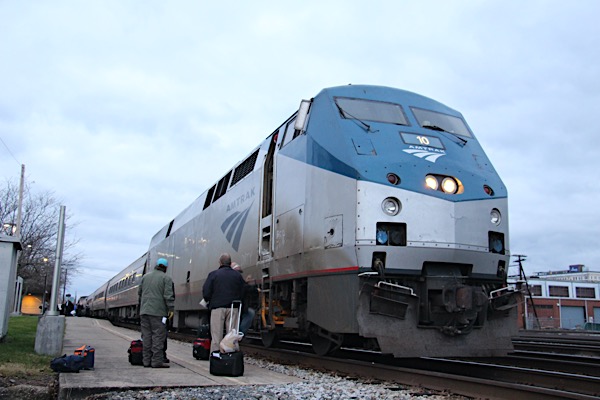
Huntington, WV / Dec 2017 / RWH

Huntington, WV / Dec 2017 / RWH

Huntington, WV / Dec 2017 / RWH

Amtrak #10
Huntington, WV / Dec 2017 / RWH


Amtrak #10

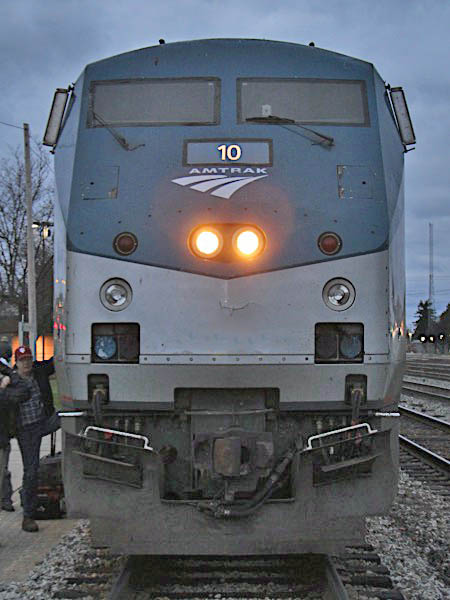
Dec 2017 / RWH
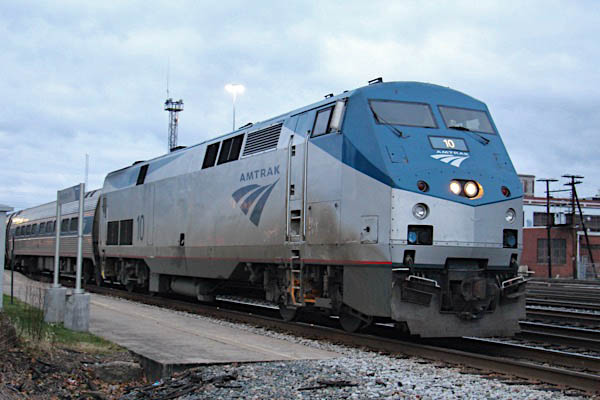
Huntington, WV / Dec 2017 / RWH
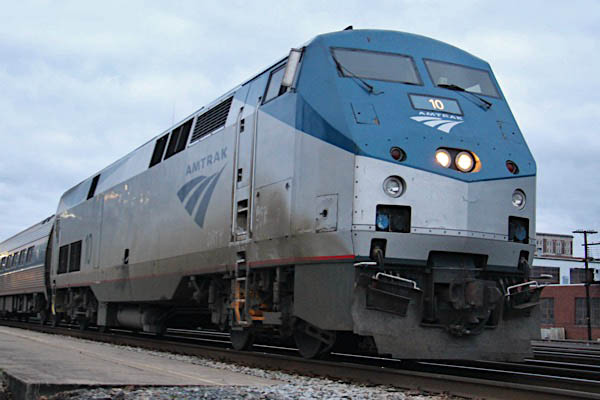
Huntington, WV / Dec 2017 / RWH
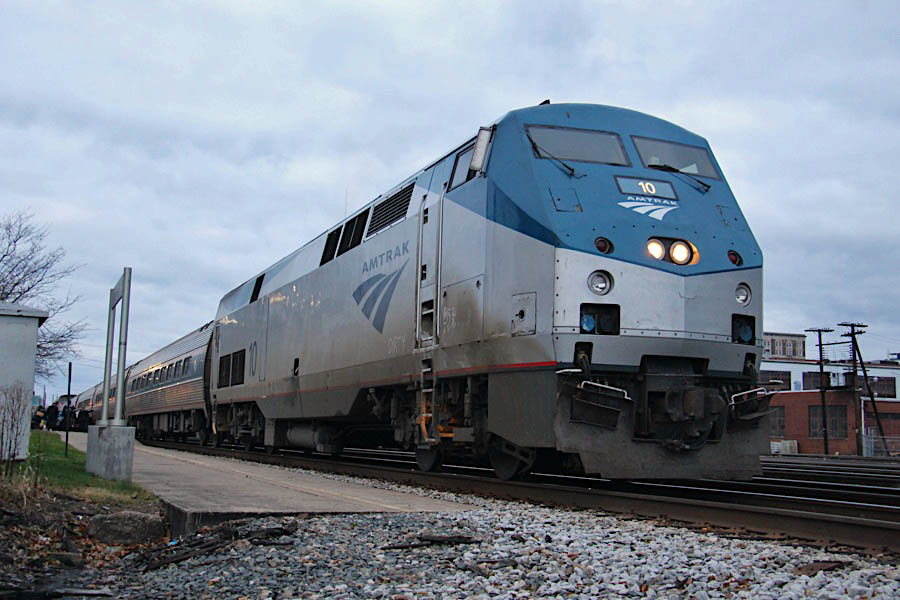
Huntington, WV / Dec 2017 / RWH
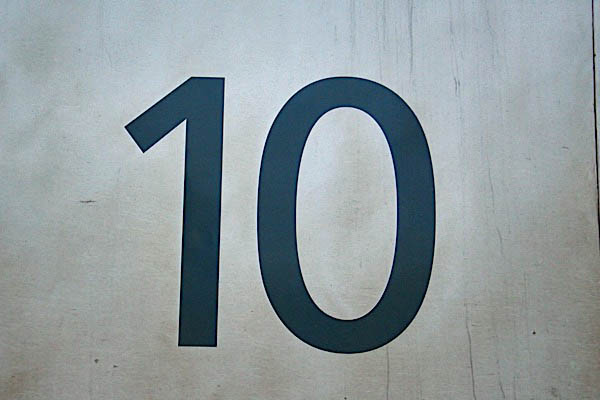
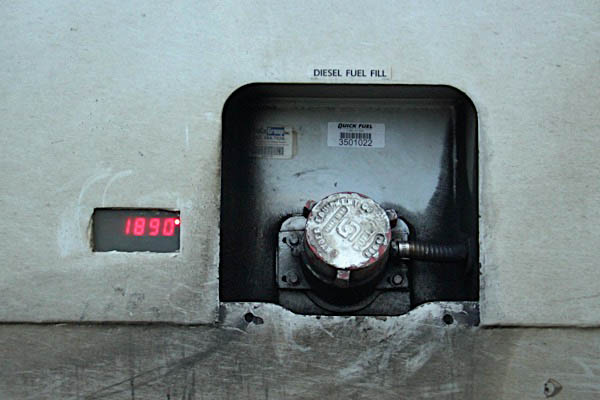

Dec 2017 / RWH
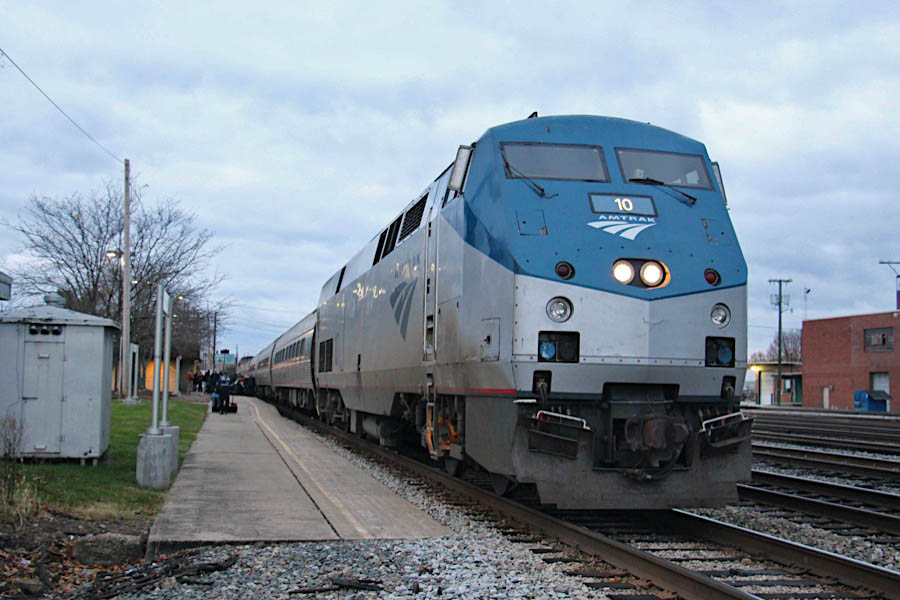
Huntington, WV / Dec 2017 / RWH

Huntington, WV / Dec 2017 / RWH
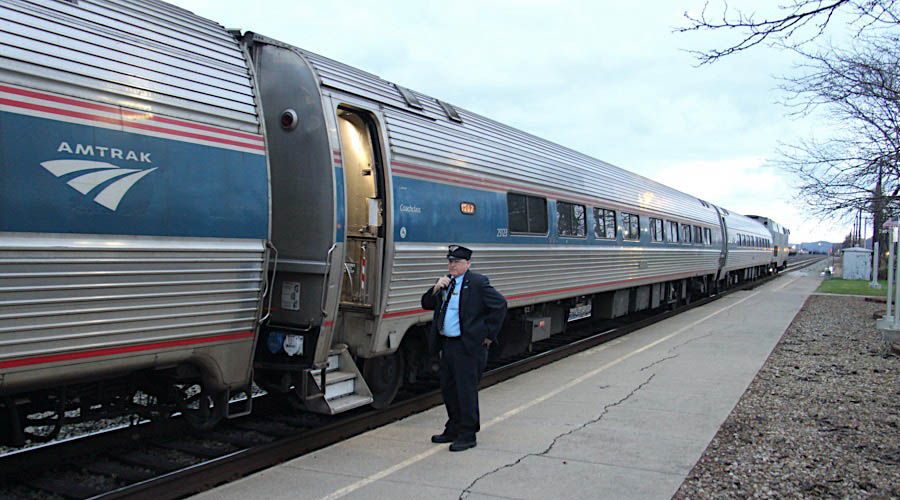
Huntington, WV / Dec 2017 / RWH
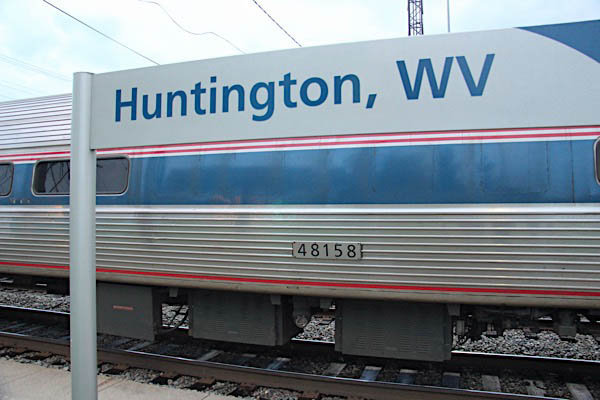
Huntington, WV / Dec 2017 / RWH

Huntington, WV / Dec 2017 / RWH
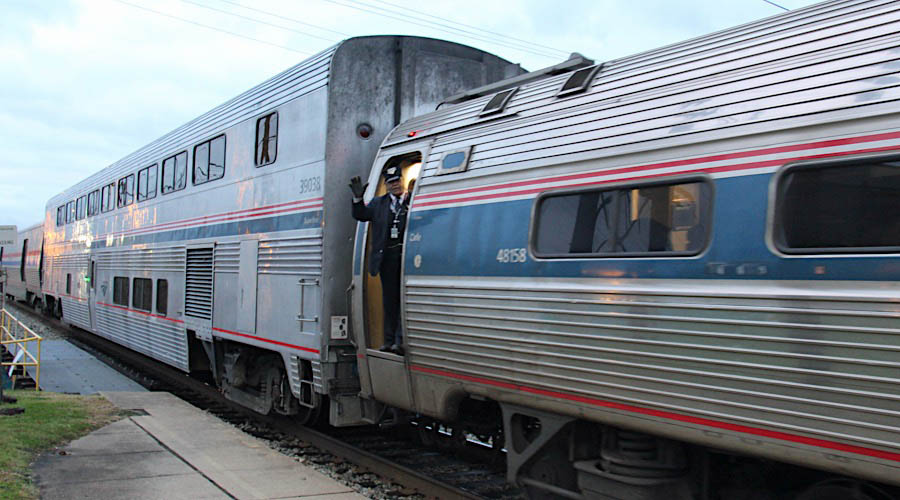
Huntington, WV / Dec 2017 / RWH
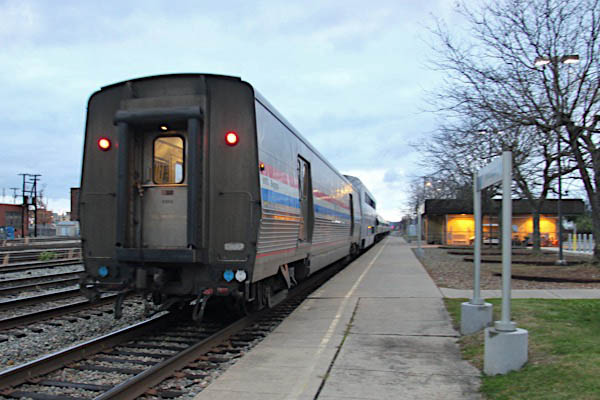
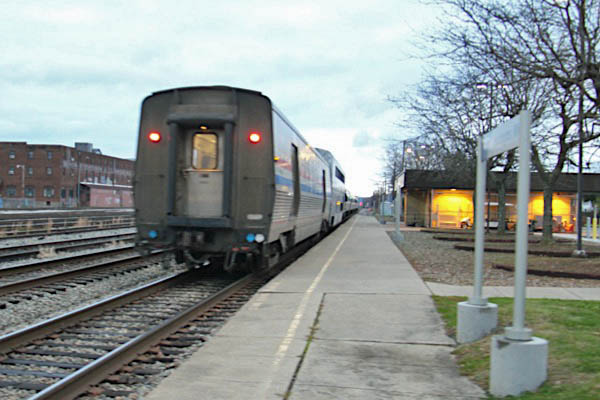

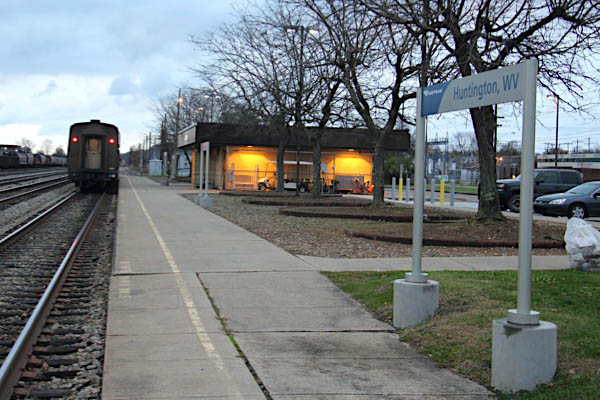
Huntington, WV / Dec 2017 / RWH

Huntington, WV / Dec 2017 / RWH
 Ashland, Ky
Ashland, Ky

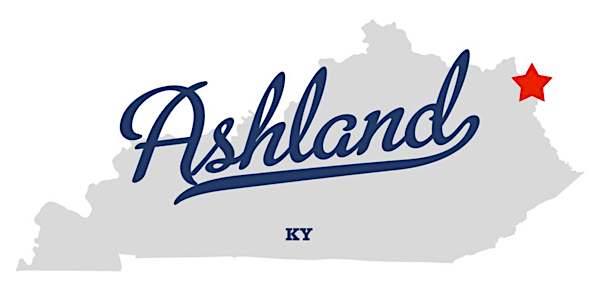 Customers at Ashland use a shelter on the platform across from the city’s transportation center, which was built in 1906 as a freight depot for the Chesapeake & Ohio (C&O) Railway. In 1997, the city of Ashland purchased the depot and restored it using $525,000 in federal funds from the Intermodal Surface Transportation Enhancement Act (ISTEA) of 1991. The transportation center is served by long-distance buses and local buses, and includes a waiting room, restrooms and an events space that can be rented. The facility is not open when the Cardinal makes its early morning and late evening stops.
Customers at Ashland use a shelter on the platform across from the city’s transportation center, which was built in 1906 as a freight depot for the Chesapeake & Ohio (C&O) Railway. In 1997, the city of Ashland purchased the depot and restored it using $525,000 in federal funds from the Intermodal Surface Transportation Enhancement Act (ISTEA) of 1991. The transportation center is served by long-distance buses and local buses, and includes a waiting room, restrooms and an events space that can be rented. The facility is not open when the Cardinal makes its early morning and late evening stops.
The original C&O station, a spacious and classic multi-story brick structure with a porticoed entrance and large arched windows, was completed in 1925 and stands a few blocks away. It now houses a bank; some of its passenger canopy has been preserved, and a former passenger car still sits on the bank lot. Amtrak stopped at this facility from 1971 until 1975, when a pending change to the rail alignment caused Amtrak to move five miles south from Ashland to Catlettsburg. Amtrak relocated to the site of the Ashland Transportation Center on March 11, 1998, and the Catlettsburg station was then closed.
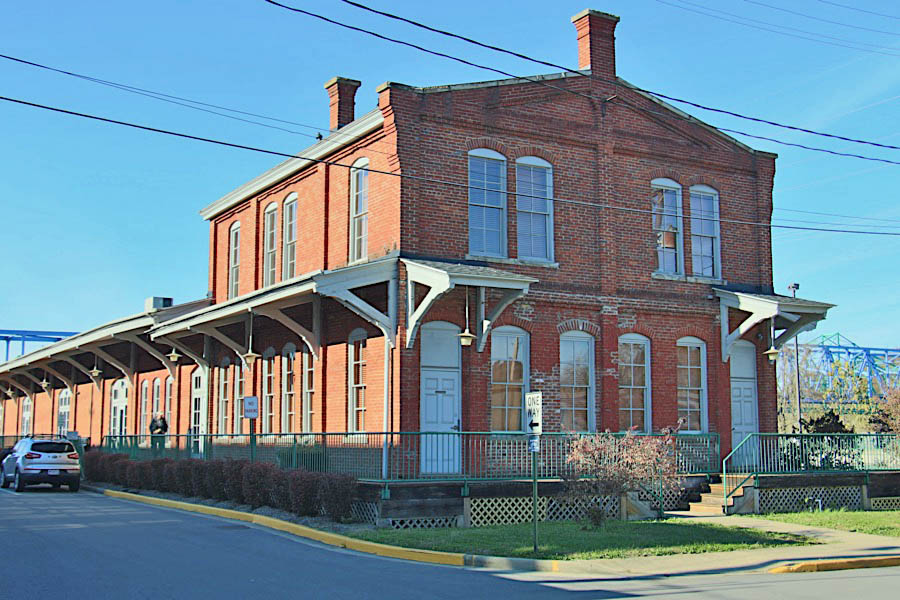
Ashland, Ky / Dec 2017 / RWH

Click to see the Ashland depot area plotted on a Google Maps page
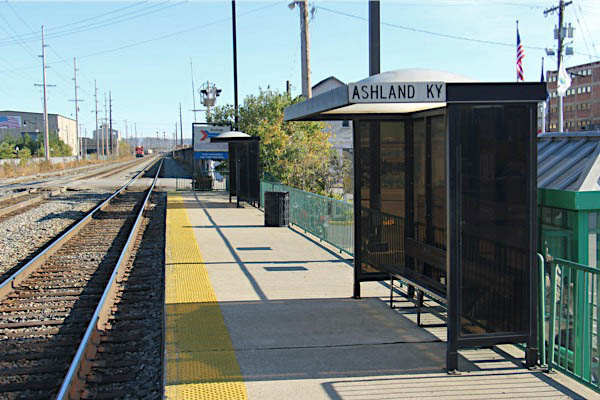
Ashland, Ky / Dec 2017 / RWH
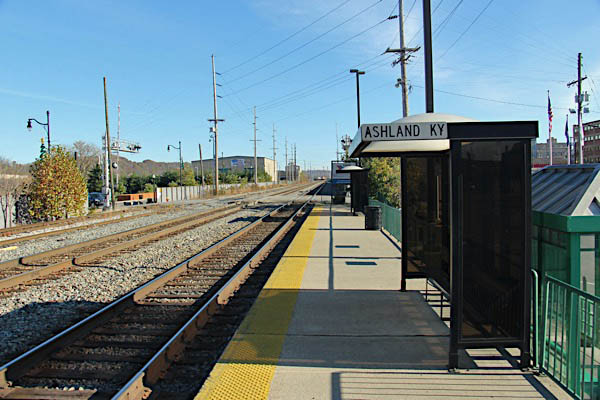
Ashland, Ky / Dec 2017 / RWH
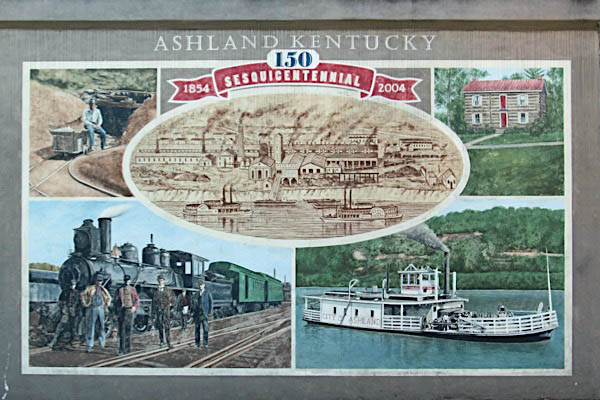
Ashland, Ky / Dec 2017 / RWH

Ashland, Ky / Dec 2017 / RWH

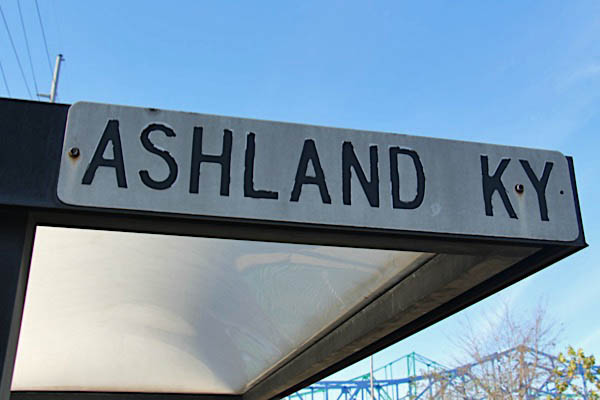
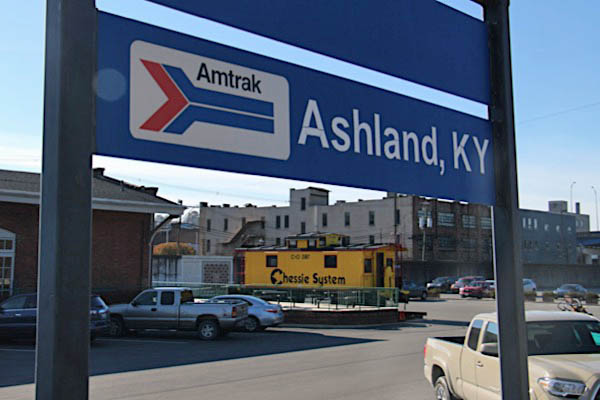
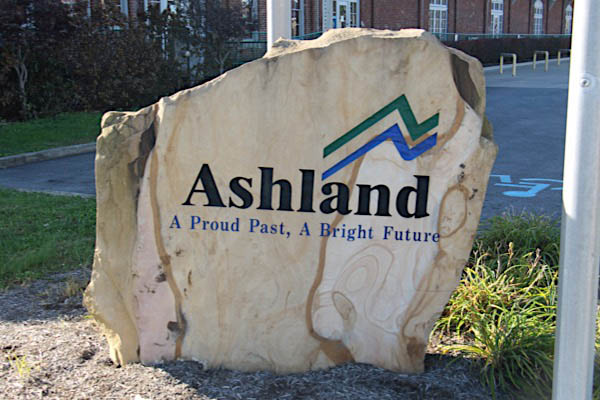
Ashland, Ky / Dec 2017 / RWH
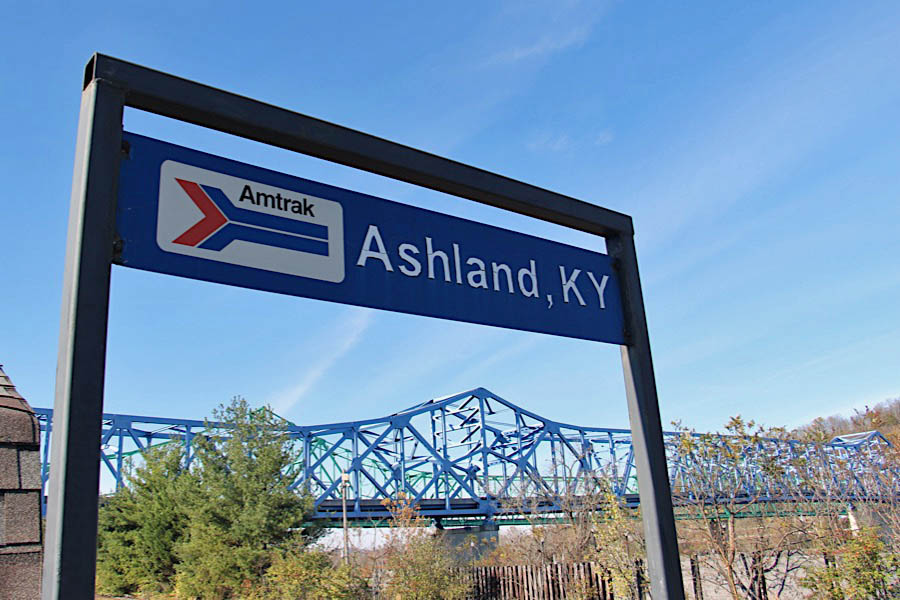
Ashland, Ky / Dec 2017 / RWH
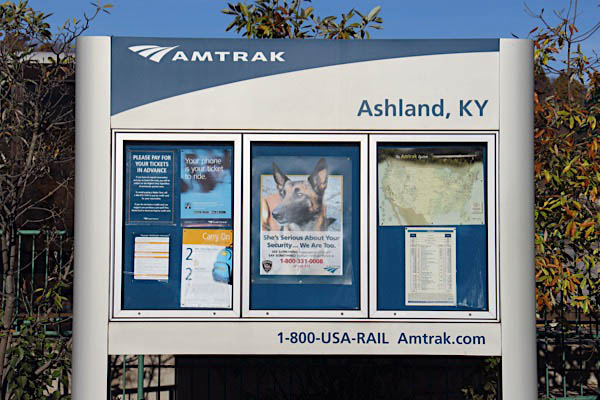
Ashland, Ky / Dec 2017 / RWH
 Ohio River Bridge
Ohio River Bridge

Bridgehunter.com
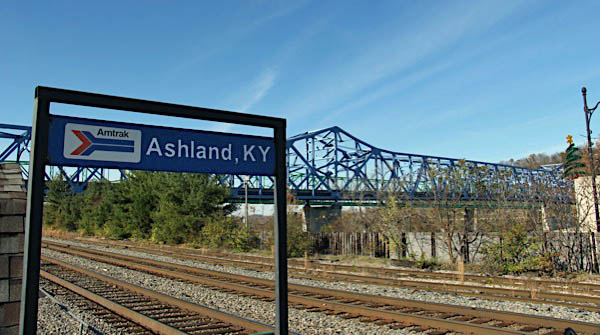
Ashland, Ky / Dec 2017 / RWH
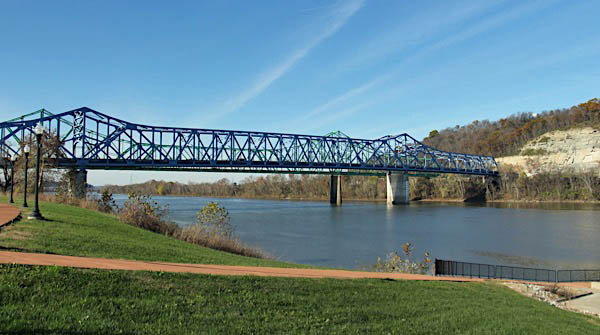
Ashland, Ky / Dec 2017 / RWH
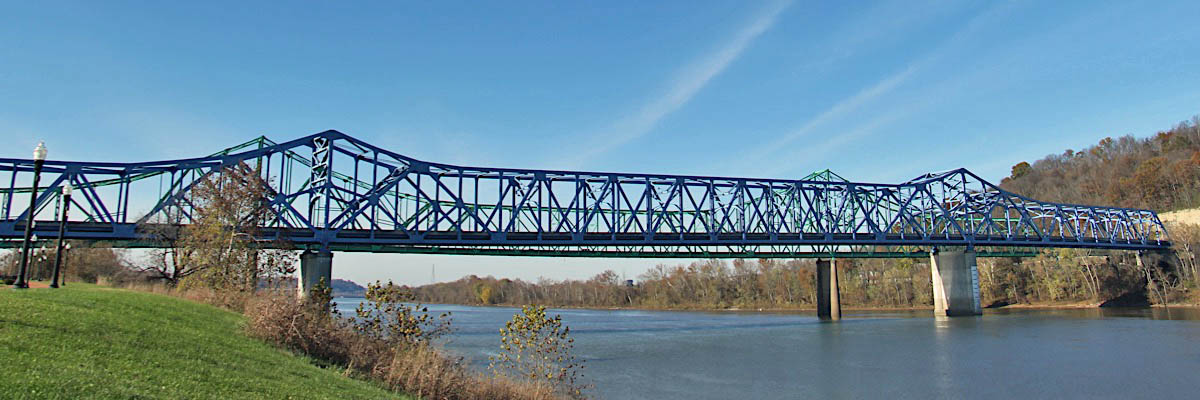
Ashland, Ky / Dec 2017 / RWH

Ashland, Ky / Dec 2017 / RWH
 CSX Mainline Action
CSX Mainline Action
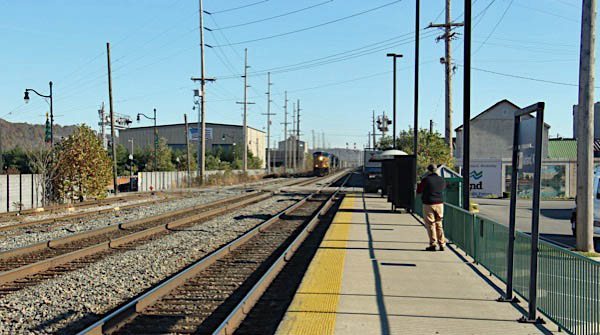
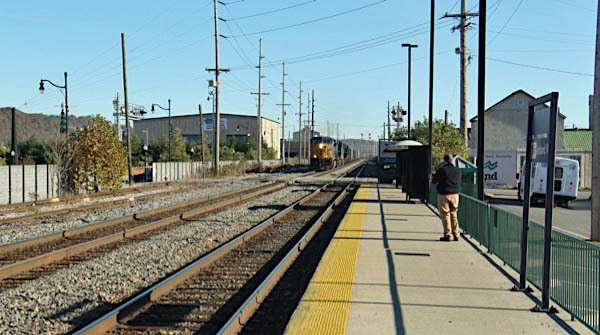
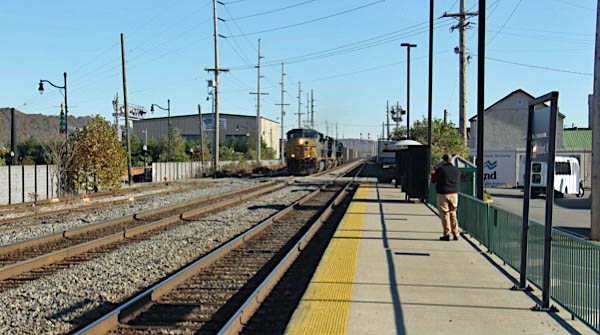

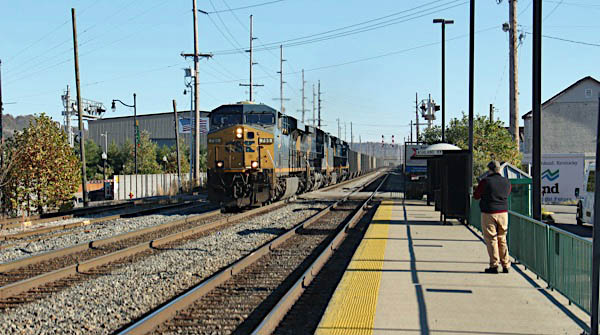
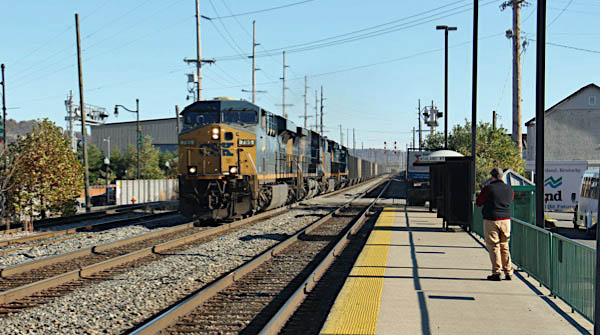
Ashland, Ky / Dec 2017 / RWH
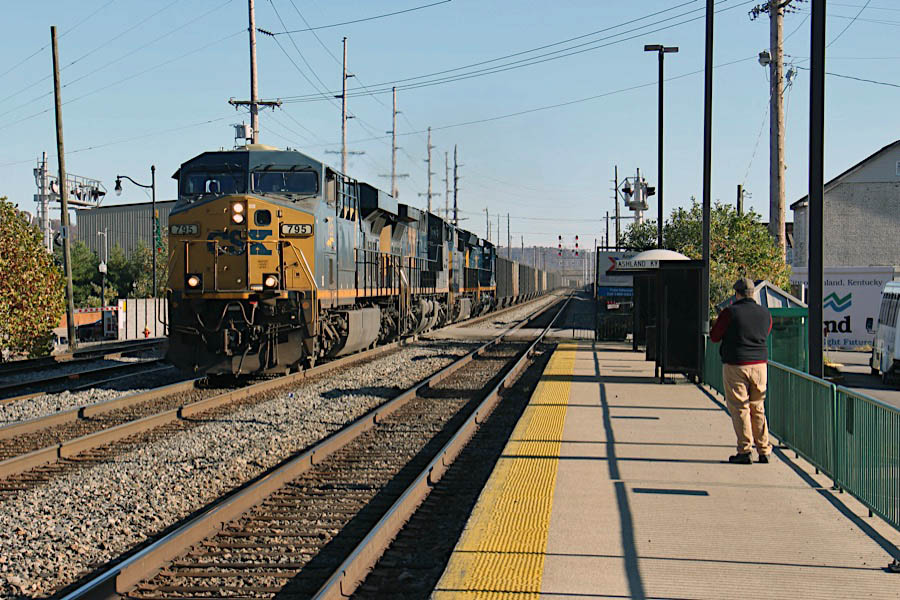
Ashland, Ky / Dec 2017 / RWH
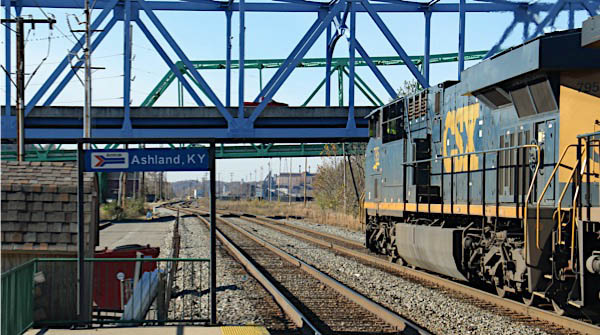
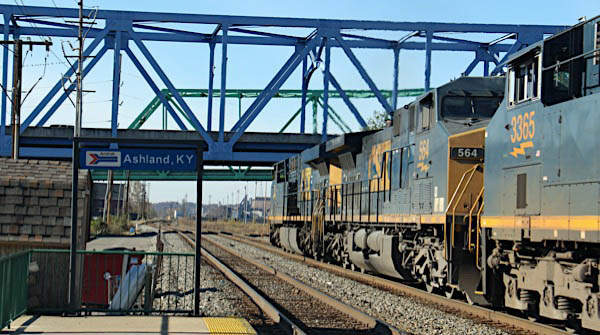
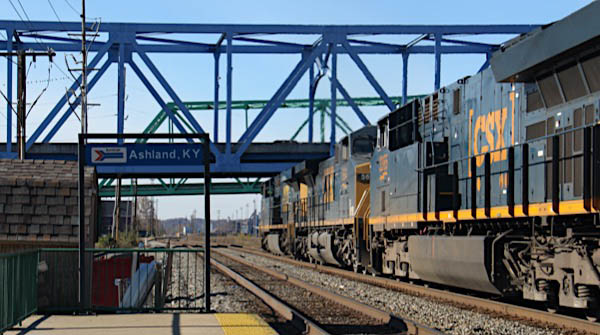
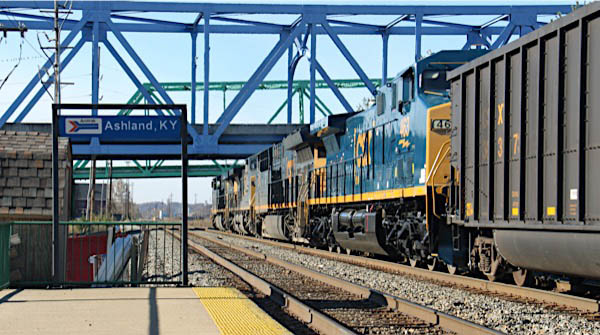
Ashland, Ky / Dec 2017 / RWH
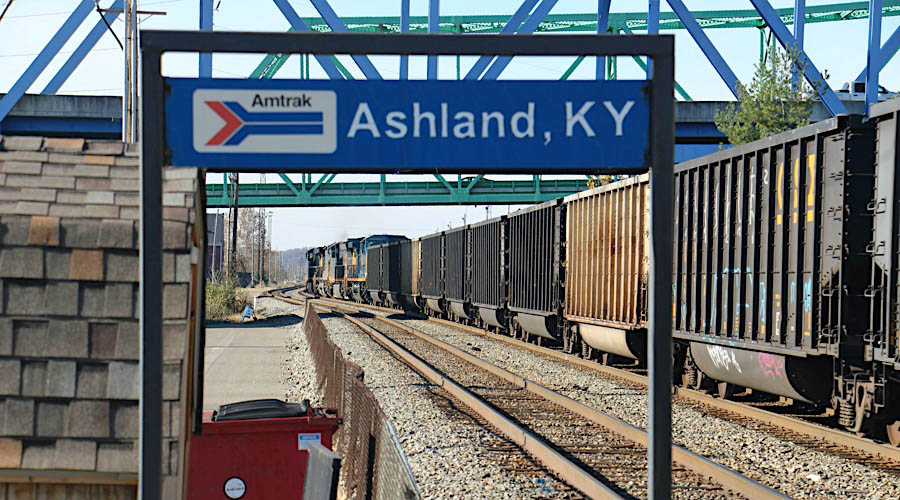
Ashland, Ky / Dec 2017 / RWH

Ashland, Ky / Dec 2017 / RWH
 Chicago, Il
Chicago, Il
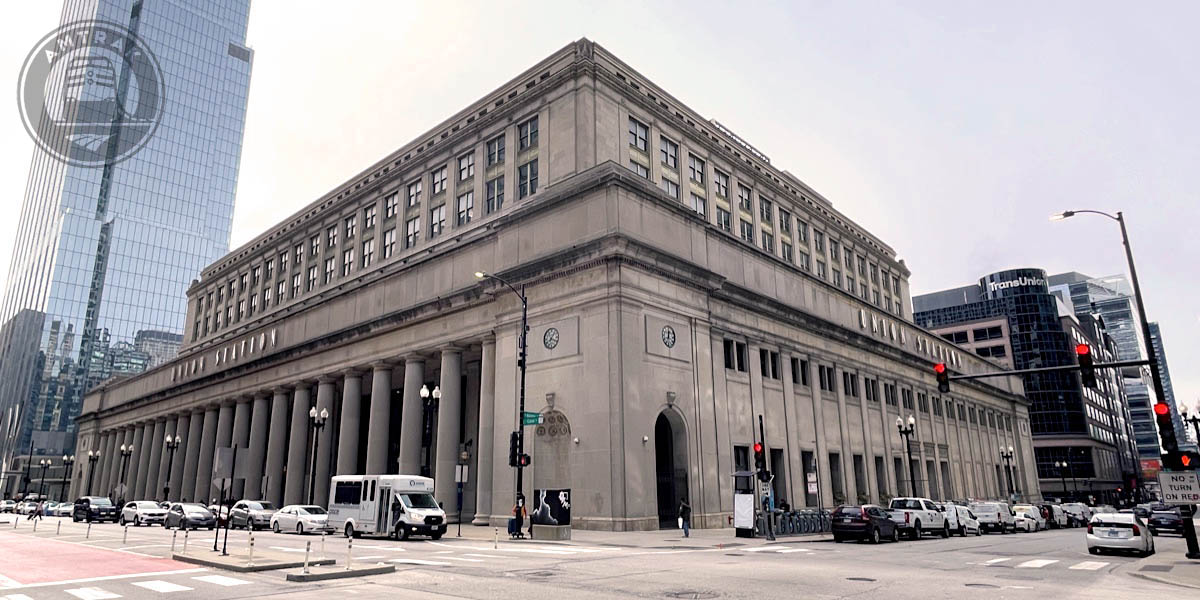
Chicago Union Station
Chicago, Il / Mar 2023 / RWH
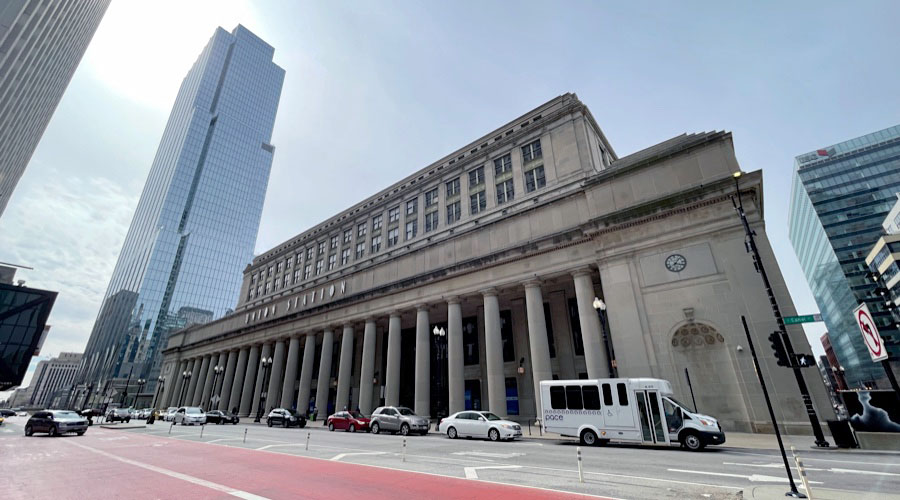
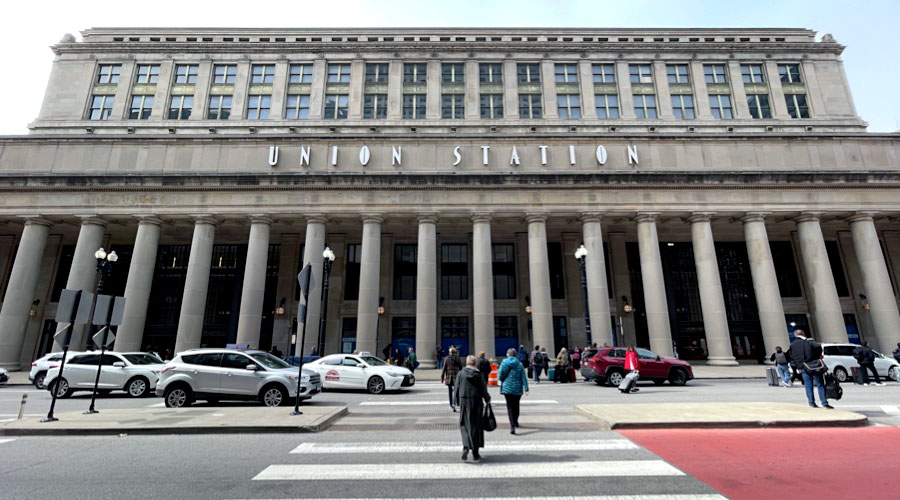
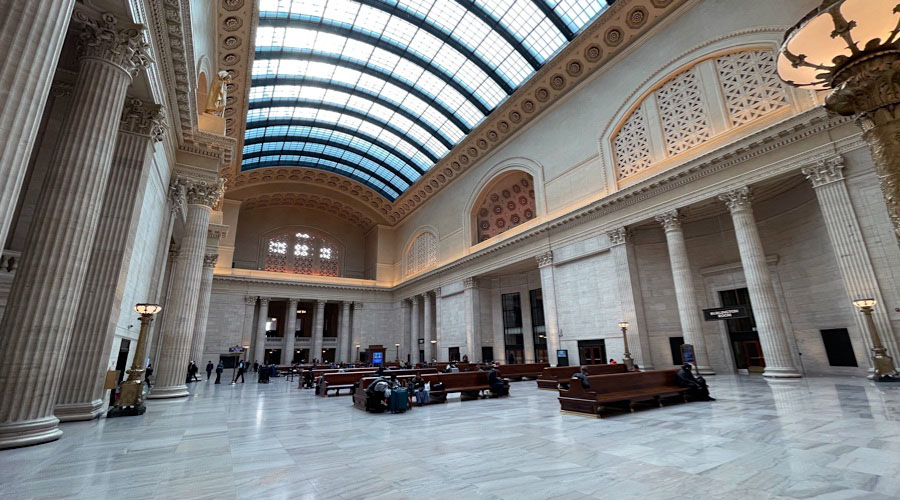
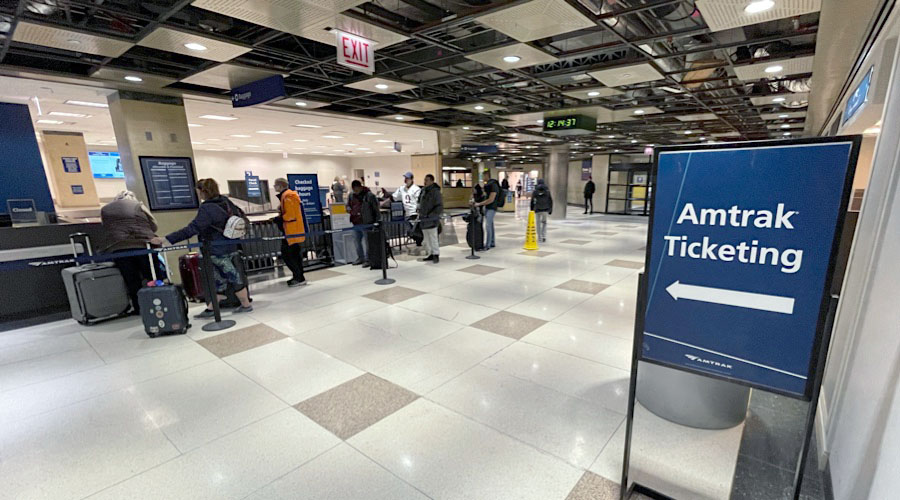
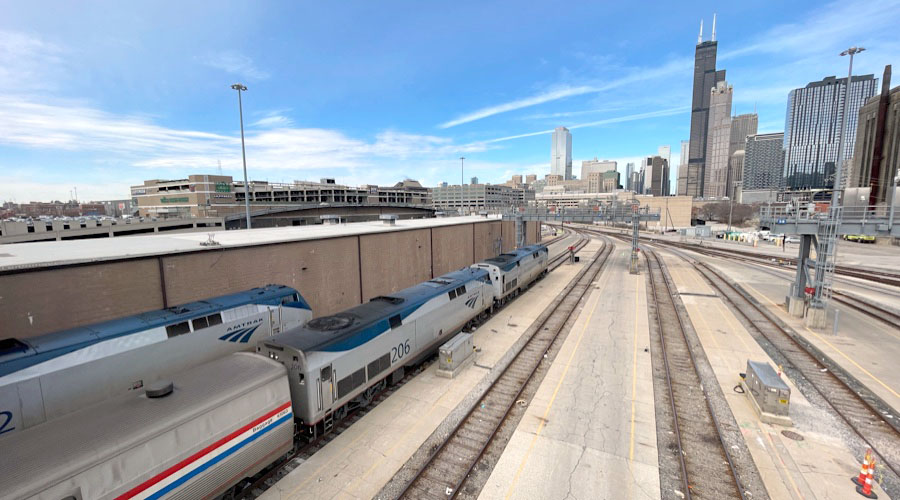

See our complete Chicago Union Station scrapbook in Amtrak Great Stations
 Lagniappe
Lagniappe

Number Fifty Forthcoming
Thurmond, WV / May 2016 / RWH
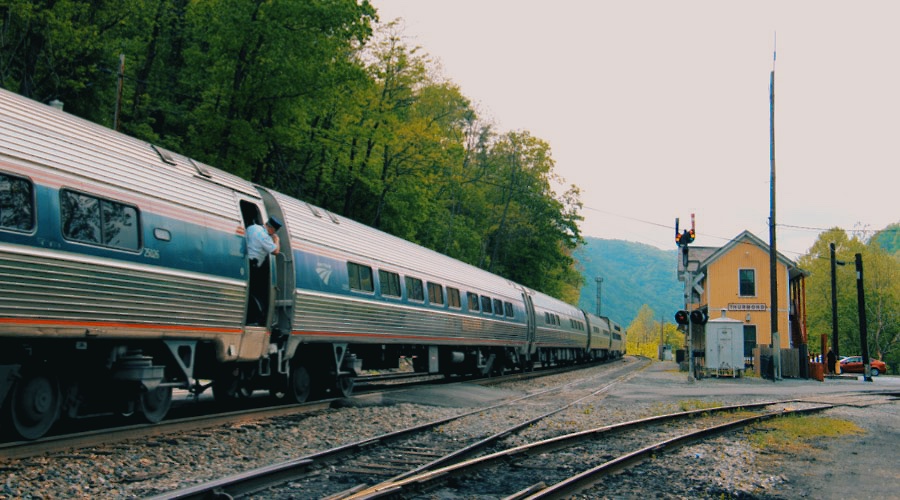
The Cardinal Calls on Thurmond
Thurmond, WV / May 2016 / RWH
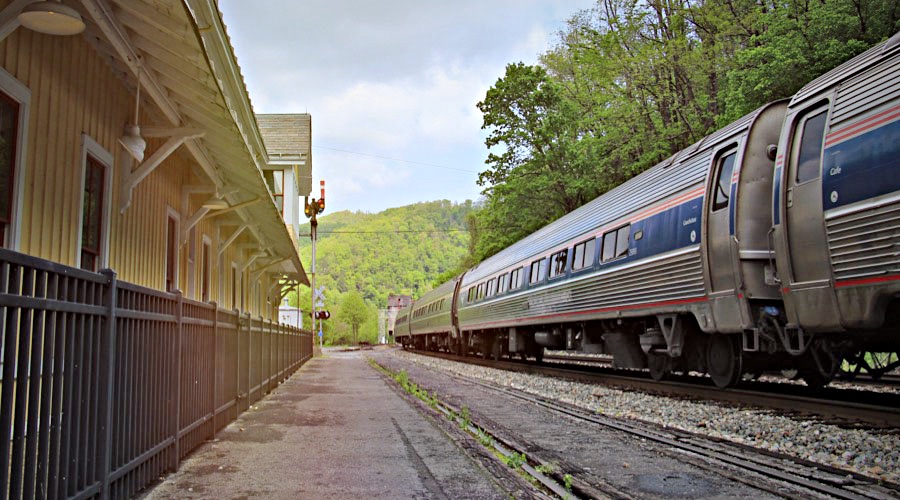
Curtain Call on the Cardinal
Thurmond, WV / May 2016 / RWH
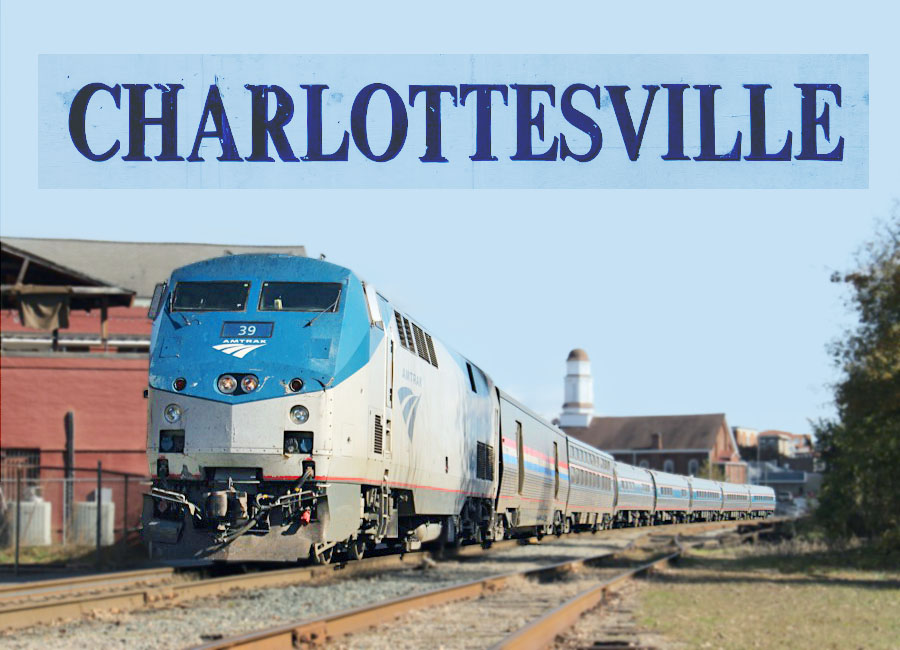
The Cardinal Calls on Charlottesville
Charlottesville, Va / Nov 2016 / RWH
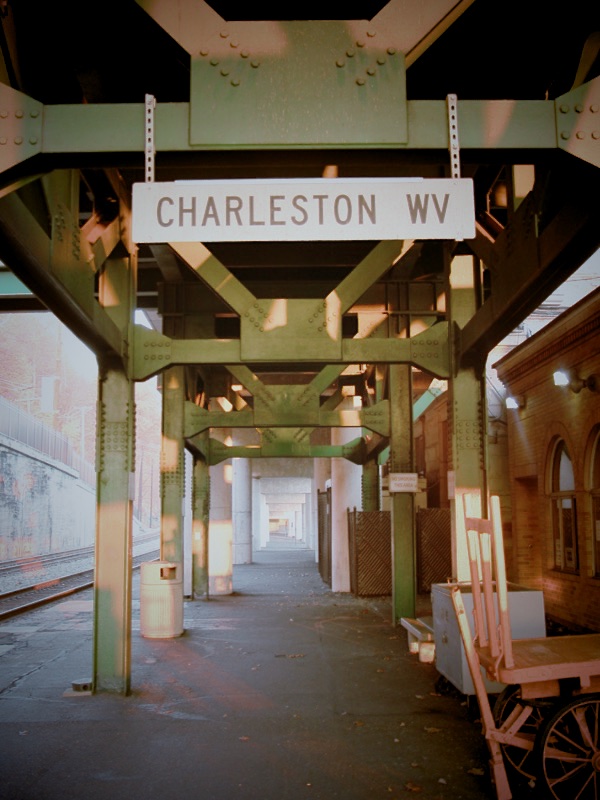
Ghost Town
Dec 2017 / RWH
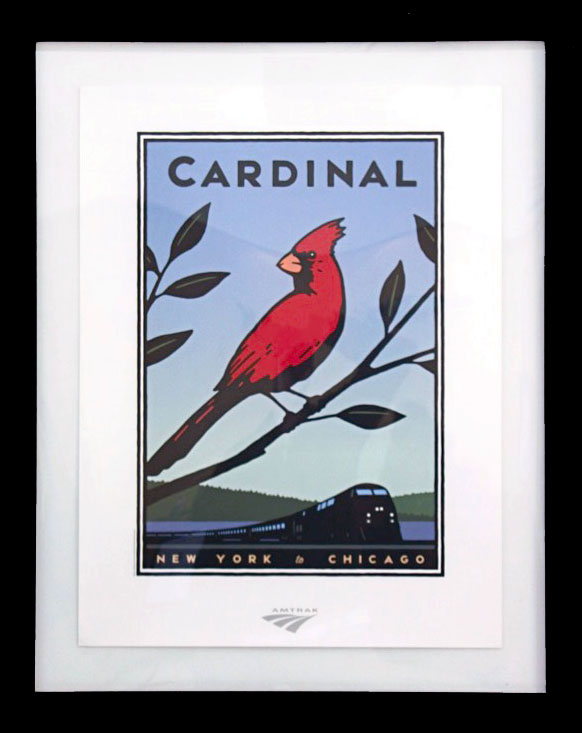
The Red Bird of Happiness
Nov 2016 / RWH
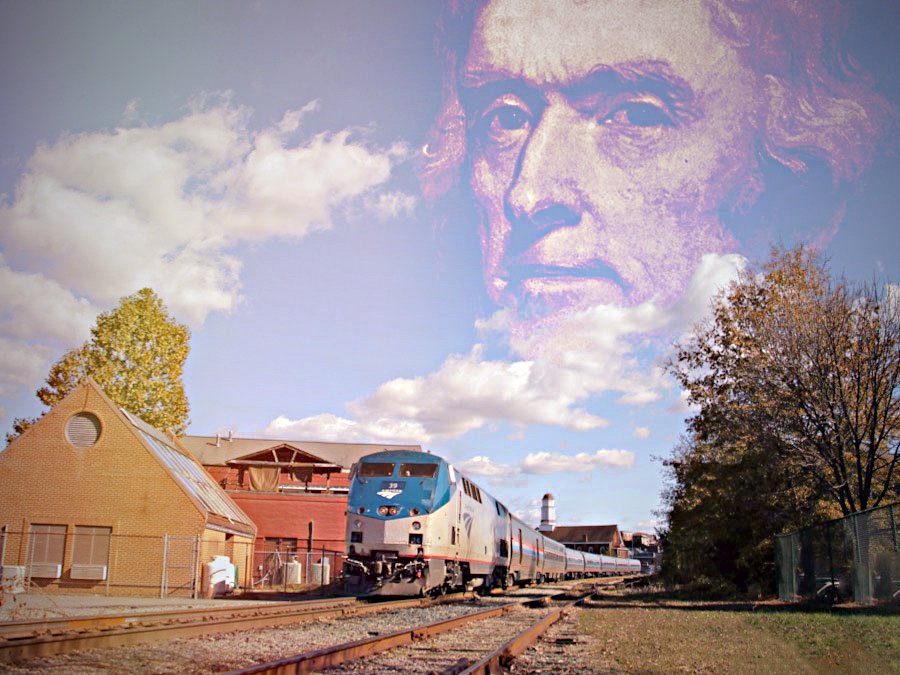
Mr. Jefferson's Railroad
Charlottesville, Va / Nov 2016 / RWH
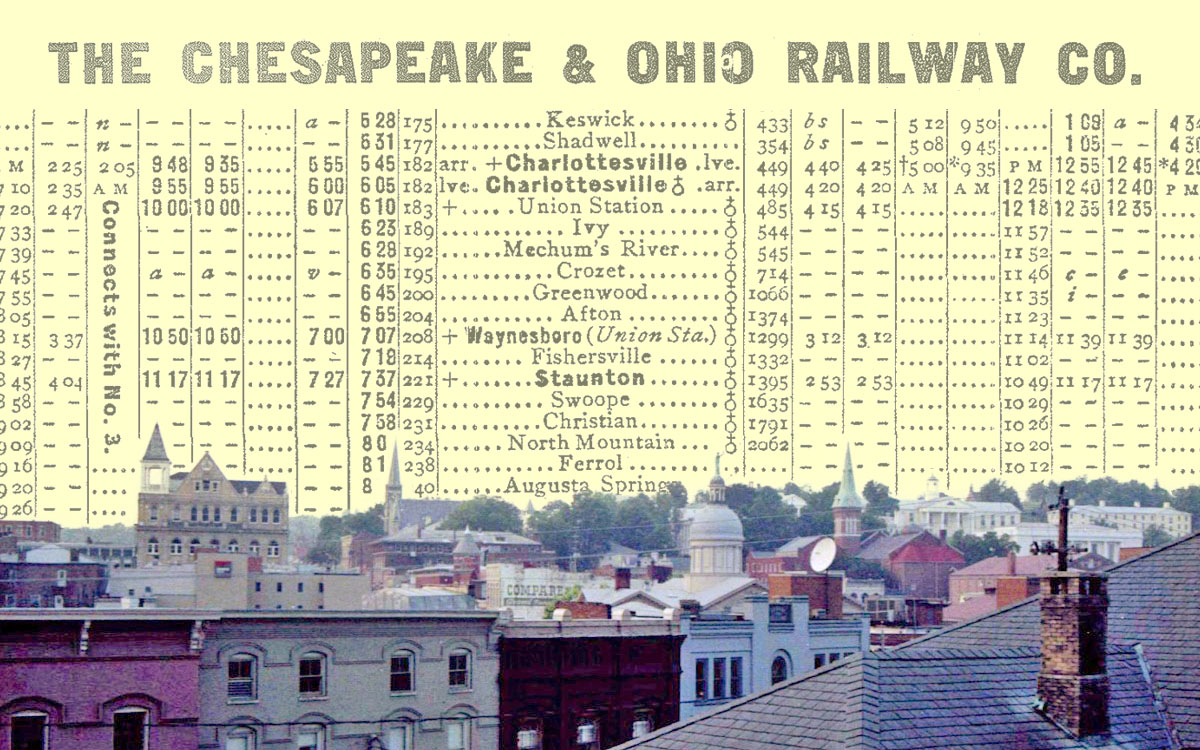
The Clifton Forge Division
photo and artwork RWH
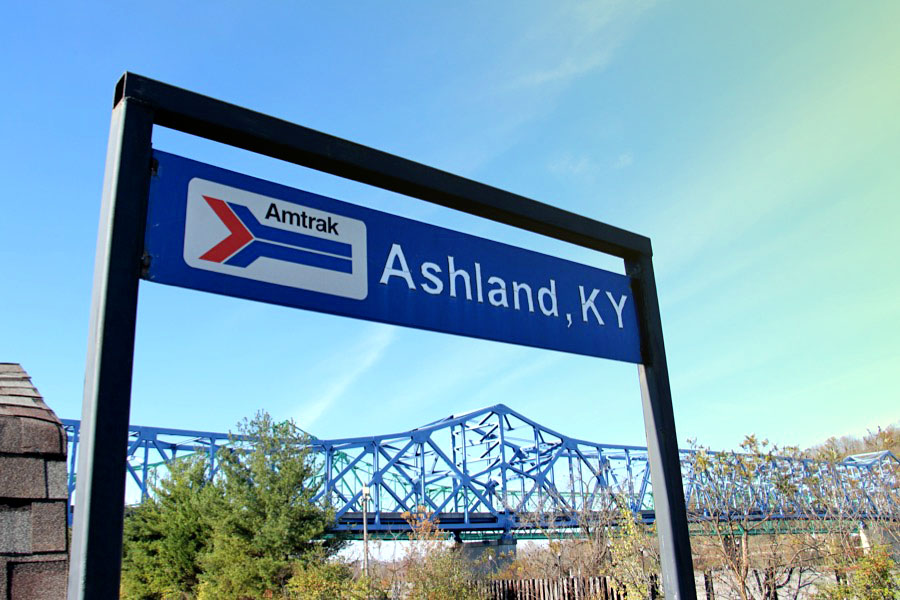
Start of the Kentucky Derby
Ashland, Ky / Dec 2017 / RWH
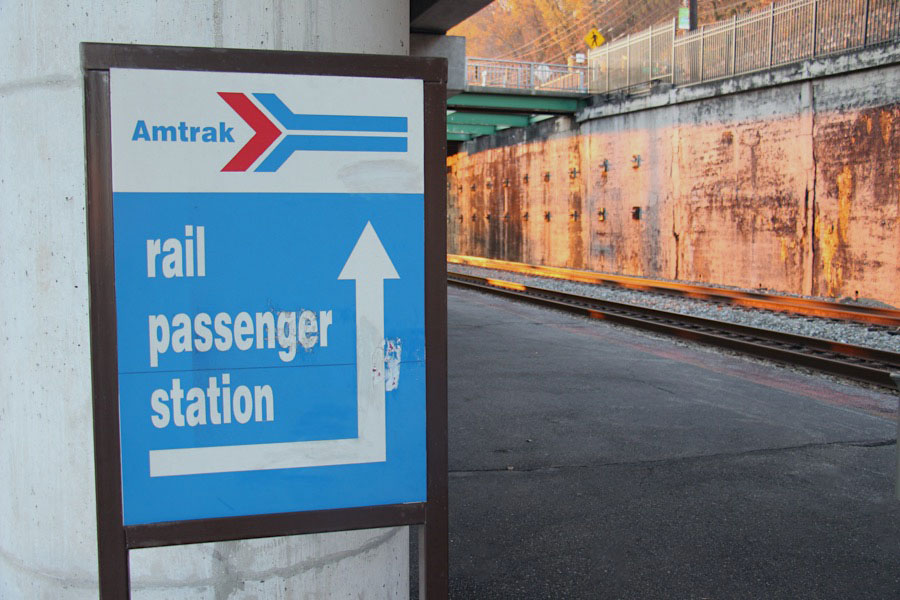
Still Kickin' It Old School
Charleston, WV / Dec 2017 / RWH

Genesis chapter Thirty Nine
Charlottesville, Va / Nov 2016 / RWH
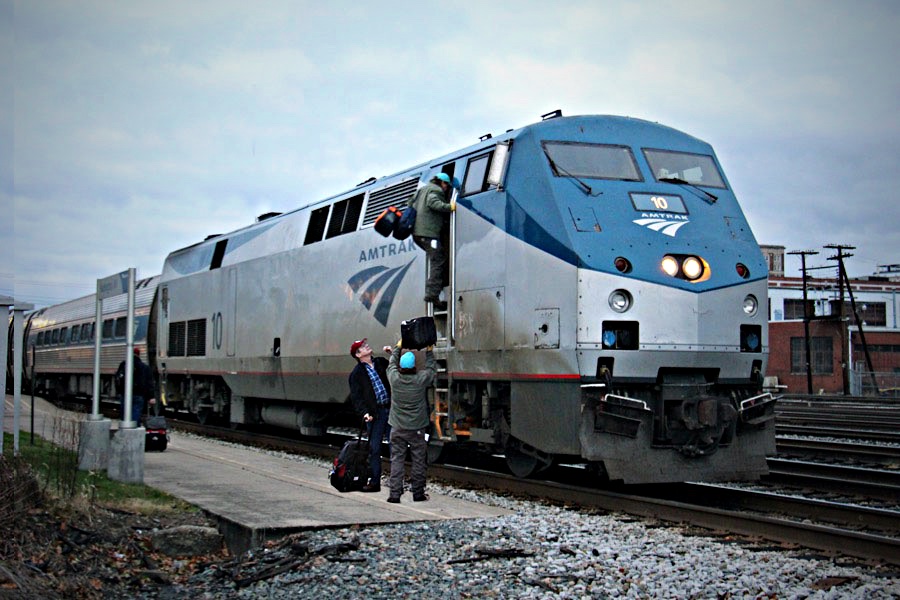
Changing of the Guards
Huntington, WV / Dec 2017 / RWH
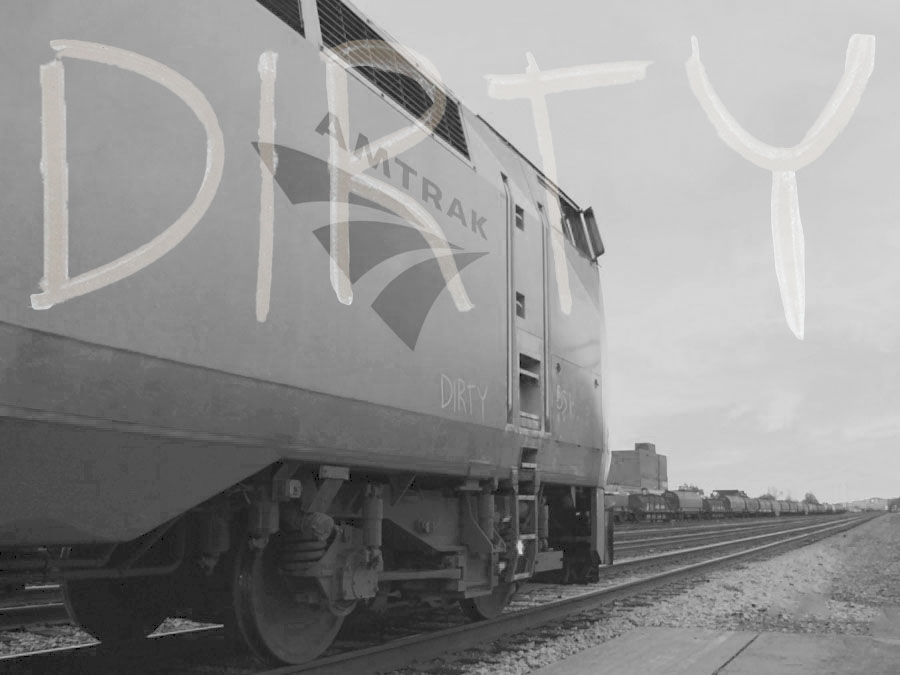
Wash Away All My Sins
Huntington, WV / Dec 2017 / RWH
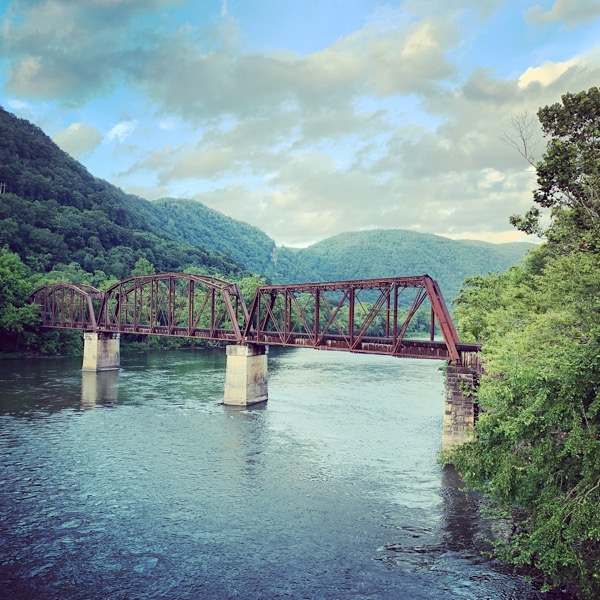
A New River Moment
Jul 2020 / RWH
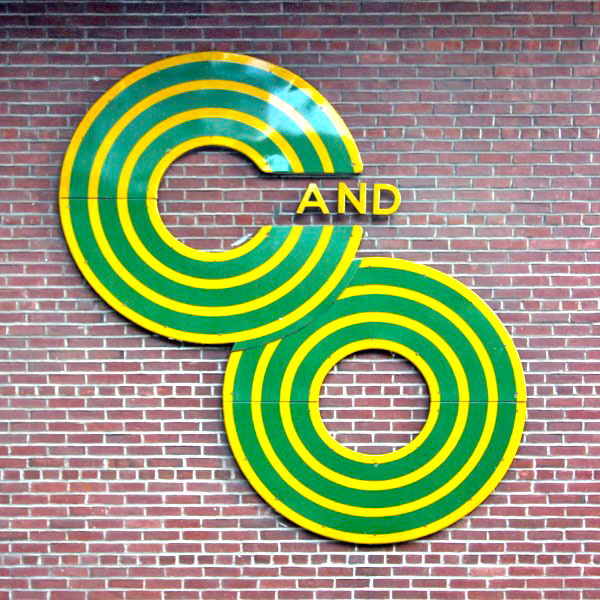
Chessie Circles
Jul 2020 / RWH
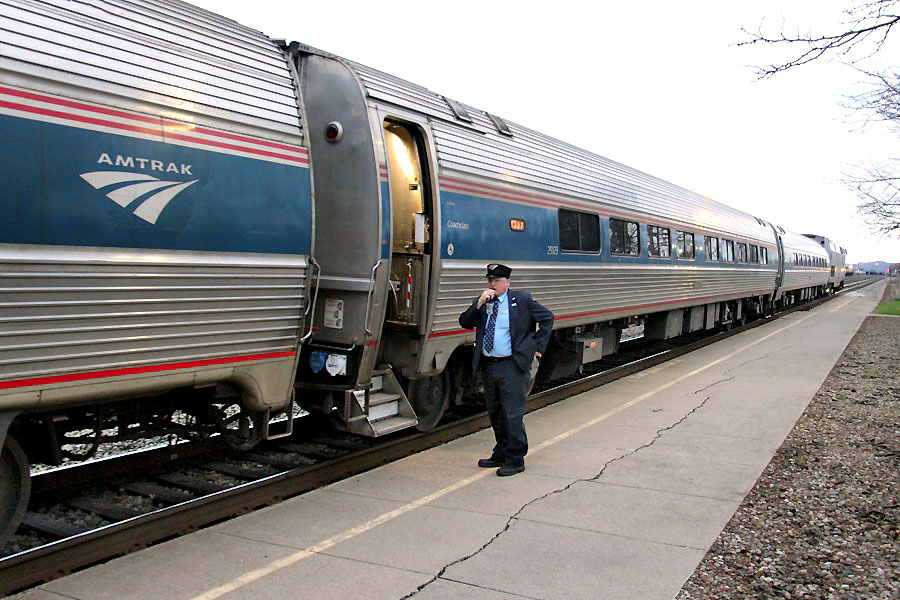
"Station work done. Highball Fifty."
Huntington, WV / Dec 2017 / RWH
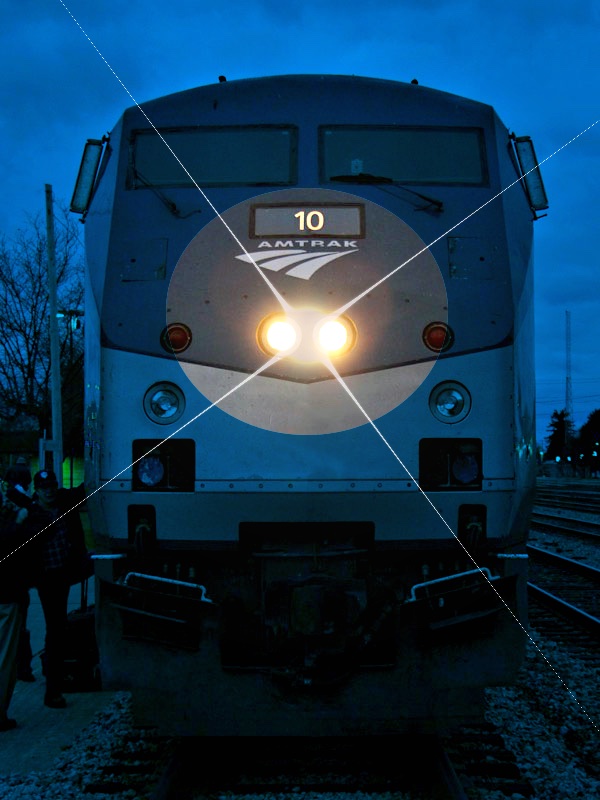
Genesis: "Let there be light"
Dec 2017 / image and artwork RWH
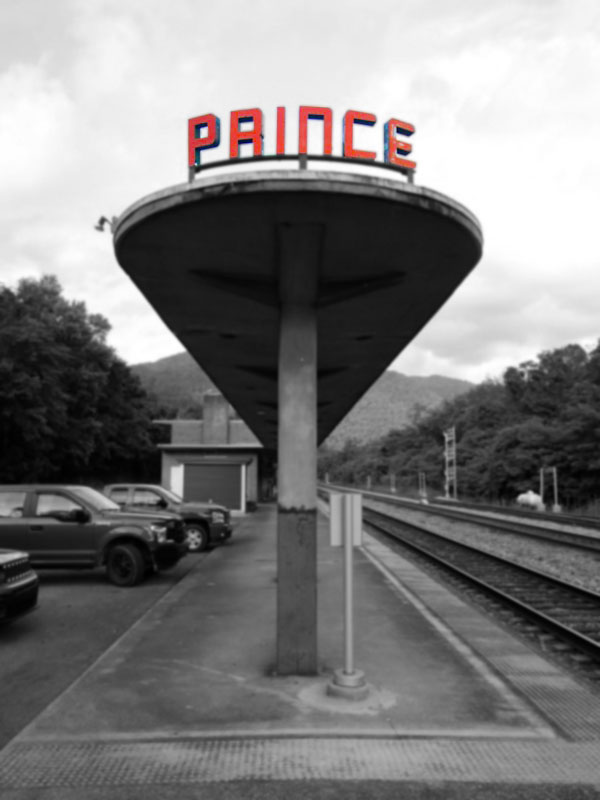
The Platform at Prince
Jul 2020 / RWH
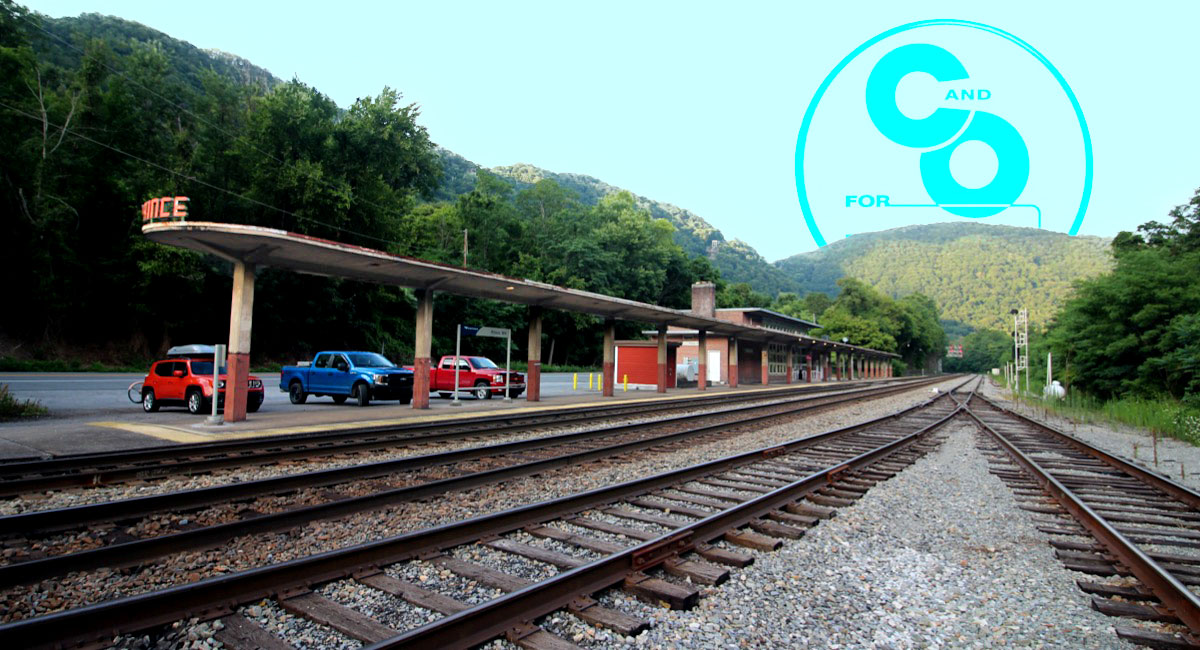
The Future Belongs to Robert Young
Prince, WV / Jul 2020 / RWH
 Snapshots
Snapshots

Huntington, WV / Dec 2017 / RWH

White Sulphur Springs, WV / Jun 2022 / RWH
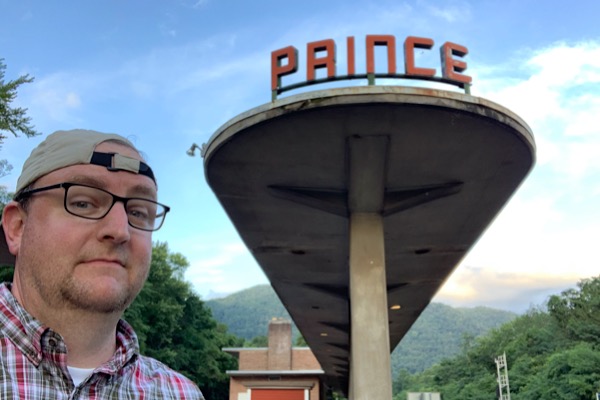
Prince, WV / Jul 2020 / RWH
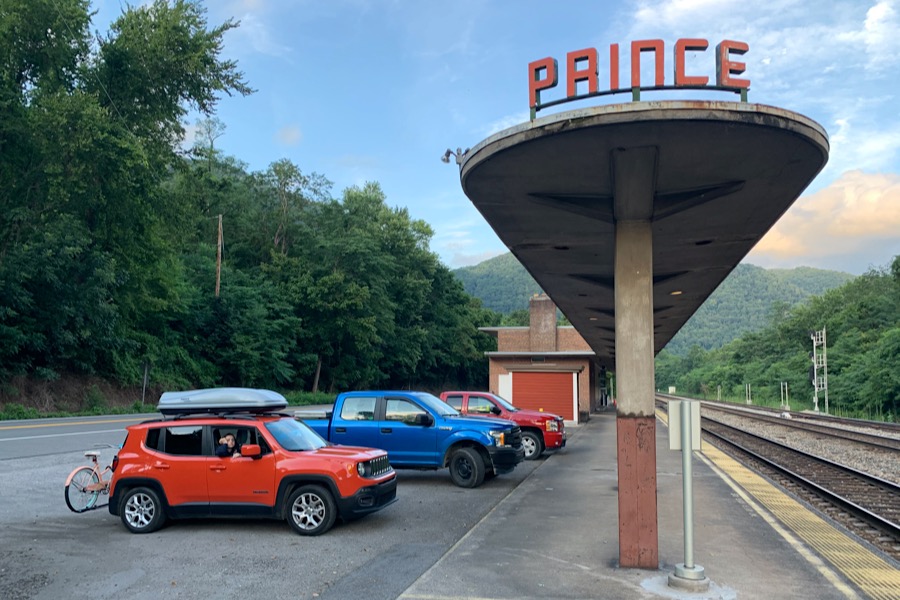
Prince, WV / Jul 2020 / RWH
Links / Sources
- Amtrak's Cardinal page
- Wikipedia page for Cardinal route
- TrainWeb.org Cardinal page
